An International Tour organised in conjunction with our friends at Oriole Birding, our regular spring visit to Romania, to the Danube Delta and the neighbouring region of Dobrogea and the Black Sea Coast.
We plan to run this tour again in 2025, on 27th May to 3rd June, so if you like what you read, please get in touch. You can see details of next year’s tour here.
Tuesday 28th May
It was an early start this morning. We met at the Ryanair check-in at Stansted Airport at 4.20am for our 6.20am flight to Bucharest. By the time everyone was finally accounted for and we had negotiated our way through security it was almost time to begin boarding. The flight itself was uneventful, we left on time and arrived as scheduled at 11.25am local time. It was quite a long walk through the terminal to get to baggage reclaim and our bags were already going round on the carousel by the time we got there. Our local guide, Cristian, was waiting for us in the arrivals hall and as we walked outside a Barn Swallow swooped into its nest on the front of the terminal, our first bird of the trip. Our air-conditioned minibus picked us up in front of the car park for the long drive to Tulcea.
The traffic was quite bad and it took us some time to escape from the clutches of Bucharest. There were few birds to see at first beyond a few Feral Pigeons, Woodpigeons, Collared Doves, Starlings and House Sparrows and as we finally got out into the open countryside beyond we saw more Rooks and Jackdaws in the fields. As we passed through a small town, our first White Stork of the day was on its nest right next to the road. After a couple of hours, we stopped for a break at a local filling station and a chance to grab a coffee and something to eat. A couple of Goldfinches flew past, we could hear Greenfinches calling, a White Wagtail landed on a lamp post in the car park and a Grey Heron flew over.
It was warm but quite cloudy today and as we drove on, there were a few light showers which briefly required the windscreen wipers on the bus. There were more birds too – a couple of Rollers on the wires, a few Kestrels and our first Red-footed Falcon. As we approached the Danube bridge, we saw several Cuckoos on the wires and several more White Storks in the fields and more on their nests in the village beyond with the heads of the growing juveniles just visible. There has not been much rain this year and the fields here were noticeably drier, with just a couple of Little Egrets feeding in one of the few pools.
We had planned to make our usual first birding stop at a lake further on but as we approached the clouds got progressively darker and it started to rain. We stopped at a conveniently placed filling station for a quick comfort break as the rain hammered down on the roof over the forecourt and it looked like we would be unable to stop at the lake – either we would get very wet in the rain or the bus might get stuck in the mud. As we drove on Cristian started to make alternative plans but miraculously only a couple of hundred metres further on we drove out of the rain and the road ahead was bone dry. Back to plan A.
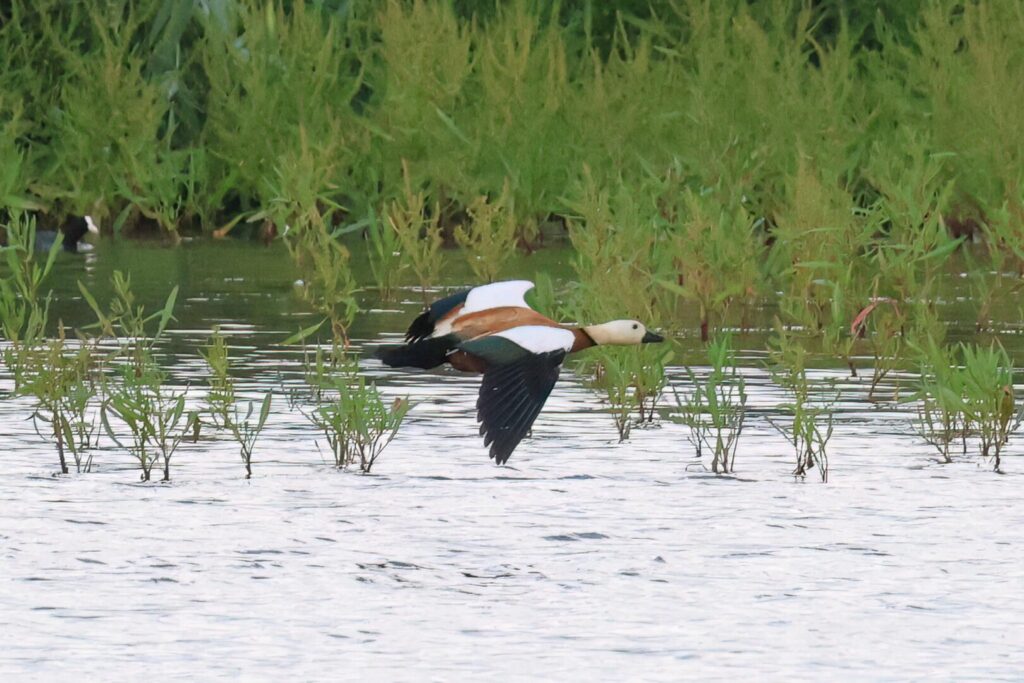
As we got out of the minibus, a male Ruddy Shelduck was feeding in the vegetation along the front margin of the lake. After a while, the female appeared much further over to the left with six half grown shelducklings in tow. The male flew over to join the family and chased off first a drake Garganey which was nearby and then a couple of Shovelers in a show of bravado. Parental duties duly completed he flew off back to feed on his own where he had been when we first saw him.
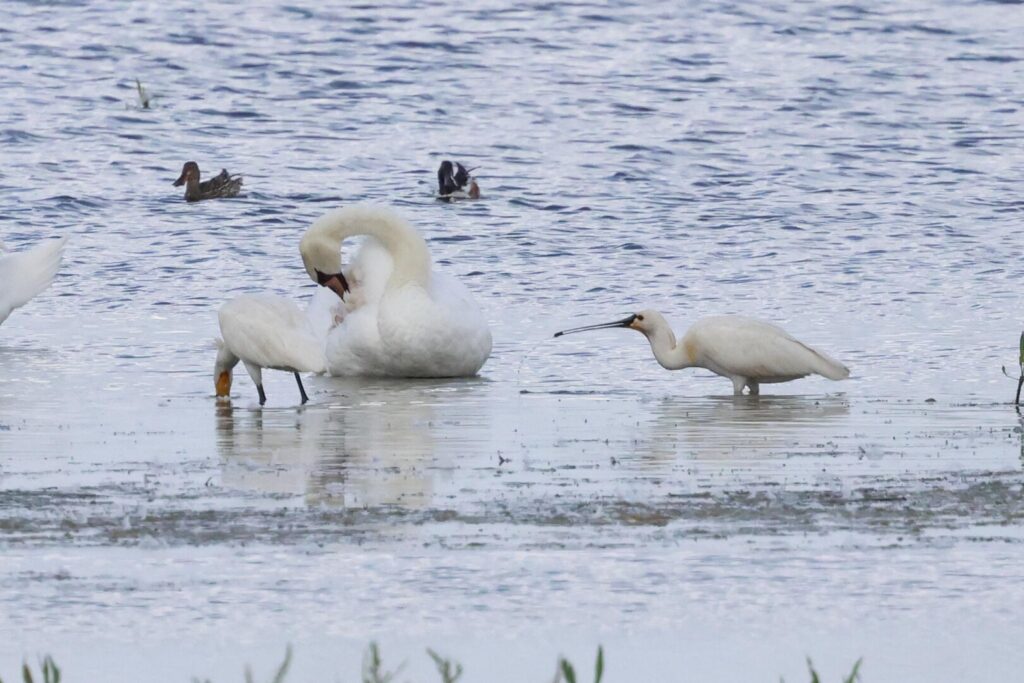
There were birds everywhere here and we didn’t quite know where to look now. There were quite a lot of Common Pochard on the lake and scanning we found first a pair of Red-crested Pochard on the edge of the reeds and then a group of four Ferruginous Ducks which flew in. Four Spoonbills were feeding in between a group of sleeping Mute Swans, a Great White Egret was stalking the low reeds and several pairs of Black-winged Stilts and a couple of Lapwings were in the shallow water at the front.
The clumps of taller reeds out in the water were chock full of Pygmy Cormorants. A few Whiskered Terns were hawking up and down over the water and more were settled on the small islands and in the shallows, which were flushed by a passing Marsh Harrier along with a small group of Black-headed Gulls and a single Caspian Gull.
The star of the show this time was a male Red-footed Falcon. It was hovering out over the grass in front of the lake, rather distantly at first. It flew round behind us and way low over the fields and we forgot about it until it suddenly reappeared almost right over our heads, hovered and then dropped down into the grass right in front of us. A female Red-footed Falcon circled over much higher too, along with a couple of Kestrels.
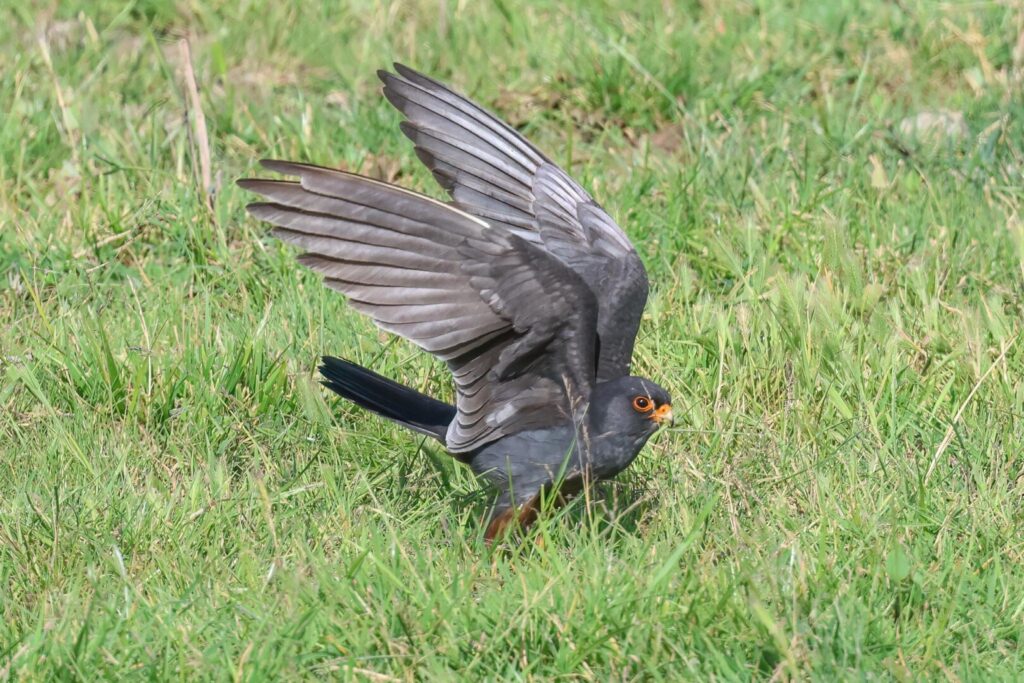
We heard Bee-eaters calling and turned to see one perched on a dead twig distantly in the fields behind us and then we heard a Hoopoe which flew out of the bushes and across in front of us. Another Cuckoo flew past. We could hear Great Reed Warblers and a Cetti’s Warbler singing in the reeds, Golden Oriole fluting from the trees beyond and a Nightingale singing in the bushes in the distance.
From time to time, we had heard Yellow Wagtails calling and now we picked up a couple dropping down into the edge of the reeds, both male Black-headed Wagtails. We had to tear ourselves away as we still had another hour’s drive ahead of us and just as we were getting into the minibus, a Dalmatian Pelican flew in and circled out over the middle of the lake.
The rest of the journey to Tulcea was fairly uneventful. We were welcomed at the guest house with biscuits and a glass of local sour cherry schnapps while we sorted out the room allocation. Then there was time for a short break before dinner.
Wednesday 29th May
After breakfast, we headed out in the minibus this morning. The forecast was for rain, so we had brought our waterproofs, but we wanted to make the most of the bright weather while it lasted. Our first stop was at Babadag Forest, where we planned to explore the open wooded hills bordering the steppe on the far side. As we got out, a pair of Crested Larks were on the track ahead of us and showed nicely, one perching on a post quite close to us at one point, and a Corn Bunting was singing nearby. Scanning the open steppe, we quickly located a few Isabelline Wheatears, which we got in the scopes. In the distance we picked up a Turtle Dove on some wires, then a couple more flew past us a bit closer.
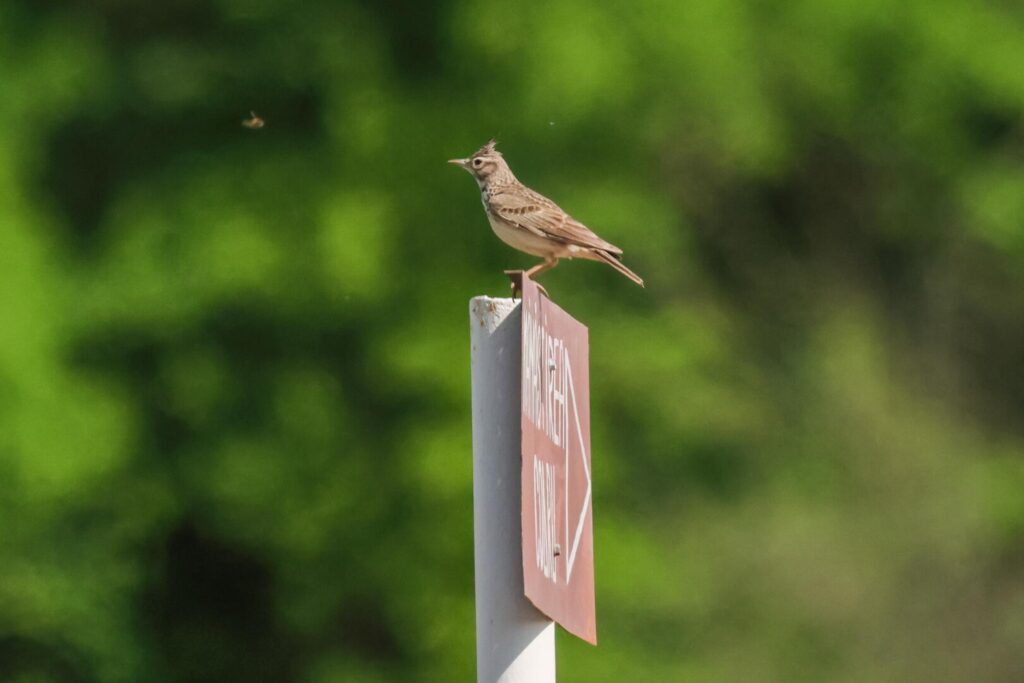
A Long-legged Buzzard was perched on a small dead tree out in the grass and kept dropping down to the ground, before it eventually took off and flew away from us, so we got a better view of its plain pale tail and paler head. Another raptor was already high up over the forest, being mobbed by a Kestrel and when we got it in the scope we could see it was a Steppe Buzzard. A second Steppe Buzzard then appeared closer to us just over the trees briefly. As we started to walk off up the track, one of the group spotted what we initially assumed would be the first Steppe Buzzard very high in the clouds but on closer inspection it turned out to be a Honey Buzzard this time.
Through the bushes, we picked up a distant male Red-backed Shrike on the top of a bush, though it was face on to us and hard to see its red back, and a closer Woodlark. We heard Tawny Pipit calling and after a while it flew up into a small dead tree on the slope above us. A smart male Northern Wheatear appeared on the top of a tree too and we could see a pair of Spanish Sparrows in the bushes, the male chasing after the female displaying. Then we heard an Ortolan Bunting singing and after a bit of moving round and scanning we found it perched on a dead branch in the top of a tree, a smart male.
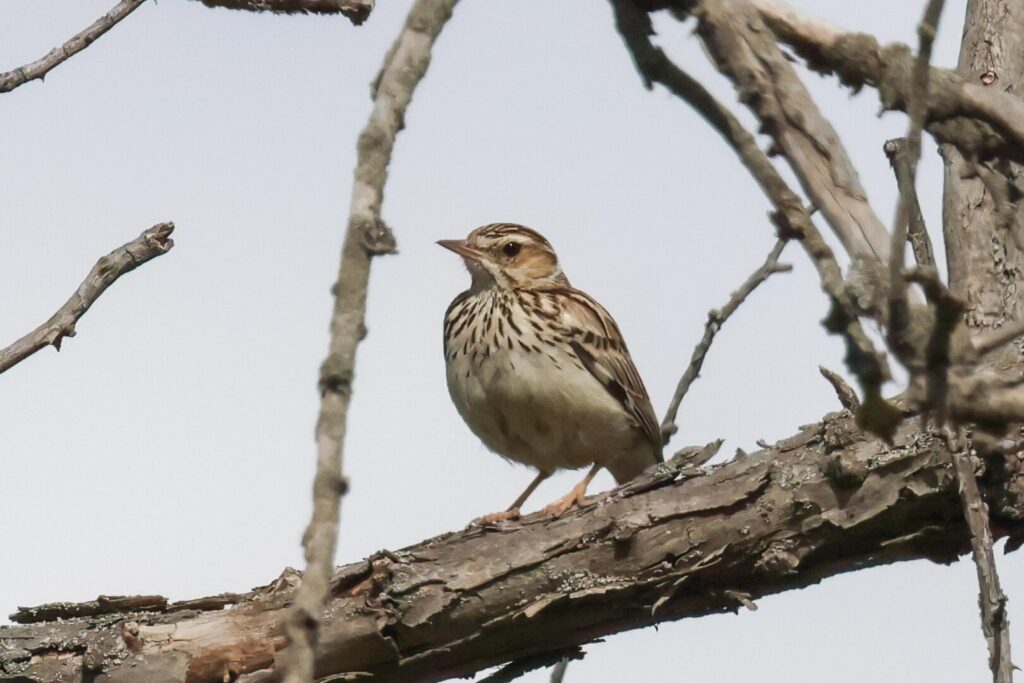
There were lots of other things to look at here too. Butterflies were well represented, with a nice selection of fritillaries, including Cardinal, Niobe and Queen of Spain Fritillary, blues including Silver-studded, Adonis and Common Blue, a smart Ilex Hairstreak and lots of whites, the only ones of which stopped were Eastern Bath White. There were lots of dragonflies too, mostly Lesser Emperor but we picked out at least one Green-eyed (Norfolk) Hawker too. Beetles included a few wasp beetles and a selection of chafers and some nice Pyramidal Orchids were in bloom in the grass.
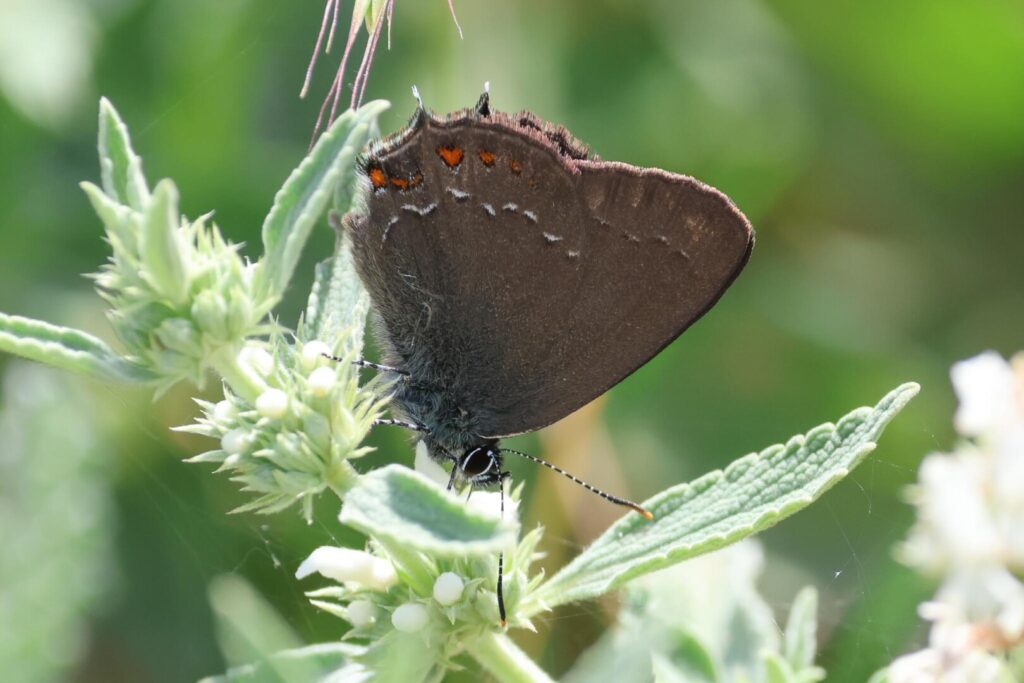
Another Red-backed Shrike was singing from the top of a dead pine tree above the track, which we got in the scope and could see its red back this time. We could hear Golden Orioles fluting and cat-calling from the trees too but they remained typically well hidden. On the way back down, a Chaffinch was singing nearby and the Ortolan Bunting had now moved and was singing closer to the path so we stopped again for another look.
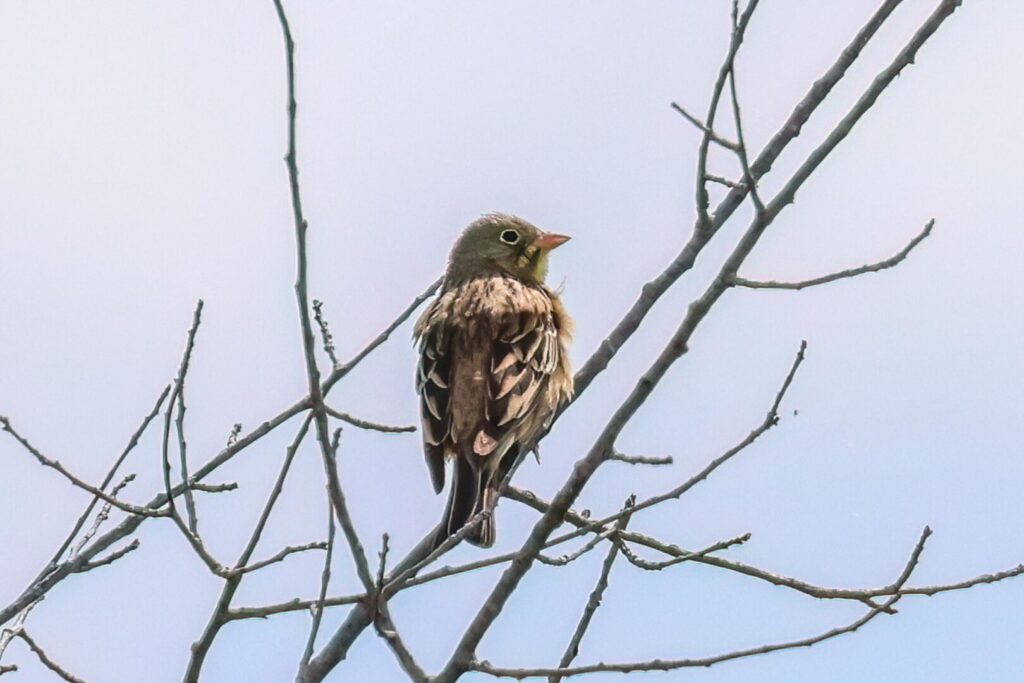
Back in the minibus, we stopped for a quick break at a filling station to use the facilities. There were a few House Martins over some nearby industrial buildings and a Skylark singing from the fields. A Small White butterfly was fluttering round the thistles and a rather smart pink Pease Blossom moth fluttered through the grass at our feet.
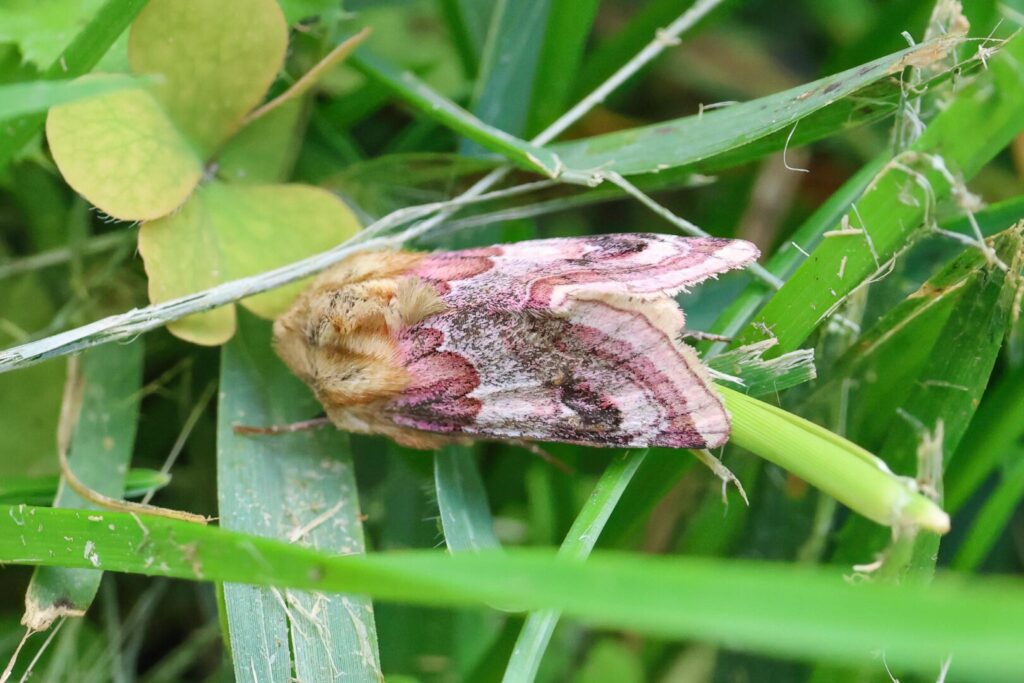
We still had quite a long drive down to Vadu, where we would spend the afternoon, so we broke the journey with an early lunch stop at a shady clearing with a small shrine and some benches on the edge of some trees. A male Spanish Sparrow was on the ground in the parking area as we pulled up but it flew off and then proceeded to make itself very elusive. There were lots of female sparrows coming and going from the roof of the shrine where they were nesting, most of which were Spanish Sparrows, but the only males we saw now were one or two House Sparrows.
Bizarrely for the middle of an agricultural area, a Reed Warbler was singing in the trees behind the shrine – not what we would have expected to find here and maybe a bird just passing through. We could see dark clouds and hear thunder away to the north, but thankfully it was going away from us.
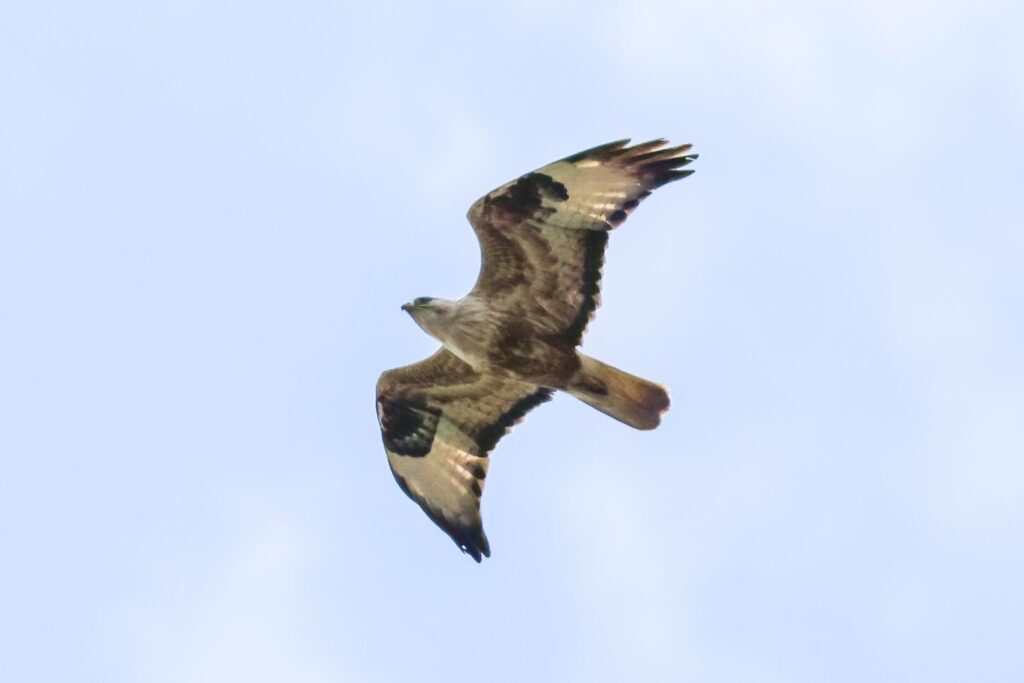
As the food was served, we picked up a Dalmatian Pelican circling in the sky the other side of the road along with a Long-legged Buzzard and a Marsh Harrier, but no one wanted to be distracted from their lunch now! The Long-legged Buzzard broke off from circling and headed towards us in a long glide, eventually passing over the trees above us. A couple of Red-footed Falcons hung in the air too. After lunch, and when we had regained everyone’s attention, we turned our focus back to the sparrows and it didn’t take too long to pick out a male Spanish Sparrow which flew up into the trees now. We watched it fluttering its wings displaying, with food in its bill.
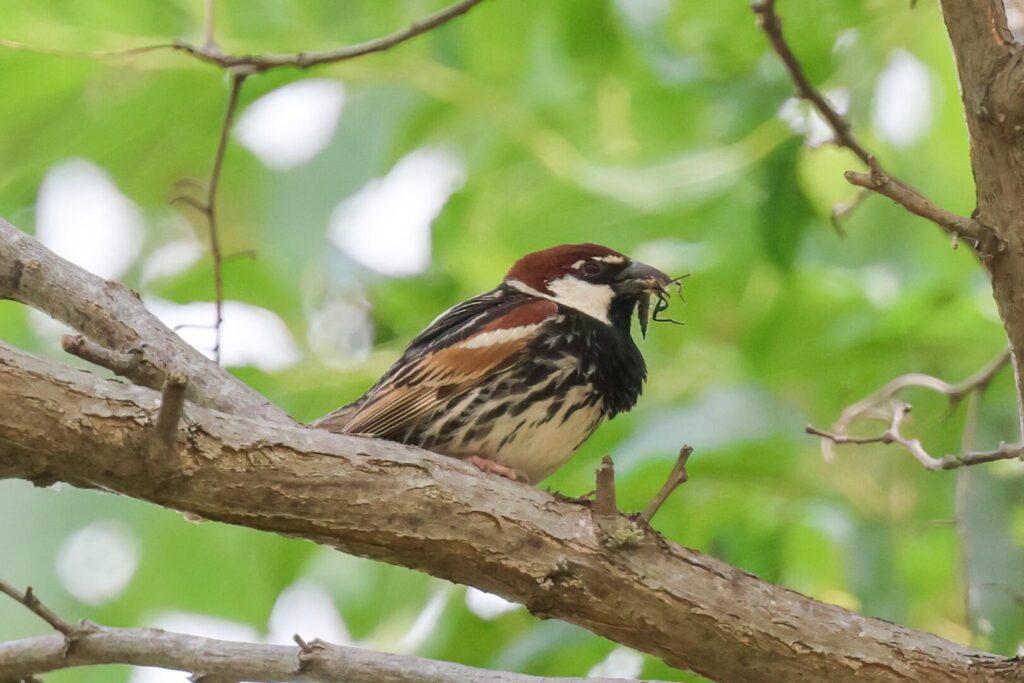
After we had packed everything away, we drove on down to Vadu. We stopped just before the village, on the top of the hill, and got out of the minibus. There were lots of Bee-eaters flying in and out of a sandy cliff face just below us and we watched as they swooped in and out of their nest holes, perching on nearby trees and wires. Several were carrying dragonflies in their bills.
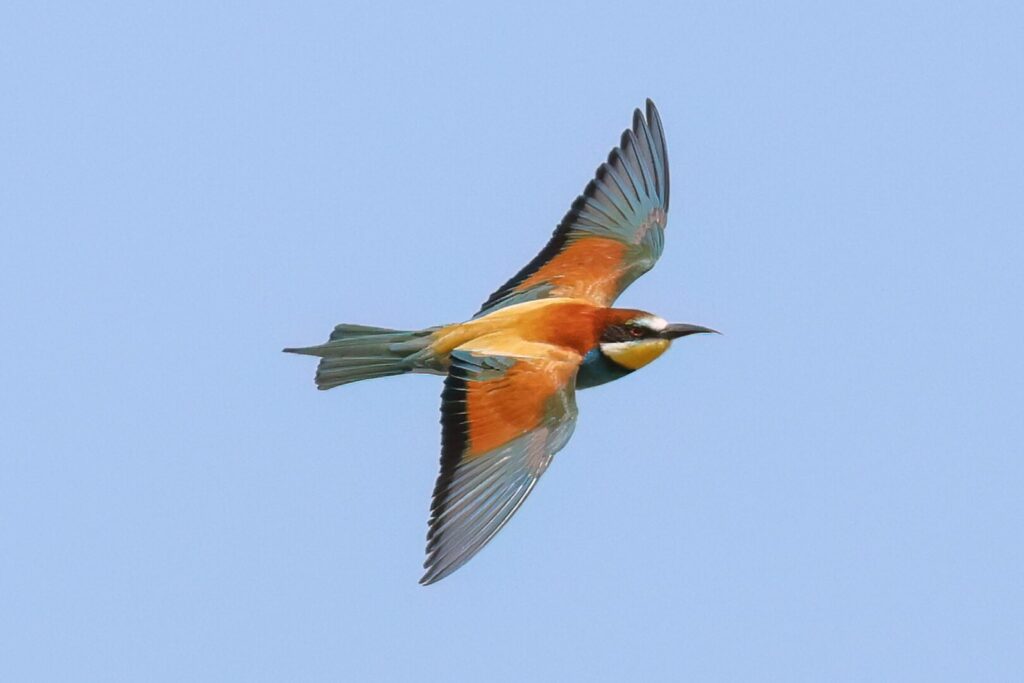
Cristian then picked up a Rose-coloured Starling in with a flock of Common Starlings over the edge of the village. They were distant at first, and disappeared over the trees, but then a smaller part of the flock flew back out and straight towards us, coming directly overhead and we could see the (a?) Rose-coloured Starling in with them. They continued off behind us before turning and coming back, a small number of the birds then landing on the wires in front of us, one of which was the pink one. We had some lovely views of it now through the scope. Later, when the flock of starlings all coalesced into one again, we could see there were actually at least three different Rose-coloured Starlings in with the Common Starlings here.
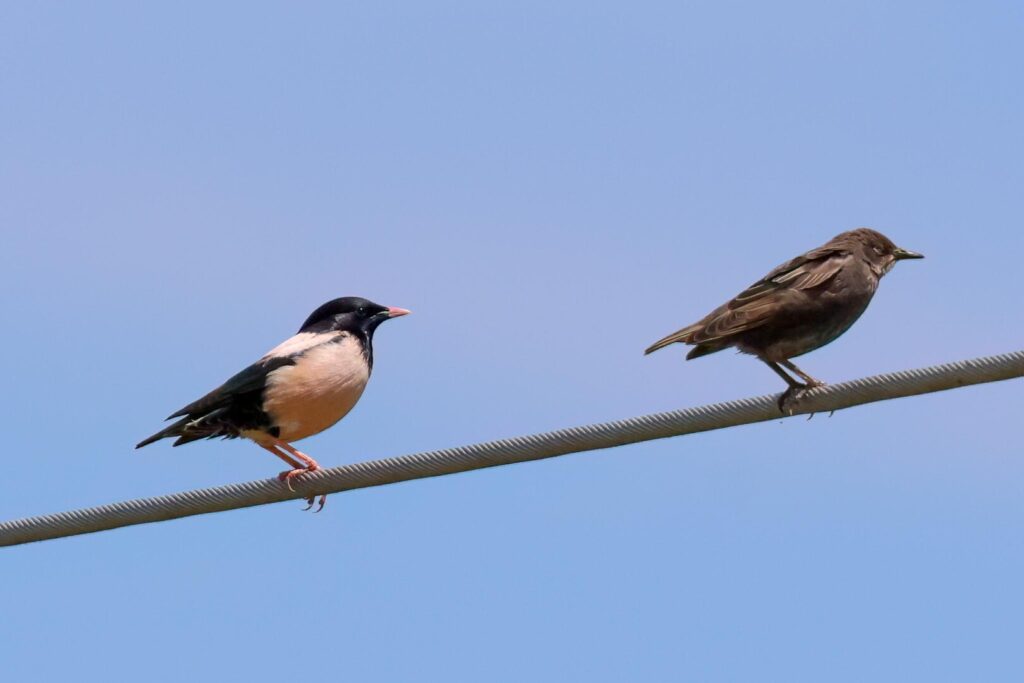
Down around the pools below us, there were so many birds here we didn’t know where to look first. Several Squacco Herons flew up from time to time from the pools below us, flashing their white wings, and we got one which landed on the edge of the water in the scope. A Little Bittern flew over from behind us and dropped down into the reeds around the pools, followed by a Black-crowned Night Heron.
A Glossy Ibis was feeding in the wet vegetation, there were ducks including a drake Garganey and a few Ferruginous Ducks, Black-winged Stilts, several Wood Sandpipers and a single male Ruff. A couple of Yellow-legged Gulls dropped in.
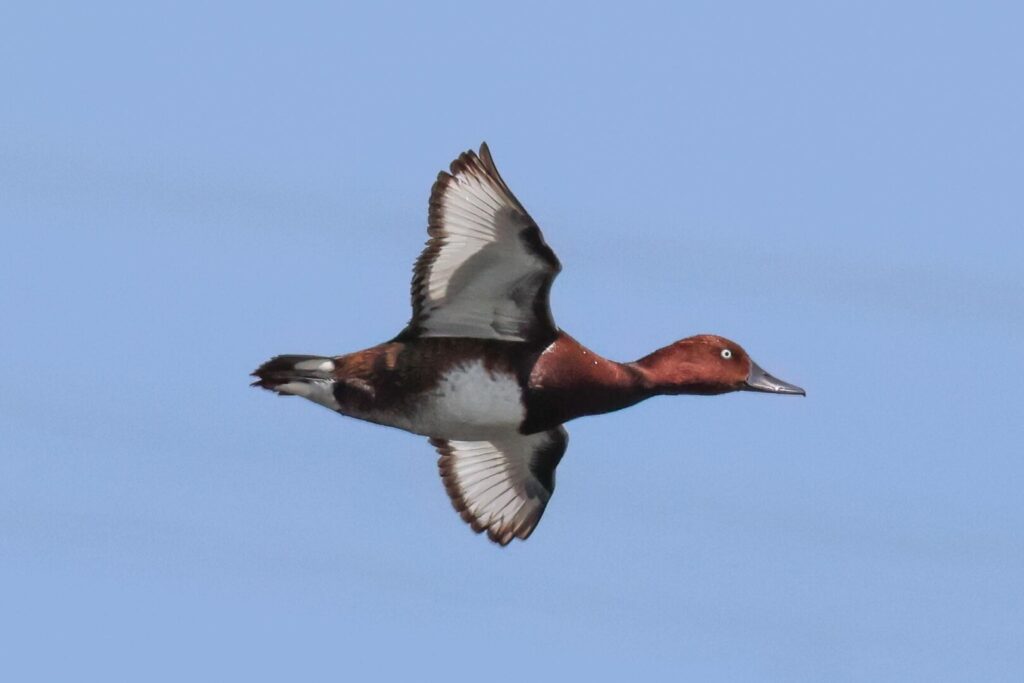
The larger, deeper pool further back held a large raft of Common Pochard, a few Black-necked Grebes and five or six Little Gulls were flying round and dip-feeding, mostly 1st summer birds. A Cuckoo was calling in the trees behind us and then flew past too and several Red-footed Falcons hawked back and forth overhead.
The wind had picked up quite a bit this afternoon and it was much cooler now when the sun went behind the clouds, but thankfully it was still staying dry. We walked down the track to get a closer look around the pools and found a single Cattle Egret on the edge of the water, a scarce bird here. Another couple of Night Herons flew over and a Purple Heron flew across over the reeds further back.
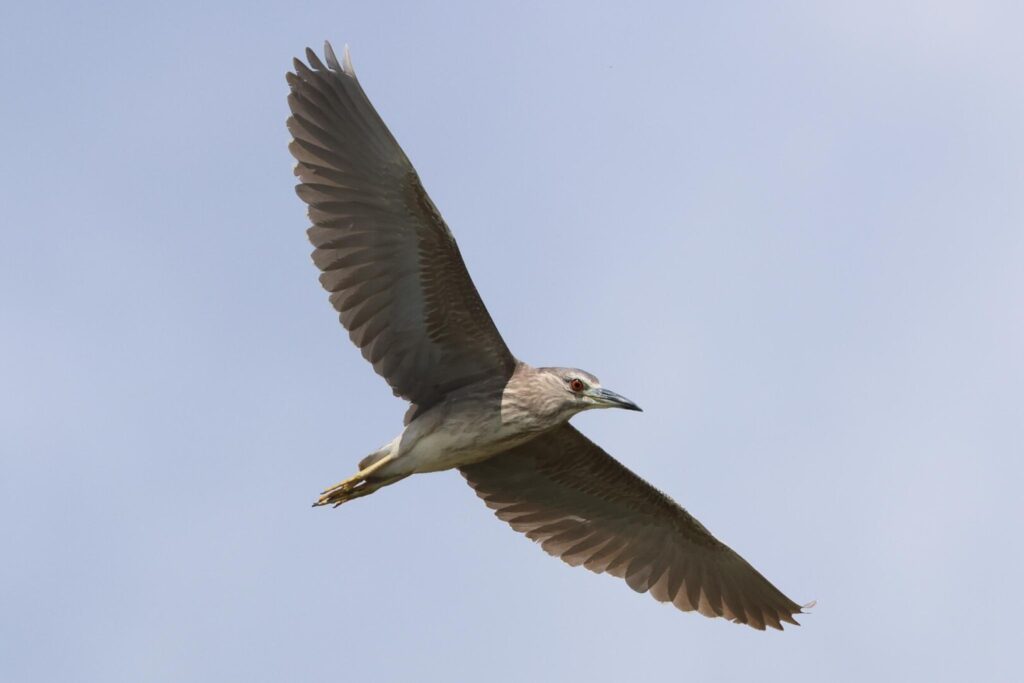
We scanned the muddy margins of the first pools and found more waders now – several Wood Sandpipers, a second Ruff, this time a female, and a group of four diminutive Little Stints in rusty breeding plumage. As we walked on round, we flushed one or two Yellow Wagtails but none stayed for closer inspection.
Cutting across the drier ground back towards the road, there were several male Northern Wheatears and a single spotty juvenile. Scanning the ruins of the old soviet-era factory beyond we picked up a male Levant Sparrowhawk flying between the buildings flushing all the starlings but unfortunately not all the group were able to get on it before it disappeared behind a large concrete blockhouse and as everyone focused on the far side where we expected it to come out, it failed to reappear. It must have sneaked out the back.
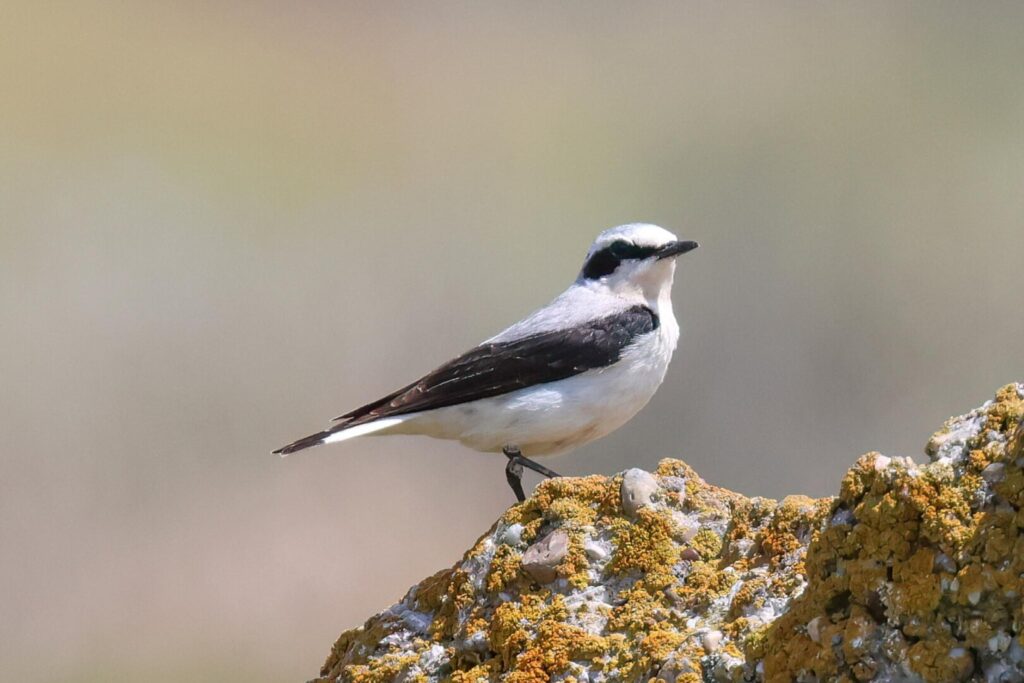
Walking on down the road, we could see a couple of Collared Pratincoles in the distance. The smaller pools added a few Common Redshanks, with a pair of Shelduck and a Lapwing. We were hoping to be able to find Paddyfield Warbler here but the reeds were being buffeted by the wind so they were likely keeping tucked down. All we could hear were a few Reed Warblers and a Great Reed Warbler singing and we only had a few brief glimpses of unidentified Acrocephalus warblers flying up out of the reeds. A couple of Bearded Tits flew up briefly and a smart male Red-backed Shrike did perch nicely on a dead tree by the road at one point.
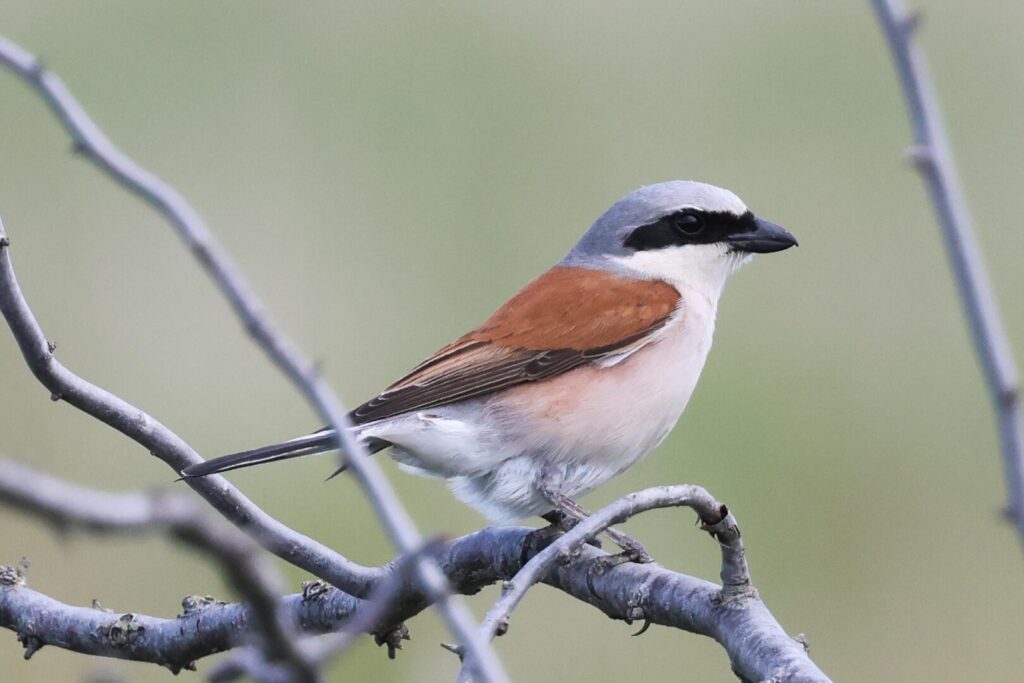
From the raised bridges we stopped to scan the larger more open pool beyond the reeds. We counted at least sixteen Ruddy Shelduck here, a pair of Red-crested Pochard and lots of Garganey which were mostly hiding in the grass beyond the water. There were more Ruff, at least four of them, three Avocets and a single Little Ringed Plover. Several Collared Pratincoles were in the short grass and we got three of them in the scope for a closer look.
Walking on, there were just a couple more Reed Warblers singing in the reeds by the road and we walked up onto the bank to view the next pool. Lots of Common Terns were nesting on the big island and there were a few Black-headed Gulls and a small group of 1st summer Little Gulls all loafing in the water in front, but nothing else on here today. Several Great Cormorants flew up out of the pools the other side of the road and a few Red-footed Falcons were hunting low back and forth over the reeds
The minibus had driven to meet us here and now took us on down to the edge of the Black Sea. There were some threatening dark clouds approaching from the south and it started to spit with rain just as we arrived but we donned our waterproofs and braved it. Thankfully the rain never came to anything and the dark clouds passed to the west of us. We walked up onto the edge of the beach and had a quick look out to sea but apart from Common Terns fishing offshore and a few large gulls we couldn’t see anything different today. A Redshank was feeding along the tideline further up and a Little Ringed Plover ran down the beach towards us.
We had a long drive back from here and we wanted to make a couple of quick stops on the way, so we decided to head back. We stopped in the village for an ice cream and a chance to use the facilities. There were lots of House Sparrows around the gardens and we found a couple of Tree Sparrows in with them too. Driving back inland, Cristian noticed a Whinchat perched on the wheat in a field by the road. We pulled up for a look, but typically were just trying to get everyone onto it when several other vehicles then appeared and we had to move over. When we reversed back again it had disappeared.
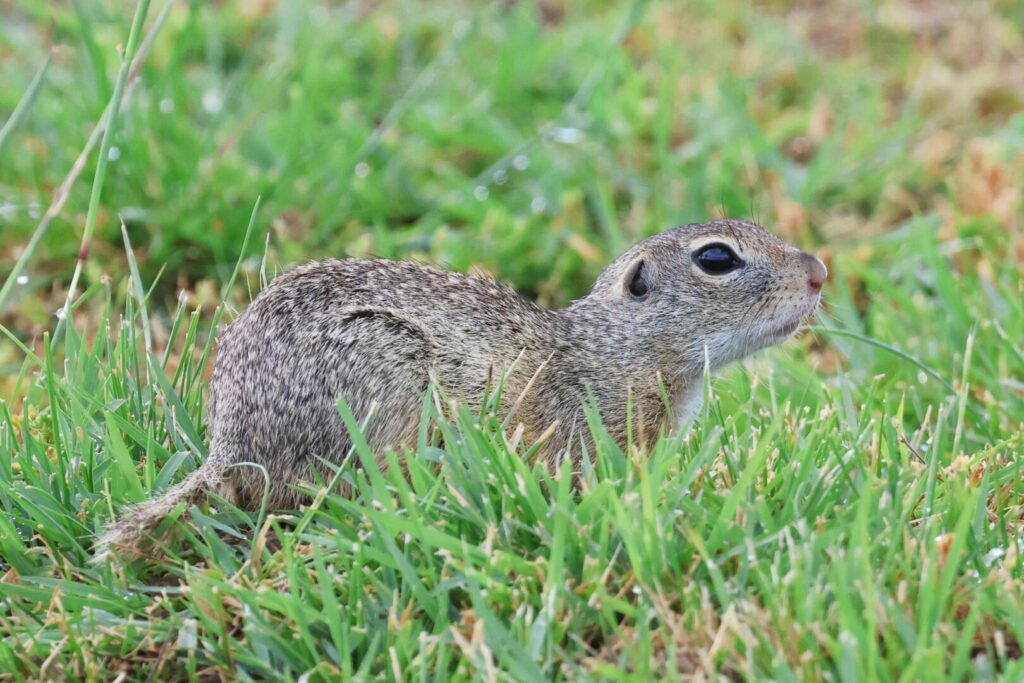
About an hour further on, we stopped at a filling station where there are usually lots of Susliks in the small area of short grass on one side. We could only find one today, but it had obviously been raining here earlier. A spotty juvenile Northern Wheatear was on the tiny patch of grass here too, a slightly incongruous place for this species to have bred. It was another hour’s drive from here back to Tulcea and again we saw some very dark clouds on the way. We had been very lucky with the weather today.
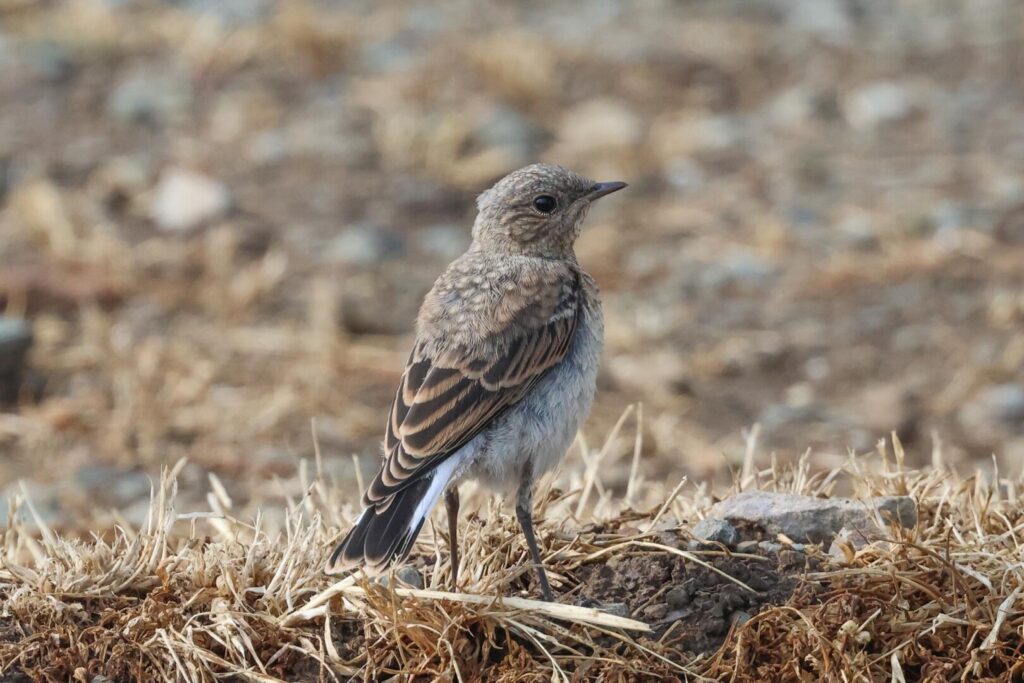
Thursday 30th May – cloudy morning with early drizzle, bright & sunny later pm 26C
It was very cloudy and spitting with drizzle as we went outside after breakfast. Thankfully the rain had stopped when we got to our first stop at an area of open woodland, even if it was still very grey. There were a few Tree Sparrows in the trees and a couple of Bee-eaters flying up hawking for insects and perched in the dead branches in the tops. We found our first Lesser Grey Shrike of the trip which we got in the scope and we could hear Ortolan Bunting and Woodlark singing distantly. More oddly, we could hear Whiskered Terns calling and saw one or two flying distantly over the fields on the other side of the valley, presumably commuting to or from somewhere.
As we walked slowly along the track through the trees we at last had a chance to get a Roller or two in the scope, rather than seeing them on the wires as we drove past in the minibus. A Hoopoe kept flying in and out carrying food from the base of the trunk of a particular tree, where it presumably had a nest. Another shrike flew up into a tree and we were surprised to see it was a Woodchat Shrike, a rather scarce species here.
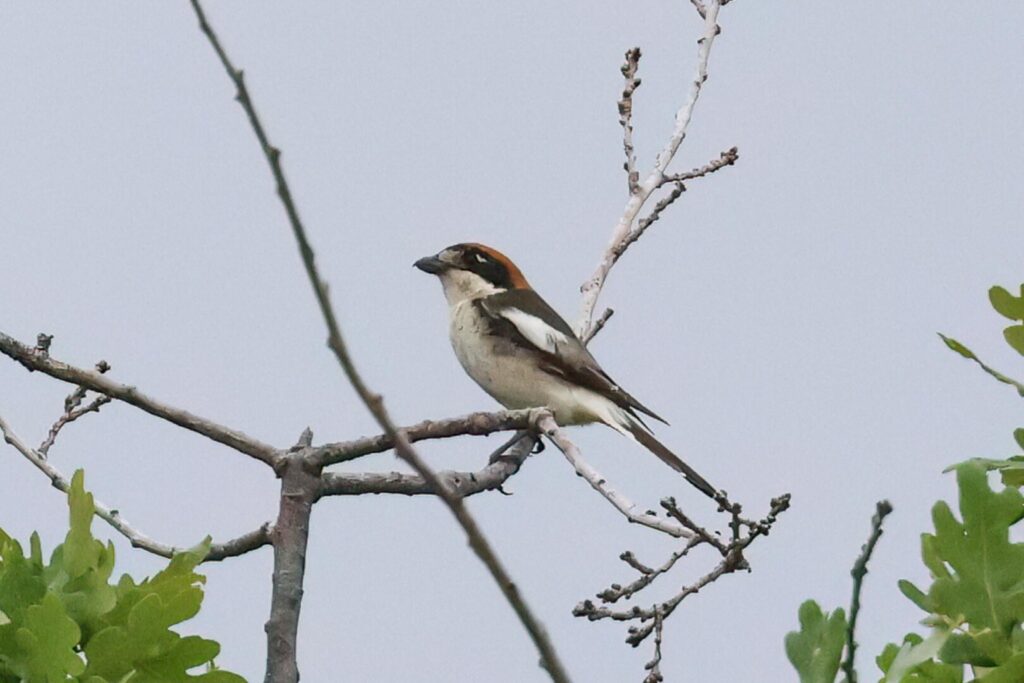
We heard a Green Woodpecker yaffle once or twice further up the slope, then further on we heard another calling quietly and could see a female perched on a dead branch on the top of a tree below us. A couple of Eurasian Jays flew through the trees.
Lots of butterflies and moths flew up from the short grass at our feet – including Small Heath, Green-underside and Silver-studded Blue, several Spotted Sulphur and lots of Diamond-back Moths. The minibus met us again further on, although a bit earlier than planned as apparently the driver was new and hadn’t understood where to wait, so we got on board and drove down to the last pull-in.
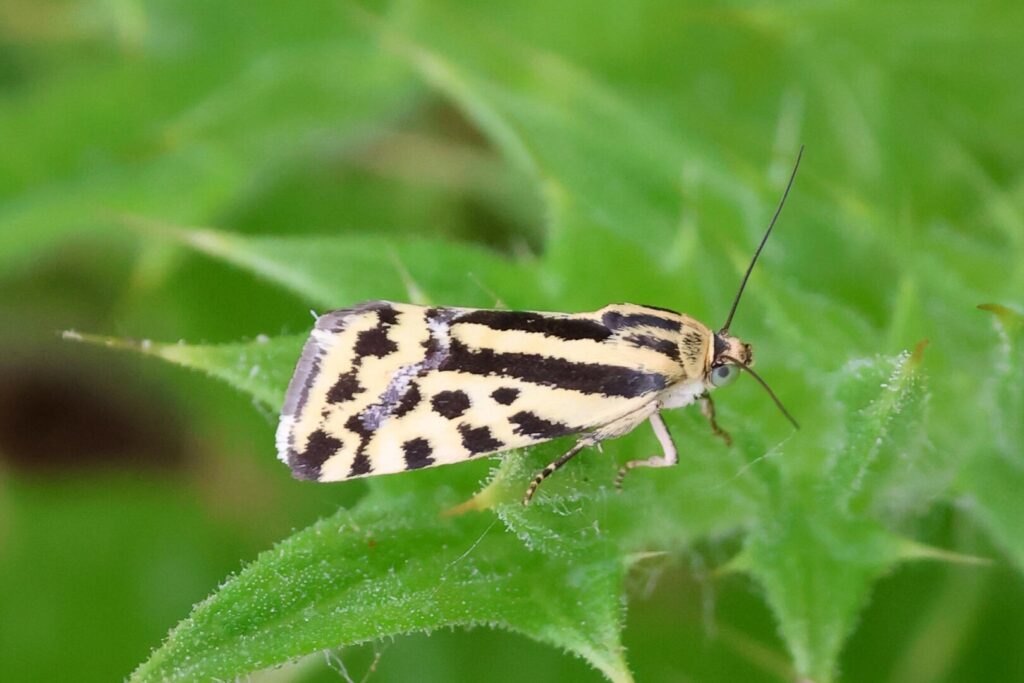
As we got out of the minibus again, another Lesser Grey Shrike was perched on a small bush just beyond before flying up into the trees nearby. Cristian led the group down underneath a bridge in the road to show us a Red-rumped Swallow nest and afterwards we picked up one of the adults flying round low over a flock of sheep feeding in the field behind.
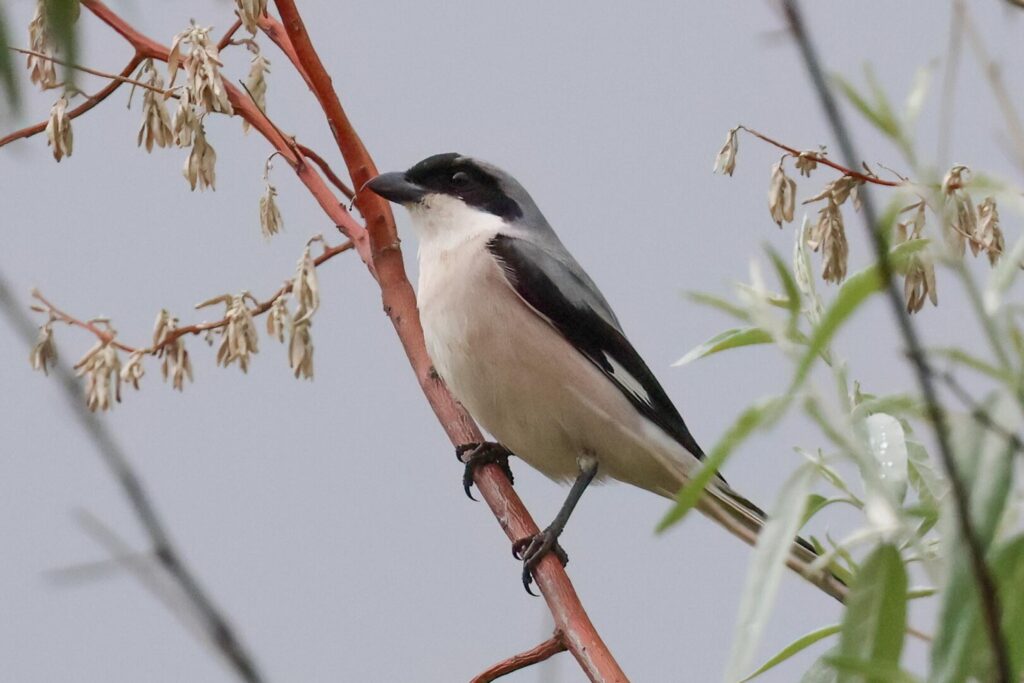
We had heard Golden Orioles fluting occasionally as we walked through the open woodland, but now we had several flight views of them here as they flew in and out of the trees and across the road. Even better, twice a stunning yellow male Golden Oriole landed in the top of the low trees just across the road and stayed perched in the open calling where we had some stunning views of it in the scopes. A couple of ‘Green Frogs’ were down in an open storm drain.
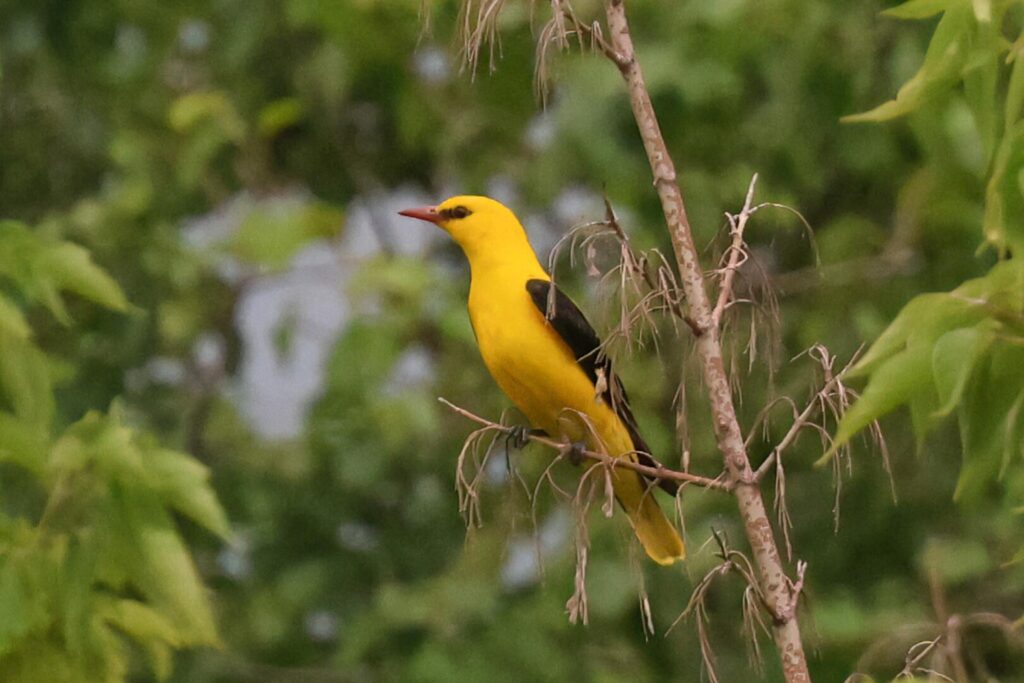
There were some very dark clouds approaching so we got back in the minibus for the short drive over to our next stop at Celic Dere. It started to rain on the way but thankfully by the time we had arrived it had stopped again. As we walked down from the car park, a Honey Buzzard was circling over the hillside opposite. It broke off into a glide and came across over the valley ahead of us and over the trees the other side, where a male Levant Sparrowhawk came up and had a quick go at it. Unfortunately , as it was a species we wanted to see here, it disappeared straight back into the trees.
A short while later we looked across and could make the Levant Sparrowhawk out perched distantly on a branch, preening, but frustratingly again only one of the group got to see it in the scope before it disappeared again. There were more raptors up now, even though it was still cloudy – a couple of Long-legged Buzzards and Steppe Buzzards, and a dark morph Booted Eagle circling in with them for a while.
We heard woodpeckers calling and first picked up a distant Grey-headed Woodpecker with a Great Spotted woodpecker next to it in some dead trees. A pair of Middle Spotted Woodpeckers flew in and landed in a small tree very close to us, the male raising its bright red crown feathers and feeding the female a couple of times as they worked their way up the trunk. Just beyond, an adult Great Spotted Woodpecker was feeding a juvenile on cherries in a cherry tree in the overgrown old orchard.
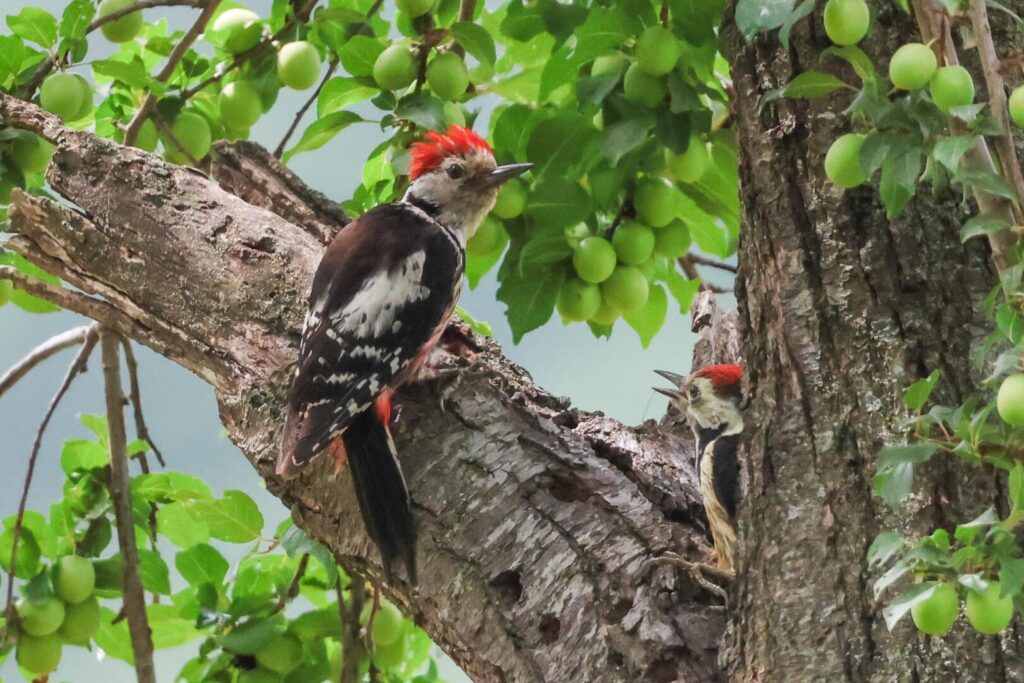
A male Red-backed Shrike landed on a bare branch right in front of us, but was partly obscured, and then a second male flew up and landed on another bare branch a bit further back and was perched side on in perfect light, so we got that one in the scope. Just beyond, we heard a couple of Icterine Warblers singing. At first all we could see was the movement as they flicked around actively in some very leafy trees but then one dropped out into a dead tree and perched beautifully in the open for us, great views of what can be a tricky species to see well.
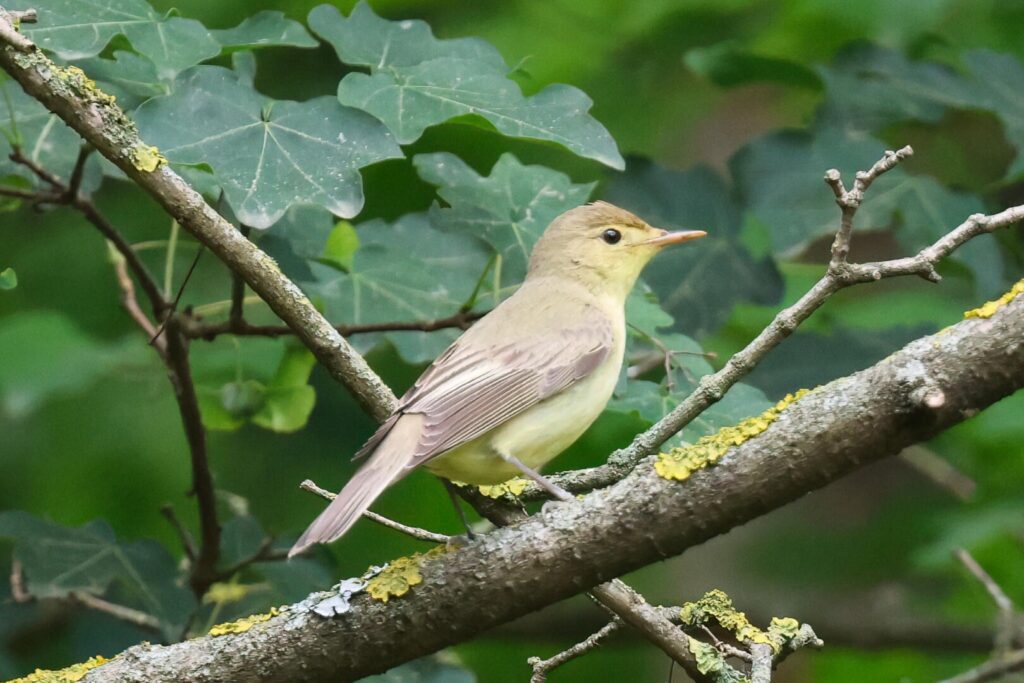
A Blackbird flew across the field as we took the path around the edge above the stream. Several Hawfinches flew back and forth too, and we eventually got good views of a juvenile perched in the open in the top of a tree. We could hear Blackcaps and Common Nightingale singing in the bushes in the bottom of the valley and a Nuthatch calling, and then we heard a Red-breasted Flycatcher singing in the trees the other side of the field.
At the far end, we cut across on the path and into the wood to see if we could find it. The first bird we picked up when we got into the trees was a Spotted Flycatcher, followed by a Robin and a few Chaffinches. Then we heard the Red-breasted Flycatcher again and had a brief view of it perched before in flew higher up.
We walked up the slope and onto the track through the wood from where we had a better vantage point and followed the Red-breasted Flycatcher until it worked its way down and started to sing from a bare branch just above the track. We had some great views of it now and it was particularly obliging, staying in the same place for some time, but we couldn’t but feel a slight pang of disappointment as it was a first summer male with no colour at all on its breast or even on its throat.
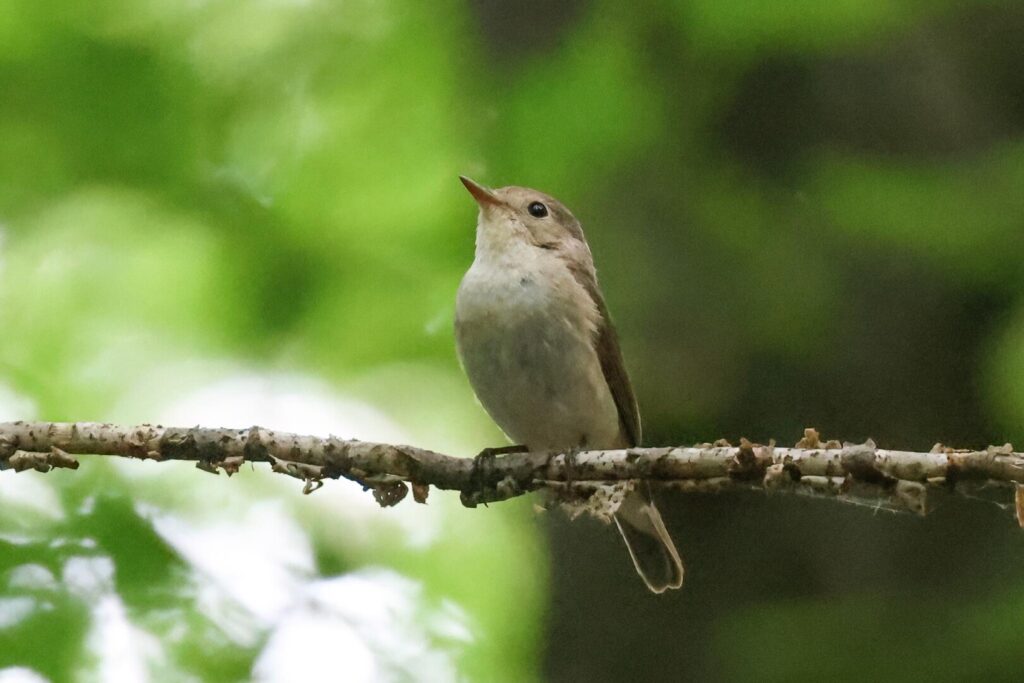
When it eventually moved off higher up the slope we started to walk slowly back along the track while Cristian went on ahead to find the minibus and set up the picnic table for lunch. We hadn’t gone far when we heard a second Red-breasted Flycatcher singing much more intermittently – we could still hear the young male back behind us. It took a bit of scanning but eventually we found it in the trees below the path and got it in the scope, this time an adult male with a lovely orange-red breast. As we walked on, we flushed a couple of Hawfinches from the edge of the track which flew up ahead of us and then found a Nuthatch feeding in the branches above.
The picnic lunch was set up and waiting for us by the minibus when we got back out of the wood. While we ate, we kept scanning the skies to see if we could see the Levant Sparrowhawk again but although there were still a couple of Honey Buzzards, Steppe Buzzards and a nice pale morph Booted Eagle now circling up there was still no further sign. While we were drinking coffee, we had a bit of time again to look for butterflies in the vegetation, with an interesting Green-veined White, plus Small White and Eastern Bath White, Small Heath and more Silver-studded Blues.
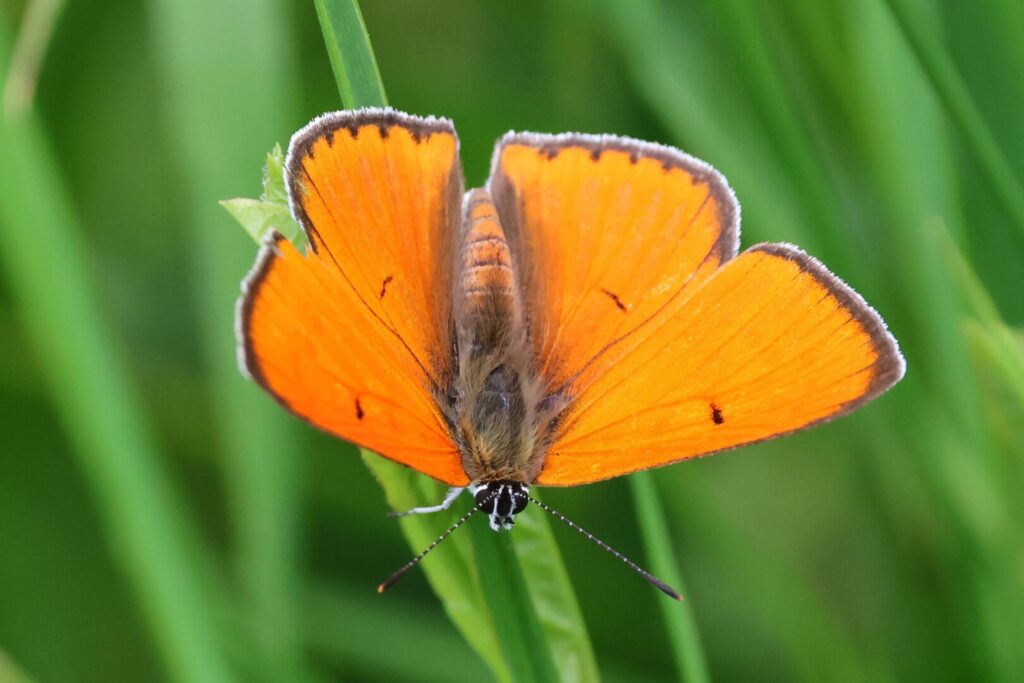
The sun just started to come out and several stunning Large Coppers appeared, being chased off by the blues which were suddenly much more active. We heard the Starlings alarm calling over by the monastery and looked across to see a male Levant Sparrowhawk circling up amongst them. We had some nice views of it now as it slowly drifted across and gained height before disappearing behind the trees. Then a few seconds later we turned to see it flying back in low over the treetops towards us, displaying and it came right past in front of us. Worth the wait!
The appearance of the sun and a bit of warmth had brought some other birds out too – first a Black Stork flew in high towards us and as it came overhead, a squadron of 29 White Pelicans flew over the other way. It was hard to tear ourselves away, but we had a long drive over to the Macin Mountains next.
As we drove in along the dusty entrance track through the fields, we scanned the wires but all we could find were Rollers and no sign of the Black-headed Buntings which are usually along here. In the open steppe beyond, there were several Isabelline Wheatears and Crested Larks and one or two Red-rumped Swallows hawking over the grass. The cloud had gone, the sun was out and it was warm now so we parked in the shade of some trees and got out. A Lesser Grey Shrike was perched on a nearby dead small tree out in the grass and another was on a fence post just beyond the trees, and a Red-backed Shrike was flycatching from the bushes. Several Cardinal fritillaries were nectaring on the thistles.
As we walked down the track through the grass, there were several Corn Buntings singing and then we heard a Barred Warbler in a patch of small scrubby trees further back. We stopped and scanned to see if we could find it, but all we could see was a female Red-backed Shrike. The Barred Warbler sang again a bit further back but all we had was a quick glimpse of it as it flew out and disappeared away from us.
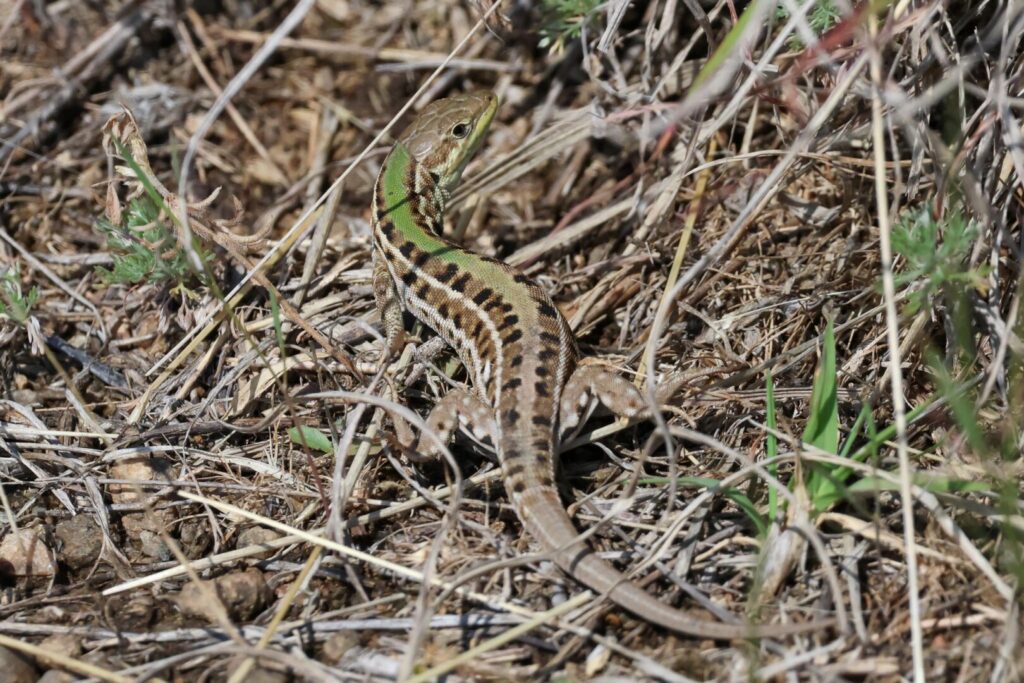
Continuing on, an Isabelline Wheatear was perched on the information sign for the National Park and we stopped to look at a Balkan Wall Lizard on the path just as a Tawny Pipit flew up onto a small rock ahead of us. We had a good look at it through the scopes before it flew up and out over the steppe singing.
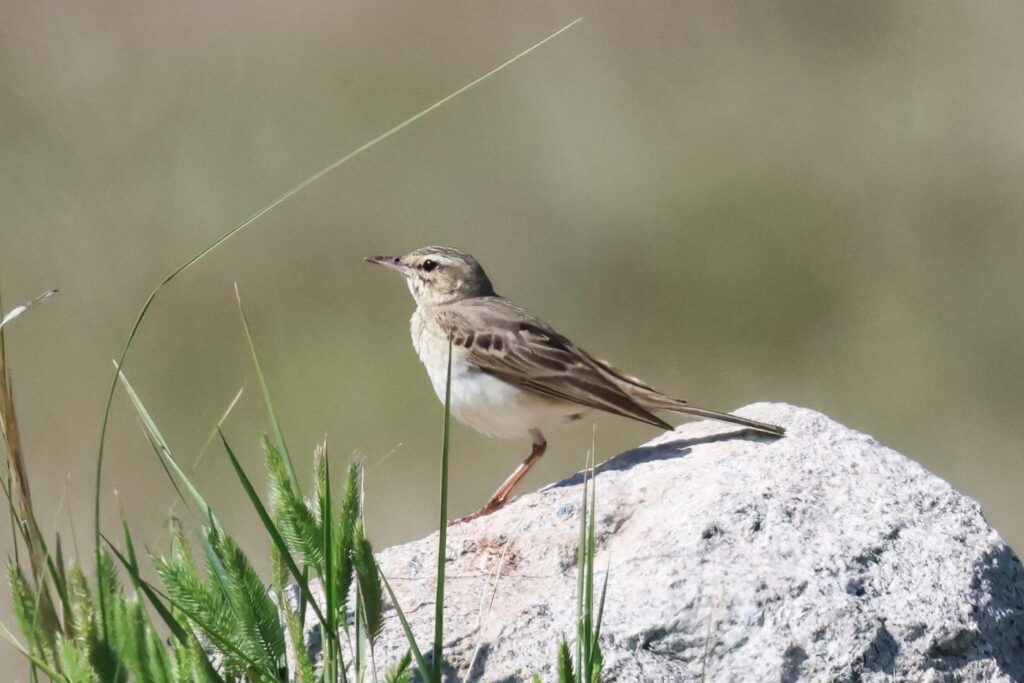
We turned onto the path which heads up into the mountains and as we walked up we scanned the rocky hillside ahead of us. A Long-legged Buzzard was perched high on the crags and another flew overhead, and another smart male Levant Sparrowhawk flew across low in front of us.
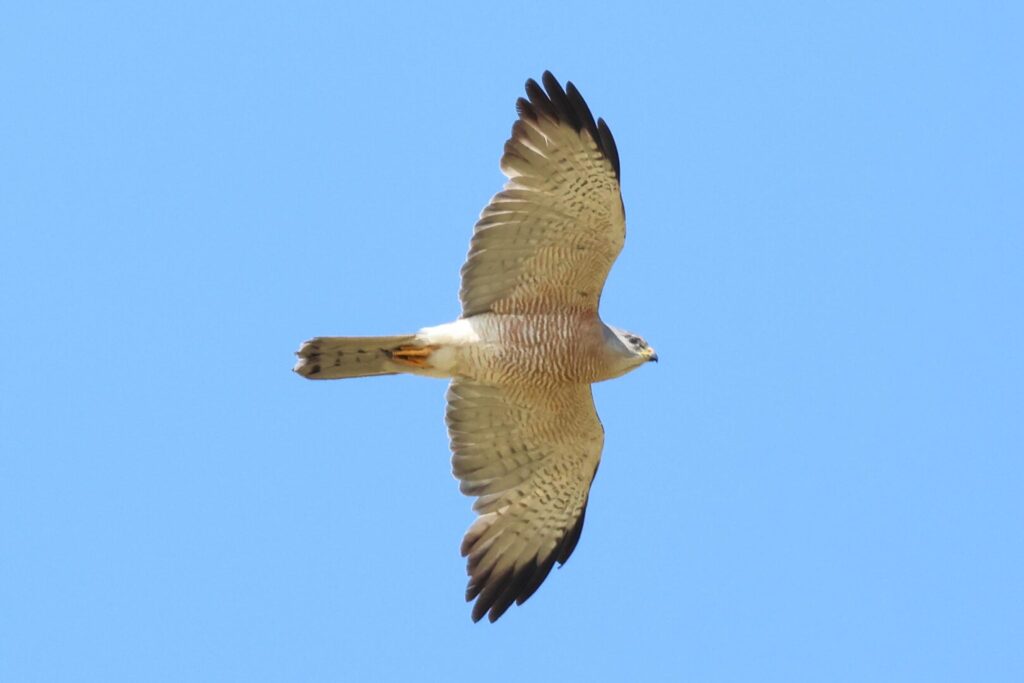
The first wheatear we found was a very distant Northern Wheatear right on the top of a rocky outcrop and then we had a couple of brief glimpses of our target here, a male Pied Wheatear. It disappeared behind the rocks where the Northern Wheatear was perched and didn’t come out again. We could hear Ortolan Bunting singing and picked one up now on the same outcrop as the Northern Wheatear, though again it was very distant and impossible to make out any detail.
We walked on a little further towards the rocks and continued to scan the tops and it wasn’t too long before we found another Pied Wheatear. Again, it was distant from here but this time it stayed out in the open and we could get it in the scopes and get to see it properly, a smart male. A male Stonechat appeared too, right on the very top of the highest rock.
There were several butterflies in the grass, including Adonis Blues and Lesser Spotted Fritillaries. Unfortunately we were running short on time now so we couldn’t go any further, particularly if we wanted ice cream on the way back. We walked back down the track, stopping to listen for the Barred Warbler again but there was no further sign by the time the minibus came over to pick us up. On the way back to the road, we stopped to look at a Spur-thighed Tortoise which was sheltering from the sun on the edge of the track.
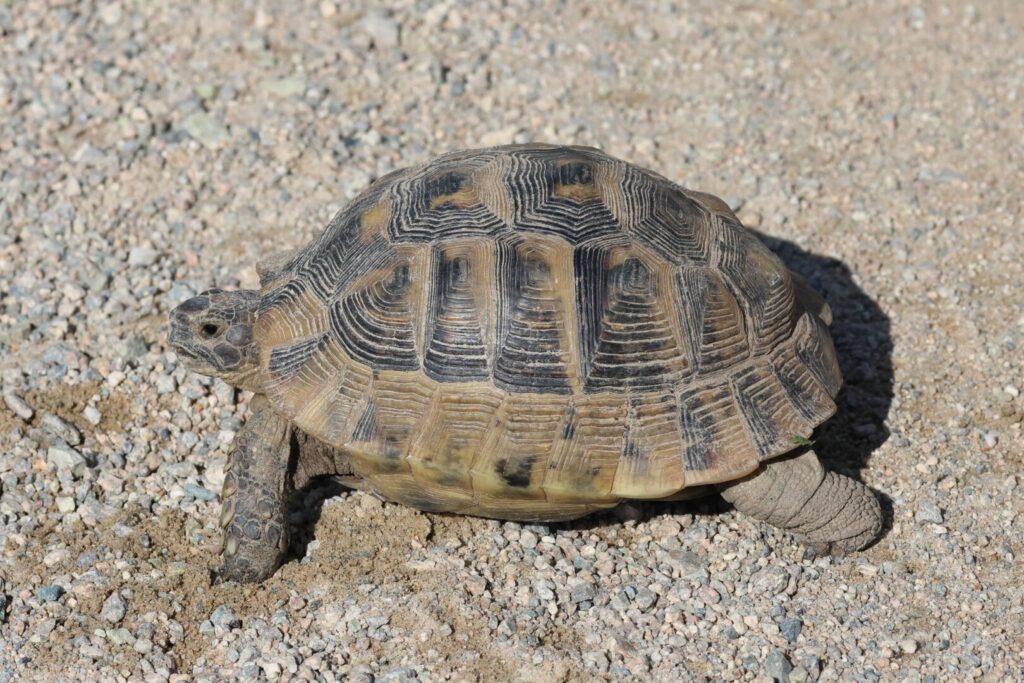
While we stopped for ice cream, another Black Stork drifted over distantly and a dark Booted Eagle circled over. We picked up a very distant pair of Little Owls too, perched on a ruined farm building, but there was quite a bit of heat haze now in the sunshine. The group were not impressed with the views! Then it was time for the long drive back to Tulcea.
We were staying on the floating hotel tonight, so the minibus dropped us down by the edge of the Danube and we walked out over the gangway. Our bags were waiting for us, having been transferred down from the guest house this afternoon, and we had a break to get settled into our rooms before dinner in the dining room with the sun setting behind us over the river. As we ate, two or three Night Herons flew past the windows.
Friday 31st May
It was a much nicer morning today with blue skies and sunshine. After breakfast on the floating hotel, we boarded the small boat and set off down the Tulcea branch of the Danube. On the open deck in a comfortable chair, shaded from the sun by the awning above, we could just sit back, relax and enjoy the view. A female Goldeneye was lurking under the trees close to the bank and eventually flew off as we approached and a Hobby was tussling with a Kestrel over the poplars a bit further along.
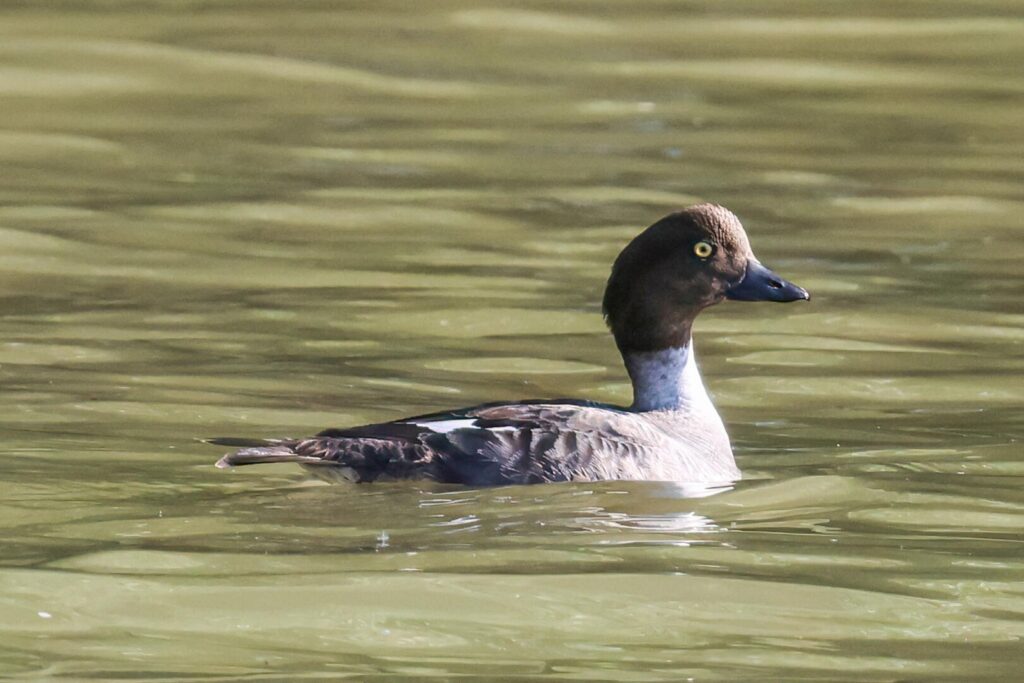
We turned off onto the smaller Mila 36 channel and immediately there were more birds here. Several Kingfishers zipped back and forth in front of us in a flash of electric blue and occasionally perched on the branches overhanging the bank. A Grey-headed Woodpecker landed low on a tree trunk close to the water’s edge and we had a great view of it as we drifted past, a male.
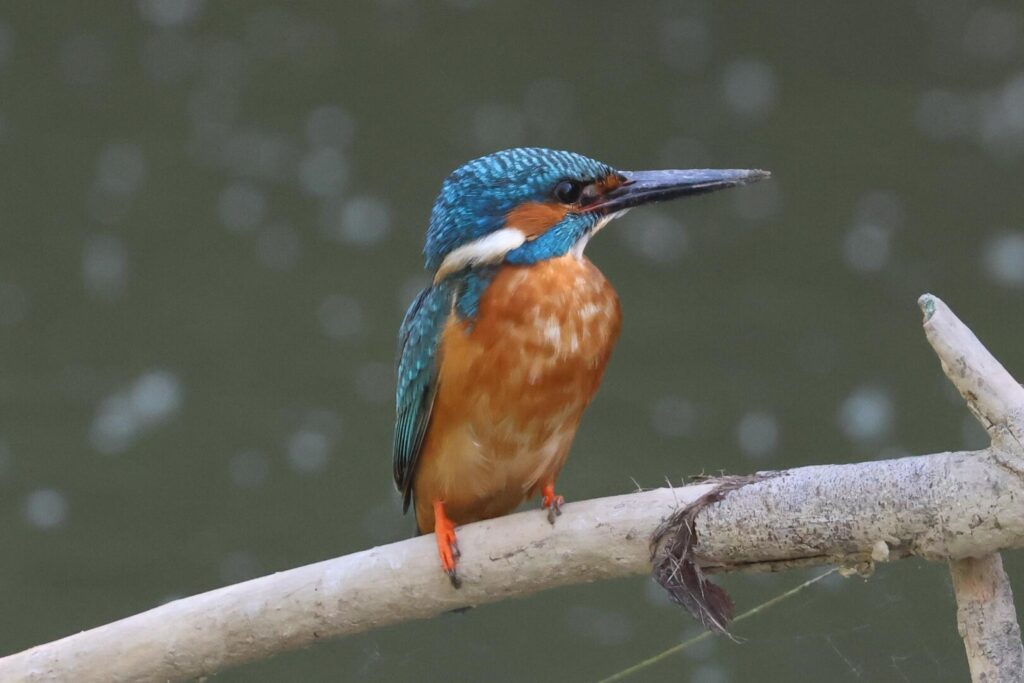
Our first Common Redstart was singing from the top of a dead tree. The boatman cut the engine at times and we could hear lots of other birds in the trees here too – Icterine Warblers, Blackcaps and Chiffchaffs, Nightingale, Chaffinches and Great Tits – but they were hard to see as we sailed past on the current. There were Eastern Olivaceous Warblers too and most of the group at least had glimpses of one or two of them in the branches.
Turning onto a small channel, there were a few herons in the trees, including close Night Heron and Squacco Heron and as it started to open out a bit more and the trees thinned there were Pygmy Cormorants drying their wings on snags by the bank. Birds flying past all the time too, herons, egrets and Glossy Ibises, Common and Whiskered Terns.
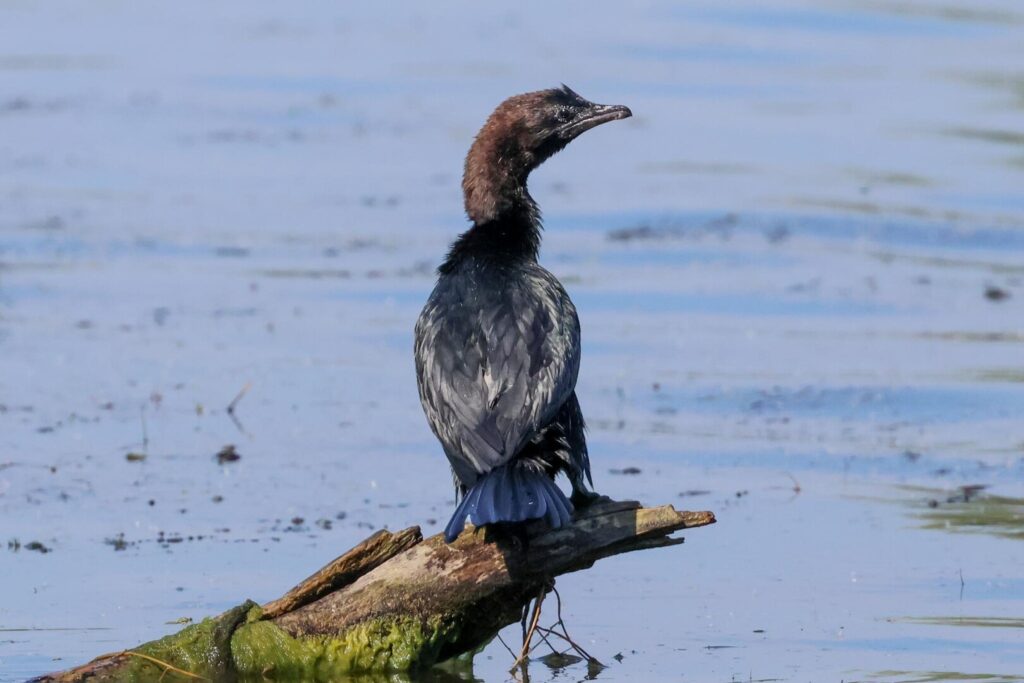
There were more areas of reed close to the channel along here and we started to hear Great Reed Warblers and Reed Warblers singing now. We managed some nice views of a Great Reed Warbler perched in the very top of a dead reed stem.
Turning off the channel and into a small lake surrounded by reeds and largely covered with water chestnut, we found several Red-necked Grebes. We stopped to look at them, the sun catching their rusty red necks as they turned in the sun. As we drifted into the edge of the water chestnut we could see it was covered in ‘Green Frogs’.
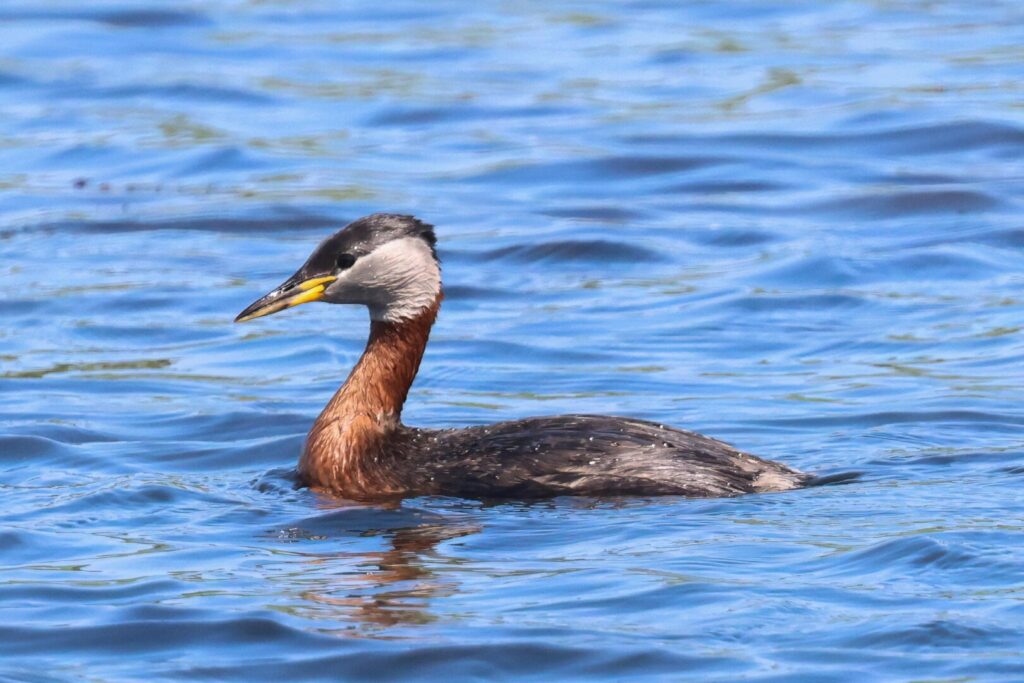
Back out on the channel, we motored on. When we came out onto another wider channel with a grazed bank with muddy margins we had a nice view of a Glossy Ibis feeding in the sunshine. We passed through a succession of larger lakes where we found more Red-necked Grebes and Great Crested Grebe, some of them with stripy headed juveniles riding on their backs, and a single Little Grebe over on the edge of the reeds at the back.
We stopped to look at a breeding colony of Great and Pygmy Cormorants in the trees and there were a few Spoonbills in with them, some on the nest, and lots of Little Egrets, Night Herons and Squacco Herons in the lower sallows below. One of the Squacco Herons was displaying, with its feathers and plumes all puffed out.
Thankfully we had enjoyed a nice quiet look ourselves before we found ourselves surrounded by several tourist boats which pushed right in for a closer look. As we motored on along the next channel, they came past us one by one, gunning their big 200bhp outboard engines ahead of us and speeding off, leaving a huge wake behind them and a succession of big waves which crashed into the banks. No wonder, as Cristian explained, they need to dredge the channels every few years given the amount of erosion this causes to the banks! It is also probably having a negative impact on the number of birds which feed along the banks these days.
There were several huge kettles of White Pelicans circling slowly up in the blue sky now and as we sailed on we passed under some of them, mesmerizing to watch the different layers moving in different directions and they tried to thermal up. A single Dalmatian Pelican flew over too, more typically on its own, its greyer underwings singling it out. Our first White-tailed Eagle of the morning flew out of some trees as we approached and circled round behind us before coming past us over the reeds the other side mobbed by a crow, an adult with white tail and paler head.
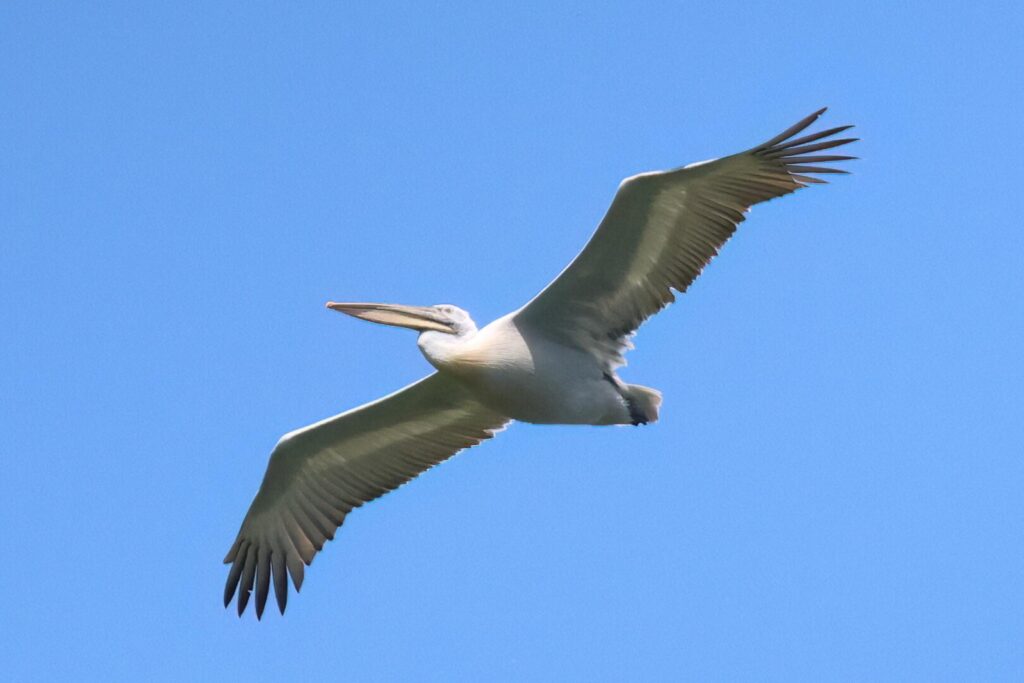
It was time for coffee now and just as Cristian was serving it, a Lesser Spotted Woodpecker called from the trees above us. One of the group spotted a Collared Flycatcher in a dead willow on the bank and then we realised there were two. The boatman managed to turn round and position us below the tree and we had great views of the pair now in the bare branches, the male carrying food. They flicked across to the next tree and we could see they had a nest hole.
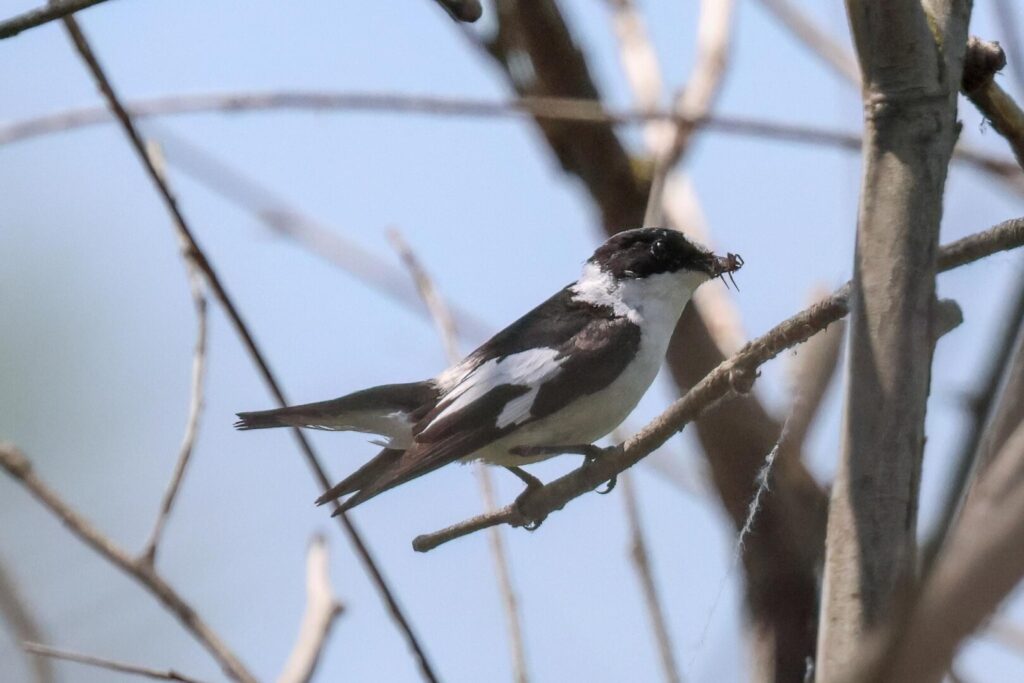
While we were watching them, another White-tailed Eagle circled over us, this time a subadult lacking the fully white tail. With lots of willows lining the banks, we had been on the lookout for Freyer’s Purple Emperor butterflies – we had glimpsed a couple of possibles and now a male flew out over the water and briefly beside the boat where we got a flash of the purple-blue patches on the upperwing.
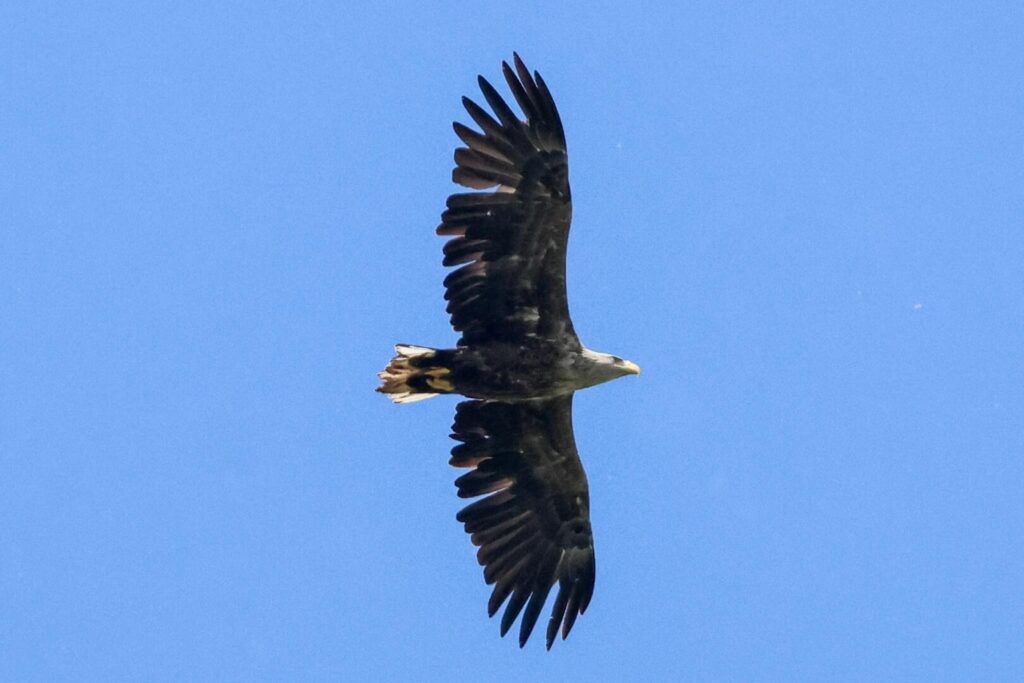
At the next small lake, there was a small Whiskered Tern colony, with good views of the birds perched on the floating vegetation and fishing alongside the boat. Several White Pelicans swimming ahead of us were the first we had actually seen on the water, and there were a couple of Black-necked Grebes here with the commoner Red-necked Grebes. Then out into the much larger Lake Furtuna we found a very bright breeding adult White Pelican as we came out of the reeds, with swollen bulbous orange bare skin around its eyes.
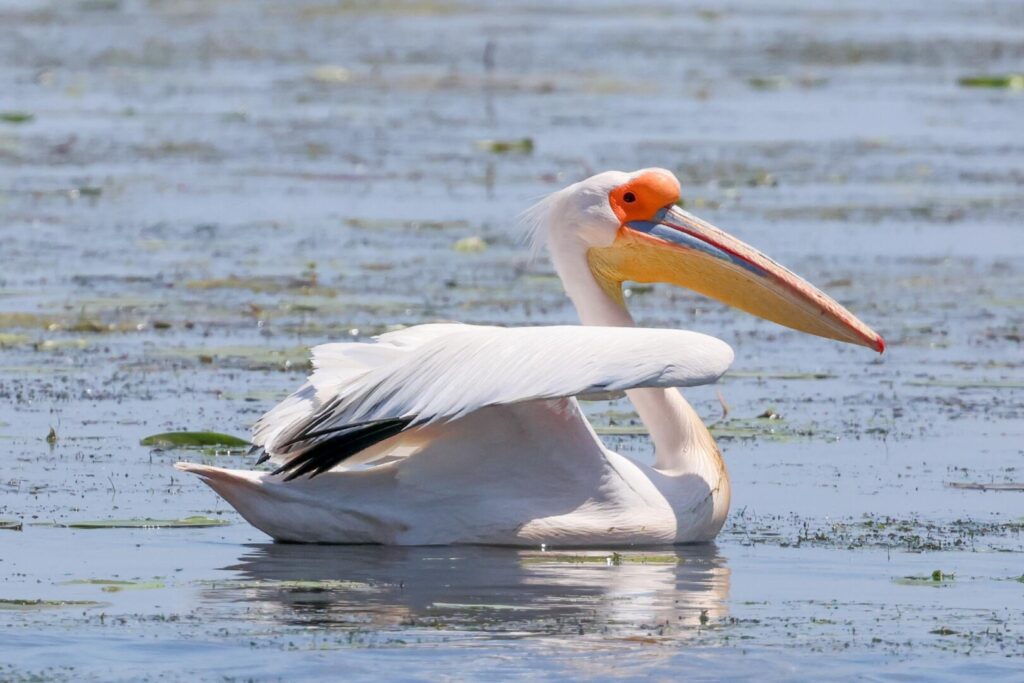
The breeze was starting to pick up and several damselflies tried to land on the boat, including a tandem pair of Small Red-eyed and a couple of Blue-tailed Damselflies. We headed over to the bank where there is a White-tailed Eagle nest, one of the two dark juveniles exercising its wings on a nearby branch and the other on the nest itself. We could see one of the adults perched in a dead tree further round the edge of the lake and as we set off across to the other side, two more White-tailed Eagles were being mobbed by crows distantly over the trees beyond – they seemed to be everywhere now!
A Squacco Heron kept flying ahead of us and landing again as we sailed down the next narrow channel, and another Freyer’s Purple Emperor flew across low in front of us. We sat back and relaxed now as we made our way down towards where we would meet the floating hotel for lunch.
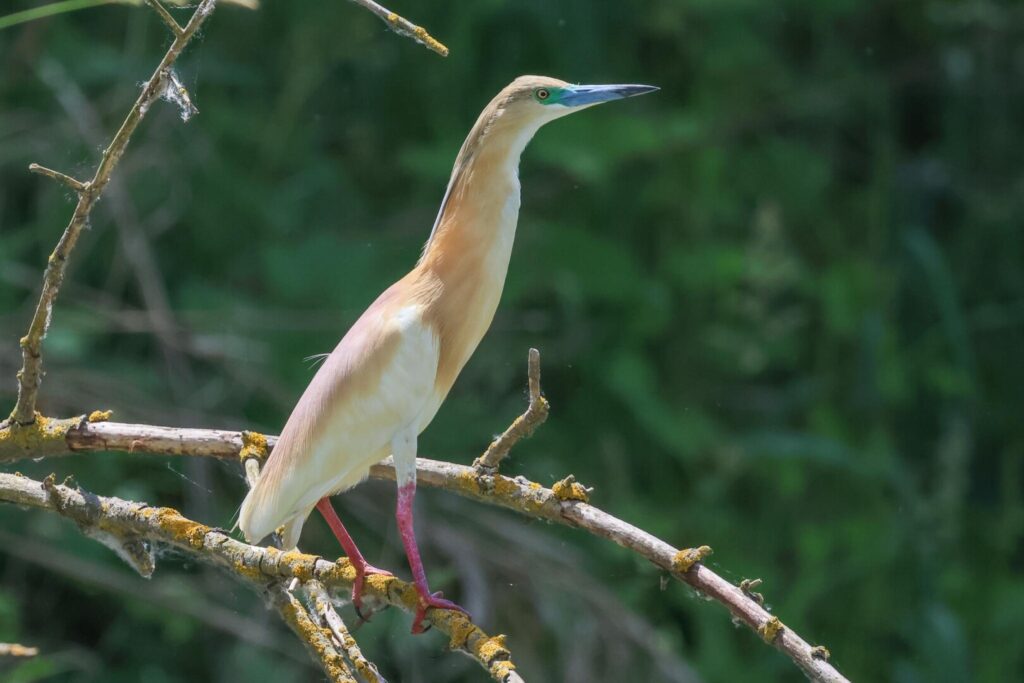
We could tell we were approaching civilisation again as the banks became more open. A Night Heron flew round in front of us and there were Bee-eaters and Rollers perched in the trees here.
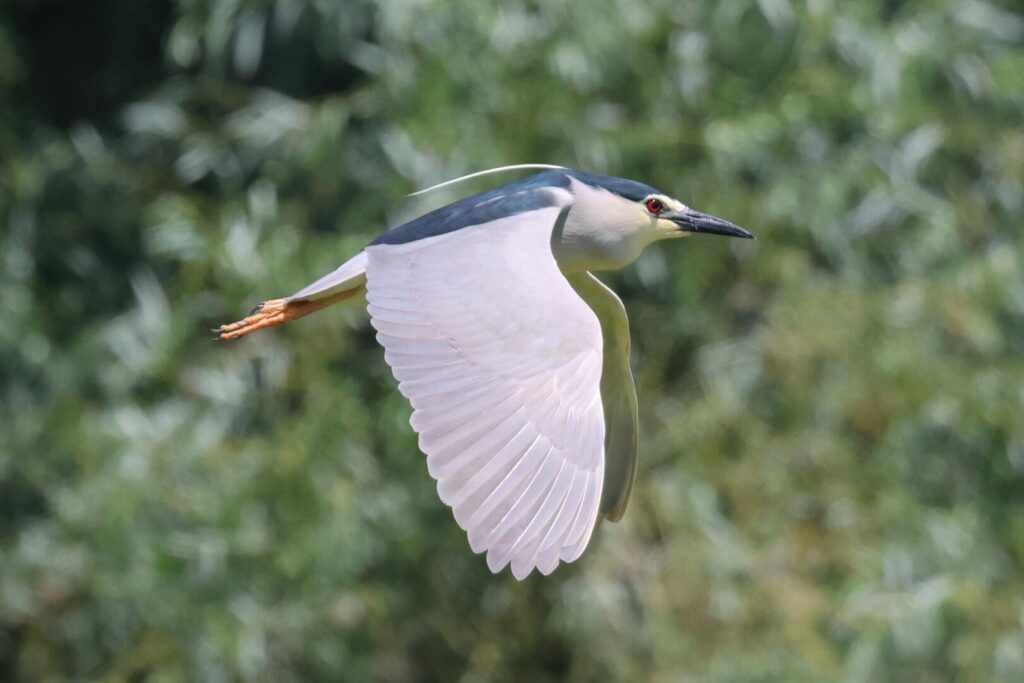
We stopped to look at a particularly obliging pair of Rollers in a dead tree and a Yellow Wagtail we perched in the top of another tree nearby, a male of the Romanian intergrade form ‘dombrowskii’. Several Sand Martins flew in and out of the sandy banks.
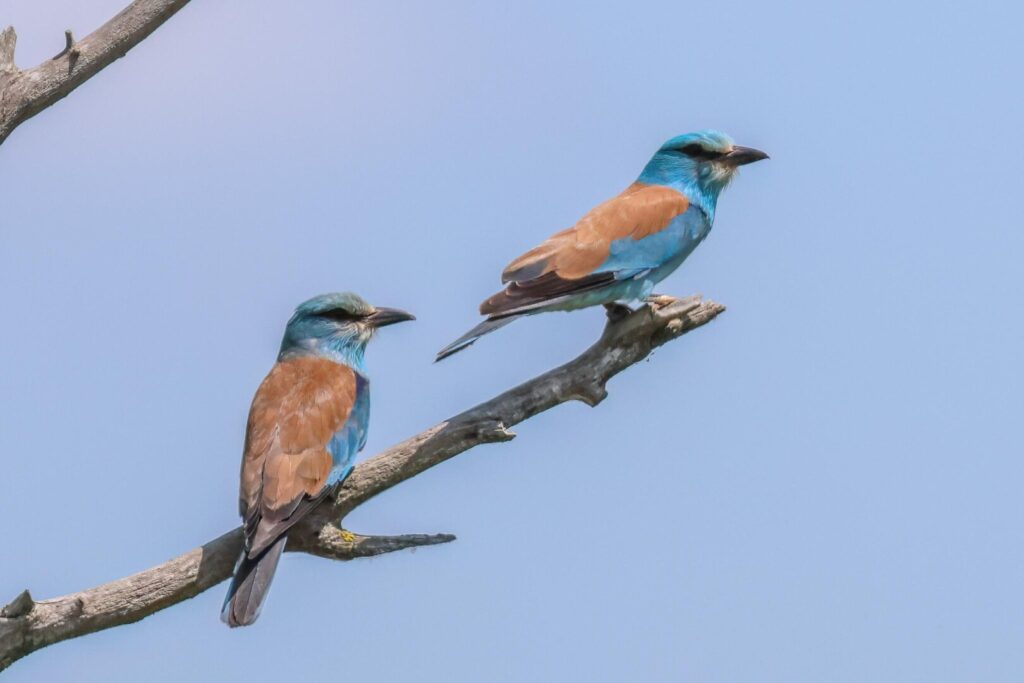
Coming out onto the main Sulina channel of the Danube, we found the floating hotel moored up waiting for us. Once we were on board, a delicious lunch was waiting for us too, soup with dumplings followed by stuffed vine leaves. As we sat down, the boatmen cast off and the floating hotel was towed by the tug, heading on to where we could spend the night, while we could enjoy the view from the windows of the dining room.
We were just finishing eating when Cristian spotted a Golden Jackal on the bank, followed shortly after by a second one, presumably having come down to the river to drink. After lunch we had a couple of hours to relax and enjoy the view from the deck or take a siesta. There were birds to see here too, particularly as we got onto the smaller Crisan channel – Glossy Ibises and Great White Egrets feeding on the muddy banks, Lapwings, lots of Mallard and one or two Ferruginous Ducks, Marsh Harriers over the reeds.
Eventually we arrived at our mooring spot for the night and the floating hotel was tied up on the bank. There were three or four Eastern Olivaceous Warblers singing in the willows on here but it was rather windy now and they were not showing themselves, and a Grey-headed Woodpecker called in the distance. A Dalmatian Pelican swam past on the other side of the channel.
Setting off again on the smaller boat, we cut across to Litcov channel. A few more Glossy Ibises and Great White Egrets were feeding on the banks and a White Stork and a Purple Heron flew up out of the reeds. A pair of Gadwall were hiding in a small side channel and several Ferruginous Ducks flew up as we approached.
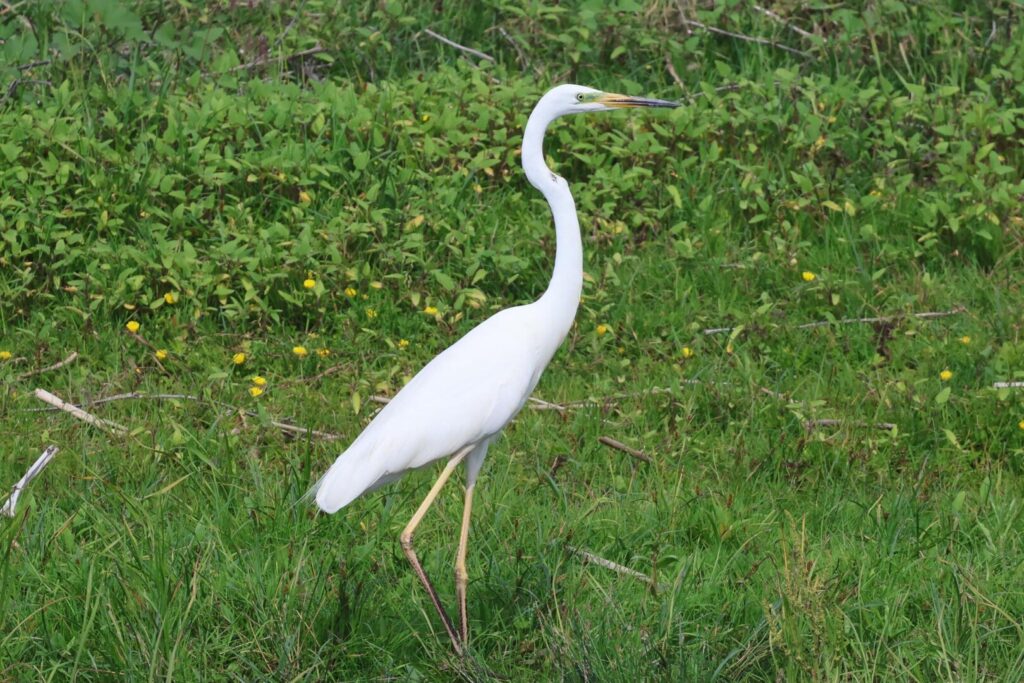
As we motored along, we kept scanning the banks and muddy edges and spotted a Little Crake lurking in the edge of the reeds. Unfortunately it was spooked by the boat and ran into the reeds followed by a second Little Crake, visible only very briefly in a gap before they disappeared deeper in before most of the group could get onto them. Typically very skulking, they are always particularly hard to see at this time of year. A Squacco Heron showed better.
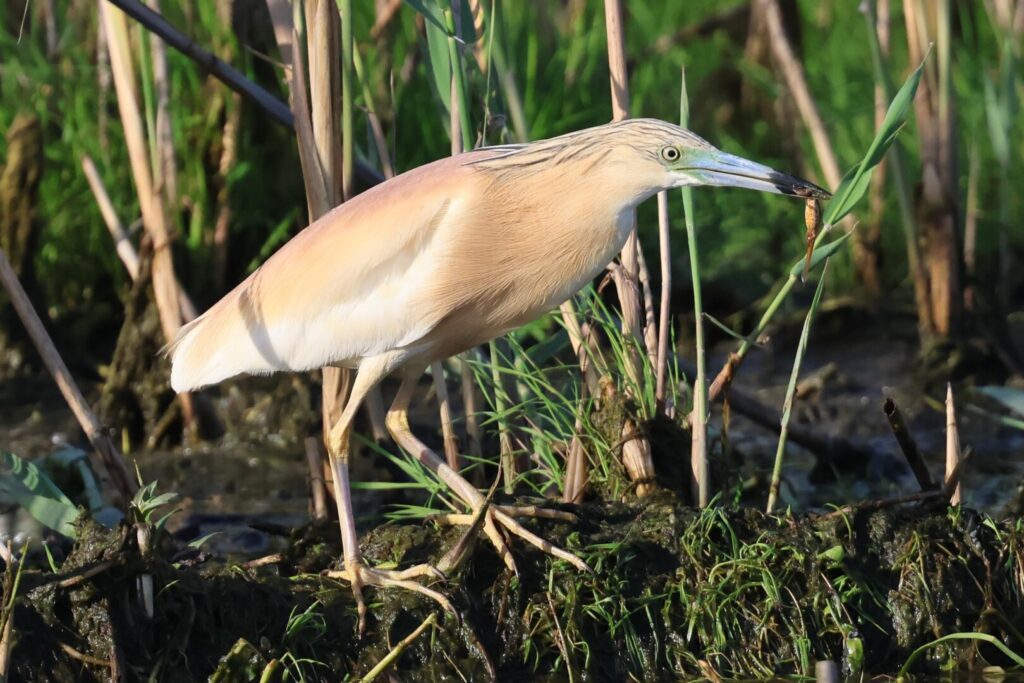
We turned off through the reeds and out into a lake where a group of White Pelicans were feeding on the edge of the reeds. We watched them upending, looking for fish. A huge cloud of Pygmy Cormorants flew over the lake towards us and as we moved forwards we could see there were hundreds in a tight raft feeding in a small channel the other side of us, with more perched up in the reeds and low willows on the edge. A very impressive sight. After they were spooked by a passing Marsh Harrier, we turned down the channel and found some still further down, along with Little Egrets and more Pelicans feeding too – there must be lots of fish here.
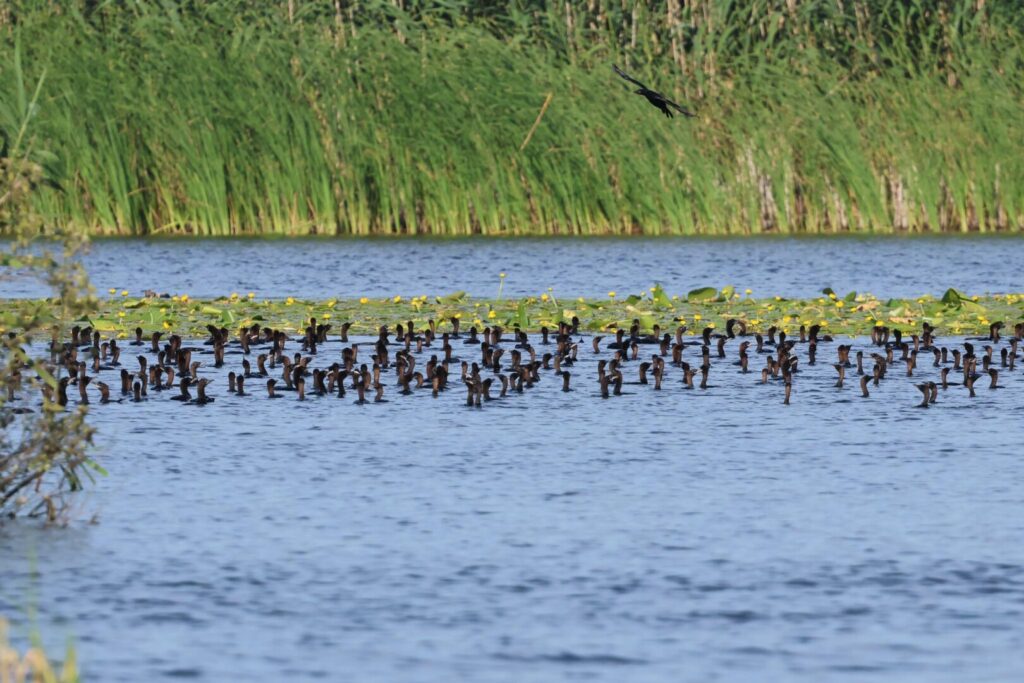
Back out on the Litcov channel, we heard a Common Redstart singing and looked up to find a pair in a dead willow, going in and out of their nest hole. A Lesser Whitethroat flitted through the branches with food in its bill too.
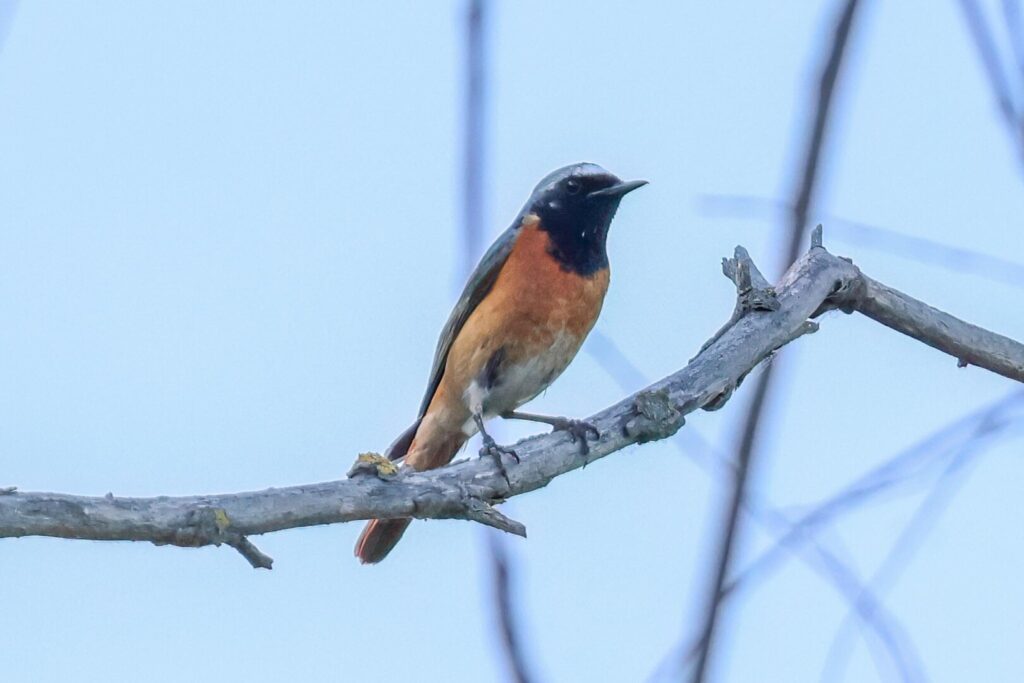
As we made our way back, a Hobby was hawking low over the reeds on the bank and landed in the dead branches in the top of a low tree. We had just got out onto the Crisan channel when an adult Pallas’s Gull flew over, we could see its black hood as it disappeared away over the other side. Thankfully we would have plenty more opportunities to catch up with this very attractive species.
Past the floating hotel, we turned off down another small channel where a couple of Garden Warblers and a Blackcap were singing and a Turtle Dove flew out of the trees. On Lake Iacob beyond, we found lots more White Pelicans – a couple of small groups were loafing and preening on some tangles of branches, including another smart male, but another dense, tight flock was feeding off to one side of us, upending in succession. Great to watch. A single Dalmatian Pelican was sleeping on its own, flanked by two Great Cormorants.
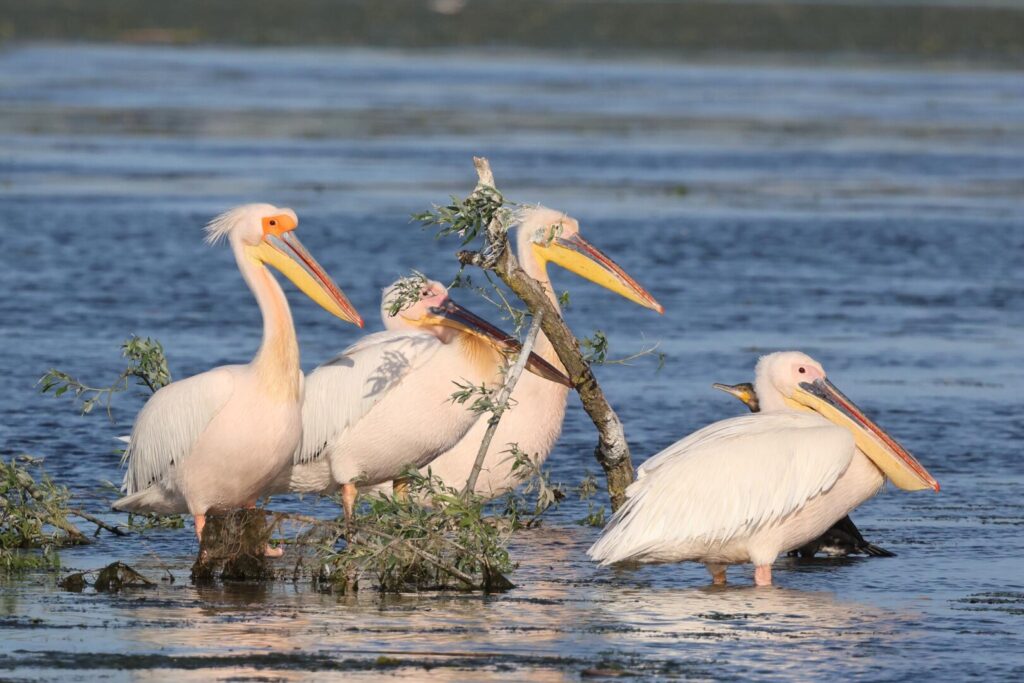
We tried to get round to the other side of the feeding White Pelicans for a better view by taking another branch of the channel we had just come in on, but by the time we got round there they had stopped. As they swam across in front of us, one was mobbed by a couple of Common Terns and kept turning and opening its bill, flashing huge pouch at them. We could hear Bearded Tits calling in the reeds nearby but it was a bit too breezy for them to come out.
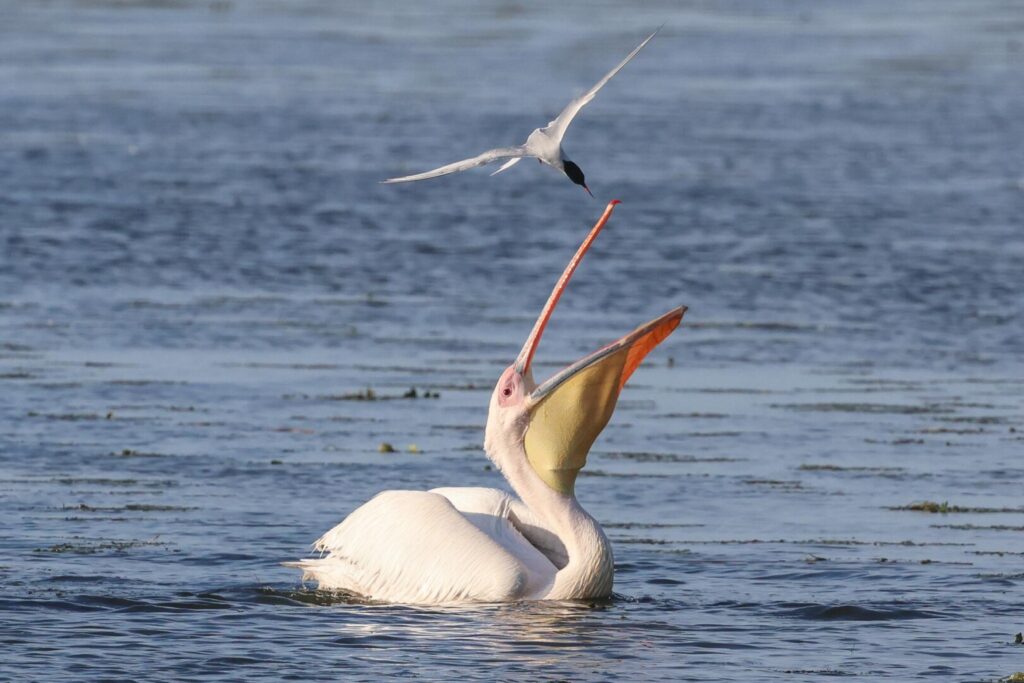
We made our way back to the floating hotel and we had time for a quick break before another delicious three course dinner. After dinner, while Cristian was explaining the programme for tomorrow, he was interrupted by a chorus of Golden Jackals. We went out onto the deck and could hear two groups calling to each other, one just behind us on the bank and the other across the other side of the channel. While we were attempting to go through the list for the day, we were then interrupted again by a Thrush Nightingale which started singing just outside, so it was back out onto the deck to listen to that. Such are the distractions of staying out in the wilds of the Danube Delta!
Saturday 1st June
It was rather breezy as we boarded the small boat this morning and set off down along the Crisan channel. Several Cuckoos flew across from one side to the other, an ever present in the Delta with so many reed warblers to target, and a typically lone Dalmatian Pelican was swimming on the water.
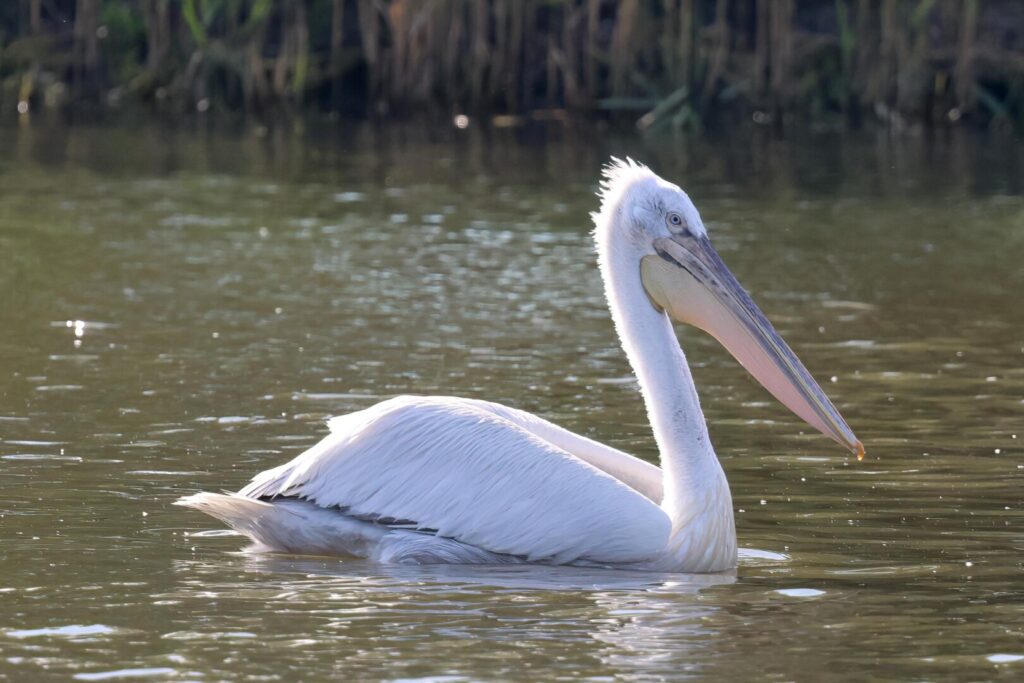
As we motored along, we heard several Great Reed Warblers singing and spotted one of them perched in a small willow, so we stopped for a closer look, our best views yet. Continuing on, a Thrush Nightingale was singing too and we heard several Penduline Tits before we spotted one briefly in the trees on the bank.
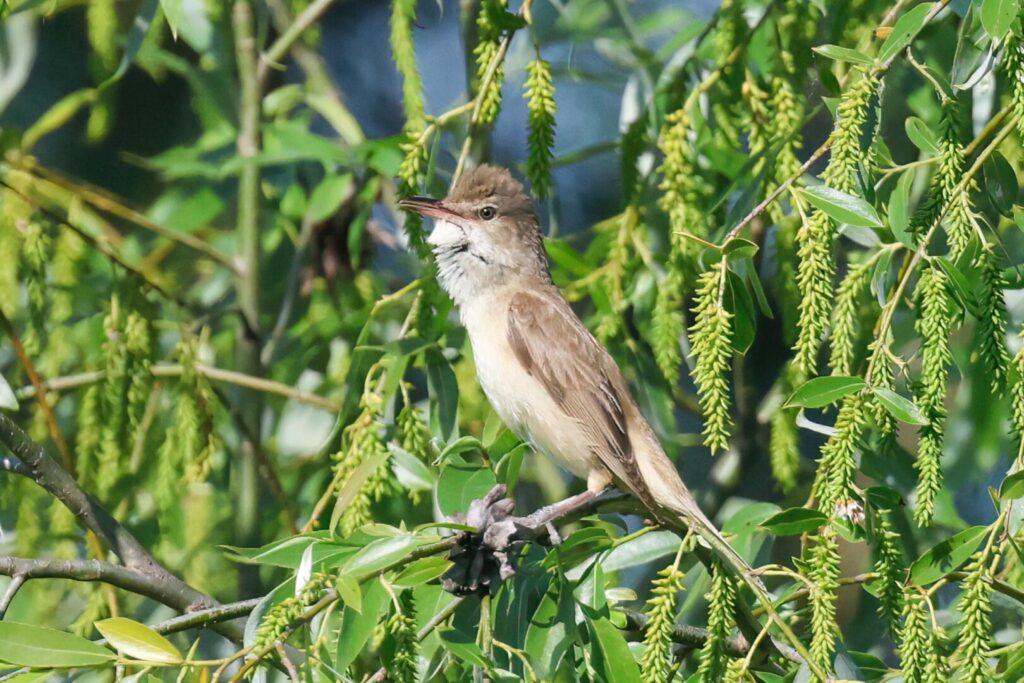
We stopped again to see if we could find it but at first we could only hear them and see a Chiffchaff in the bushes. Then Cristian, who was standing up, spotted a juvenile Penduline Tit very low down in a willow behind the reeds. It was clearly very young, still with a very wide yellow gape, so we stayed to see if an adult would appear. Eventually the female flew in and the juvenile flew into the willow to be fed. Now we could just see the nest in the back of the willow and we realised there were several juveniles. We watched them going in and out of the nest and the adults coming in and out with food for them.
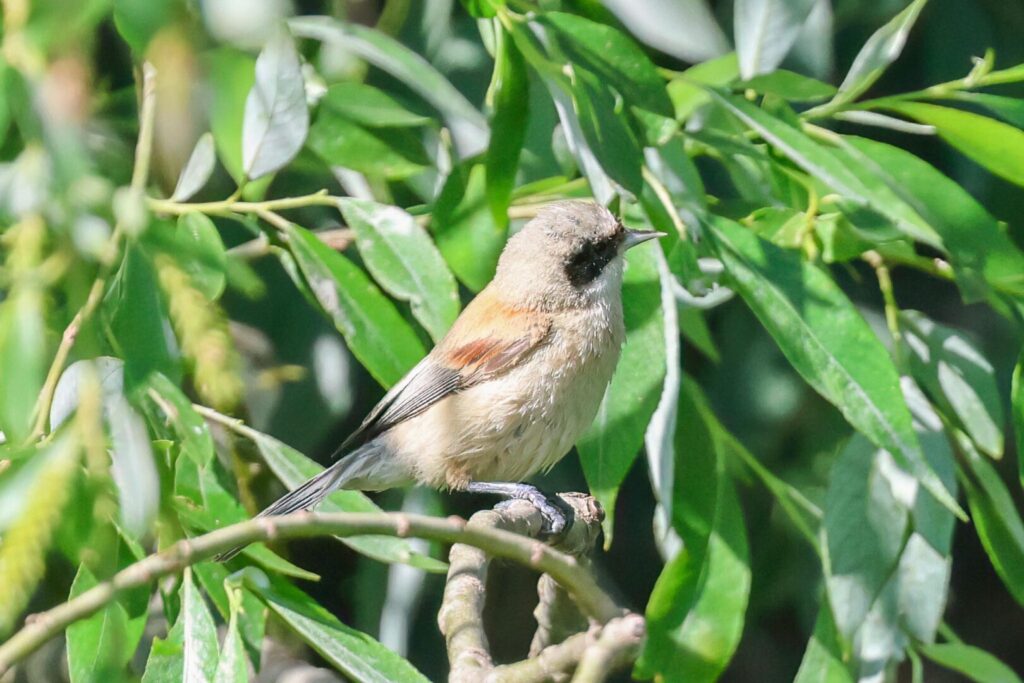
Moving on, a Purple Heron flew up from the reeds by the bank and flew alongside us for a while, giving great flight views. There were more Ferruginous Ducks along the channel here, but they were typically flighty and as ever took off before we got close. We heard some Bearded Tits calling and when we stopped to listen we realised they were up high in the willows. We could just see one or two in the back of a tree before they flew out across a gap and we could see there were about twenty of them. A male Reed Bunting was perched in the top of a small isolated clump of reeds growing in the side of the channel.
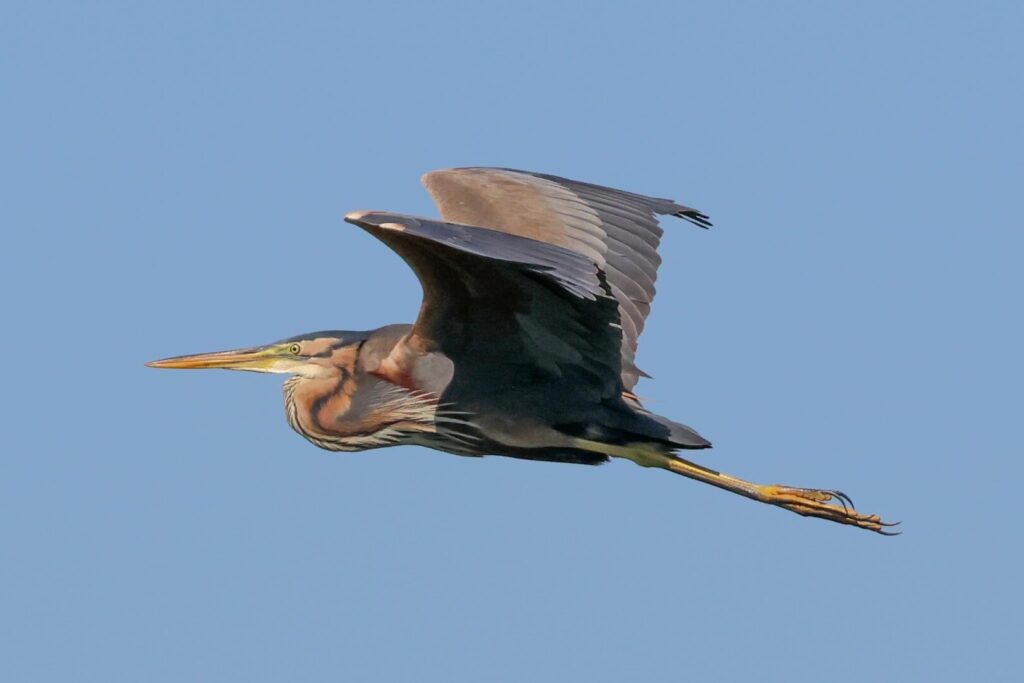
Cristian spotted an eagle high in the sky which drifted across above the channel – it was clearly one of the spotted eagles with Lesser Spotted Eagle being the most likely here at this time of year. Although it was hard to make out any detail with the naked eye against the bright sky, on photographs it was possible to confirm it had slightly paler underwing coverts and a double pale comma at the carpal joint, a Lesser Spotted Eagle.
We could see the ruined Soviet-era factory complex at Carorman as we approached and as we got out onto the bank a very smart Praying Mantis seemed to take a liking to the leader’s trousers and hitched a ride. Then posing nicely on one of the group’s hand for photos. First a Caspian Tern and then a Pallas’s Gull flew past and they seemed to be heading for the pools behind the old factory so we hoped we might catch up with them there later.
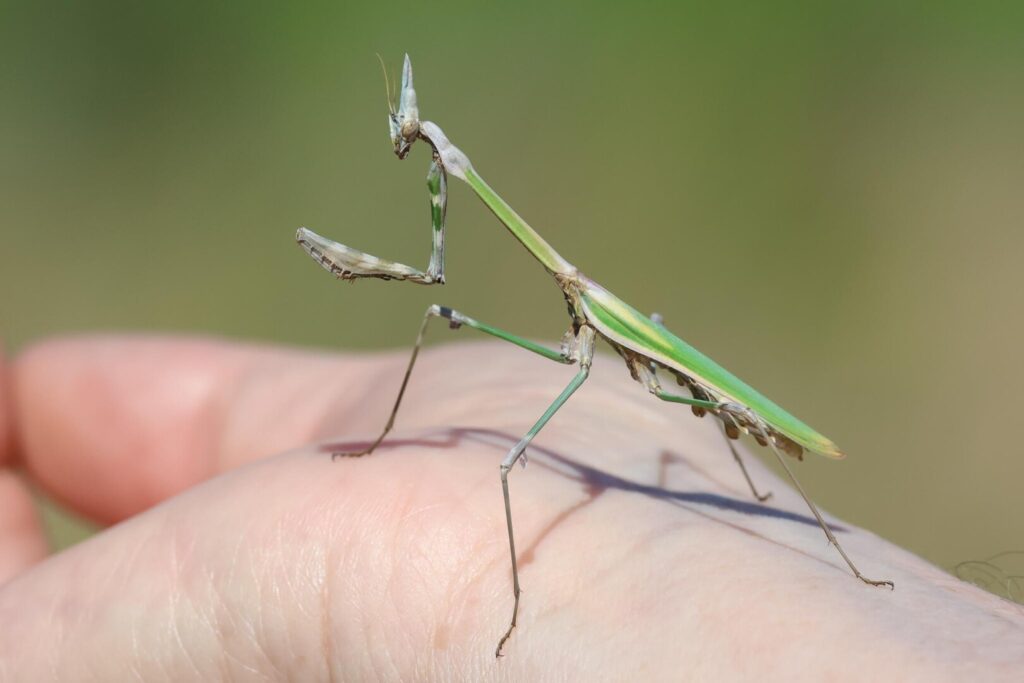
As we walked round on the path, we could see several birds on the pools the other side of the harbour including a Black-tailed Godwit and three Black-winged Stilts. A male Northern Wheatear was on the old buildings, there were lots of Bee-eaters hawking round from the wires and a Roller flew past flashing its bright blue wings.
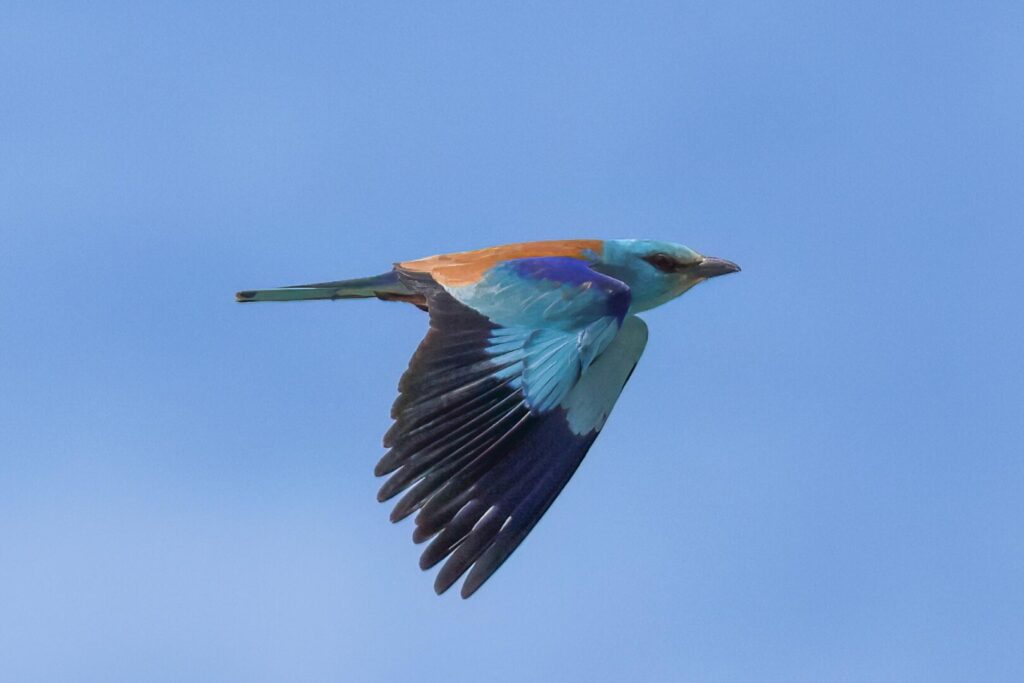
In the flooded grass behind the buildings we found several Glossy Ibises, three Avocets, more Black-winged Stilts including some fluffy half grown juveniles, another Black-tailed Godwit, a Spoonbill feeding and some Shelduck. A Green Sandpiper flew across and landed the other side where we got it in the scope and then we noticed a second at the back of the pool feeding on the margin.
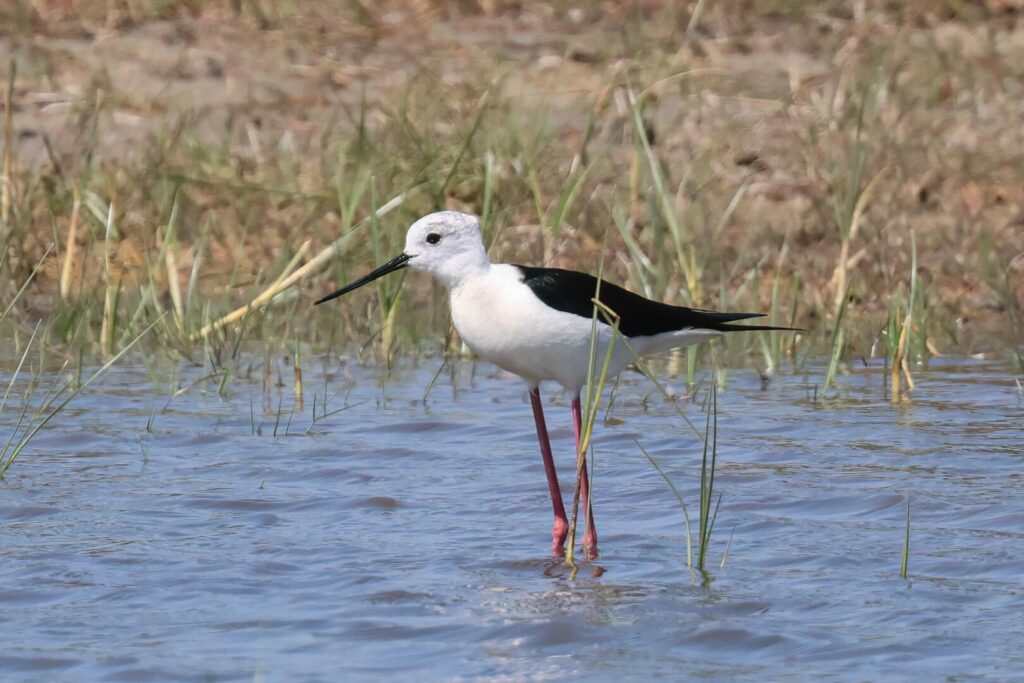
Up on the bank, there were not many different birds on the pool below, although we did find a single Little Gull. A couple of the group looking for insects found a very smart Spurge Hawkmoth caterpillar on a small clump of Euphorbia.
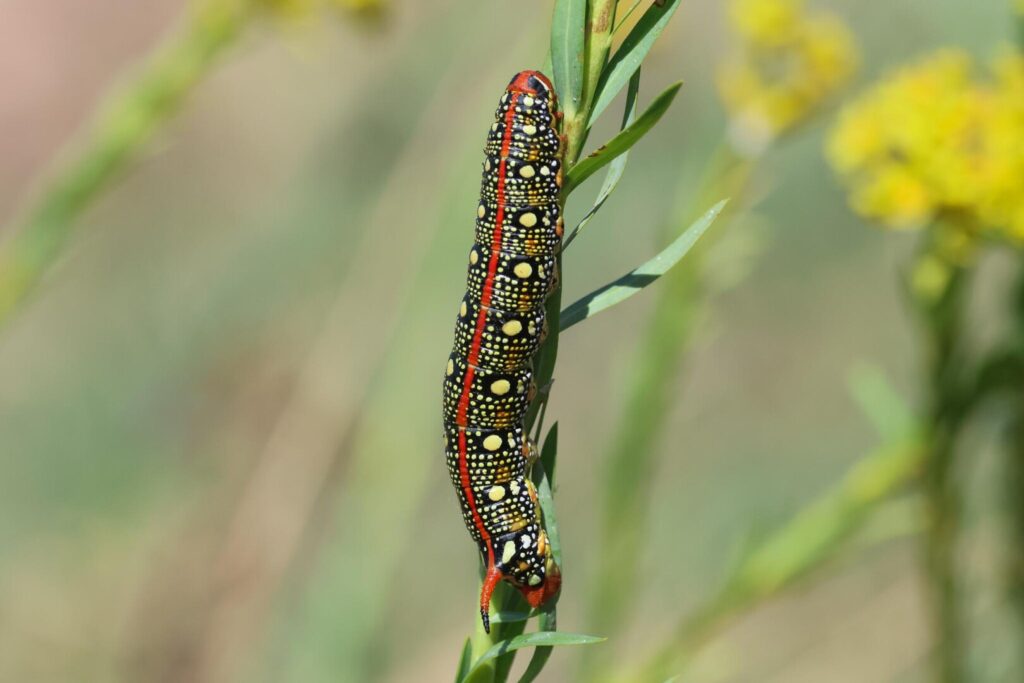
Five Caspian Terns came up from beyond the far bank and came towards us and although they circled round over the pool they flew back and landed again off in the grass beyond. We walked up to the corner and could see them very distantly, loafing in a group with several Pallas’s Gulls and Caspian Gulls.
A quick scan of the flooded grass here added several distant Collared Pratincoles and a pair of Little Ringed Plovers flew over displaying. When we looked back, the gulls and terns had taken off and we watched them as they circled up high. The Pallas’s Gulls disappeared up into the blue sky but a minute or so later we turned to see one flying in behind us and eventually it came over our heads, a much more satisfactory view.
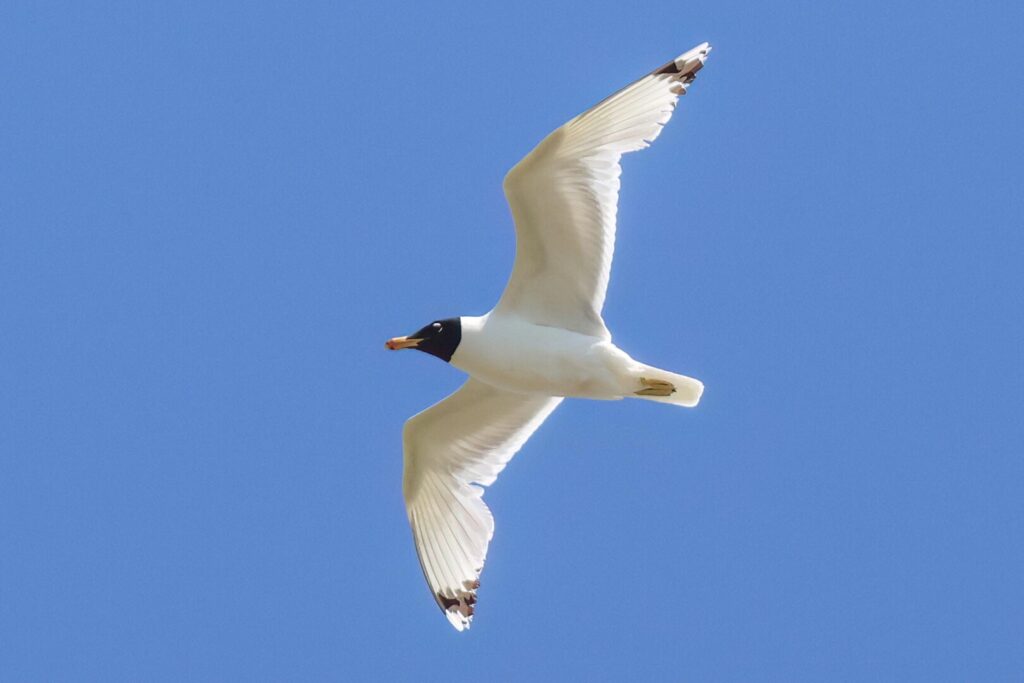
As we walked back to the old factory, we could see a kettle of White Pelicans circling up distantly over the marshes beyond and an adult White-tailed Eagle. There was no sign of any Little Owls on the buildings today but as we walked back to the boat for coffee we did see lots of ‘Green Frogs’, whirligig beetles, dragonflies and three Dice Snakes around the small pools.
As we enjoyed our coffee and biscuits on board, we set off back up along the Crisan channel before turning off onto a smaller side channel. There were more Penduline Tits calling along here and a male perched in the top of a willow where we could just see it through the leaves. Then another Penduline Tit flew up out of the reeds in the channel into another small tree. As we stopped to look, it was joined by a second – we watched them collecting nest material and we realised they were deconstructing an old nest to take for their new one.
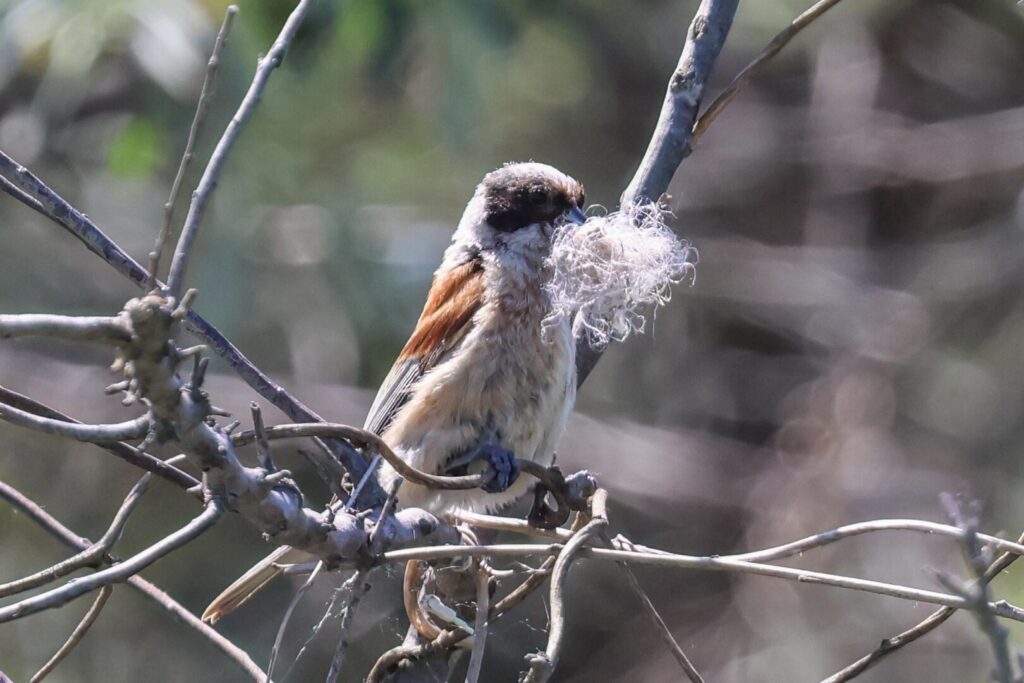
We put the gangplank out and walked up onto the bank. We had slightly overshot the spot which Cristian was aiming for, where there used to be a hide, so we walked slowly back a short distance along the top. There were lots of Whiskered Terns out over the small pools in the reeds and then we picked up a Bittern flying over the reeds the other side of the channel, a nice extended flight view before it dropped back in out of view. We could hear a Savi’s Warbler reeling over that side too, but it was a bit too breezy to perch in the top of the reeds.
There were a few dragonflies in the vegetation, including White-tailed Skimmers and Scarlet Dragonflies, and a few butterflies, but it was rather windy for them too today.
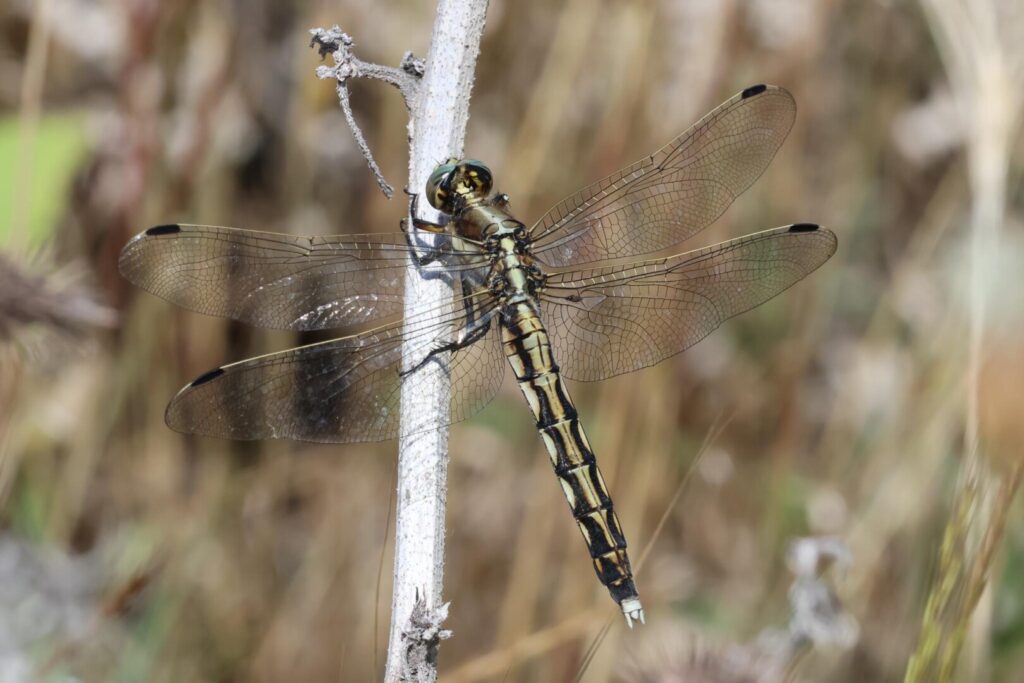
Back on the boat, we drove on further down the small channel pushing through the reeds as they closed in on either side. There were more Penduline Tits along here and several Bearded Tits which flew up out of the reeds. We flushed a series of Kingfishers which kept flying on a short distance ahead of us, perching mostly out of view and at one point we counted at least four.
When we came out onto a bigger channel, a ‘dombrowskii’ Yellow Wagtail was perched on a bare twig on the bank and then on the main Crisan channel we found what was presumably the same Dalmatian Pelican we had seen on our way down this morning and several Ferruginous Ducks again.
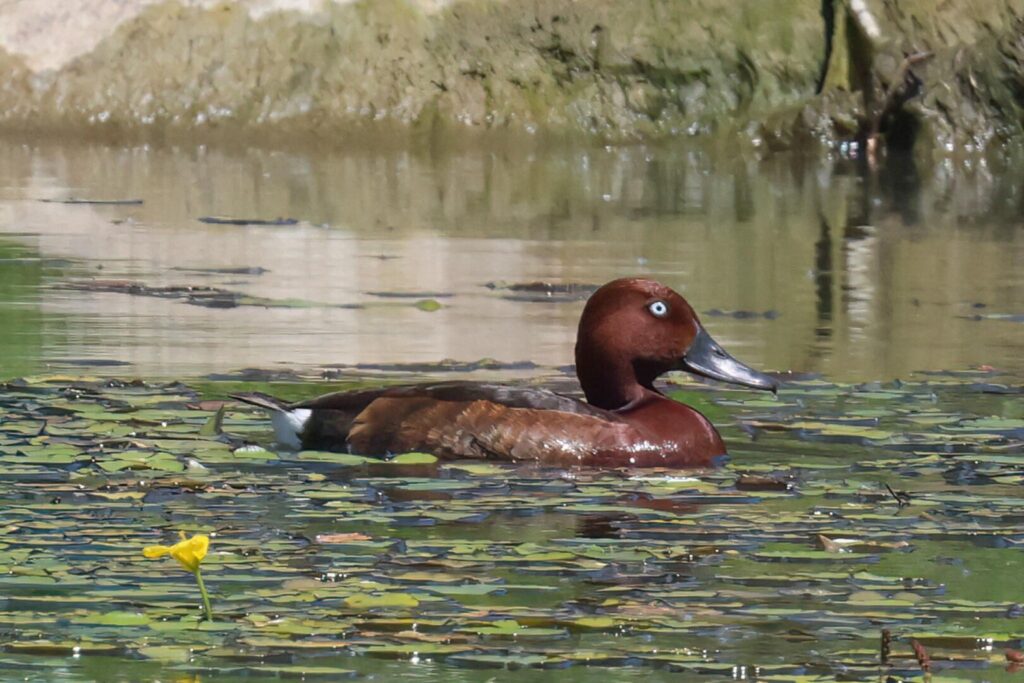
We motored up the short distance to where the floating hotel was still moored and discovered first that a bush cricket had hitched a ride and then found an Eastern Tree Frog which appeared on the deck too.
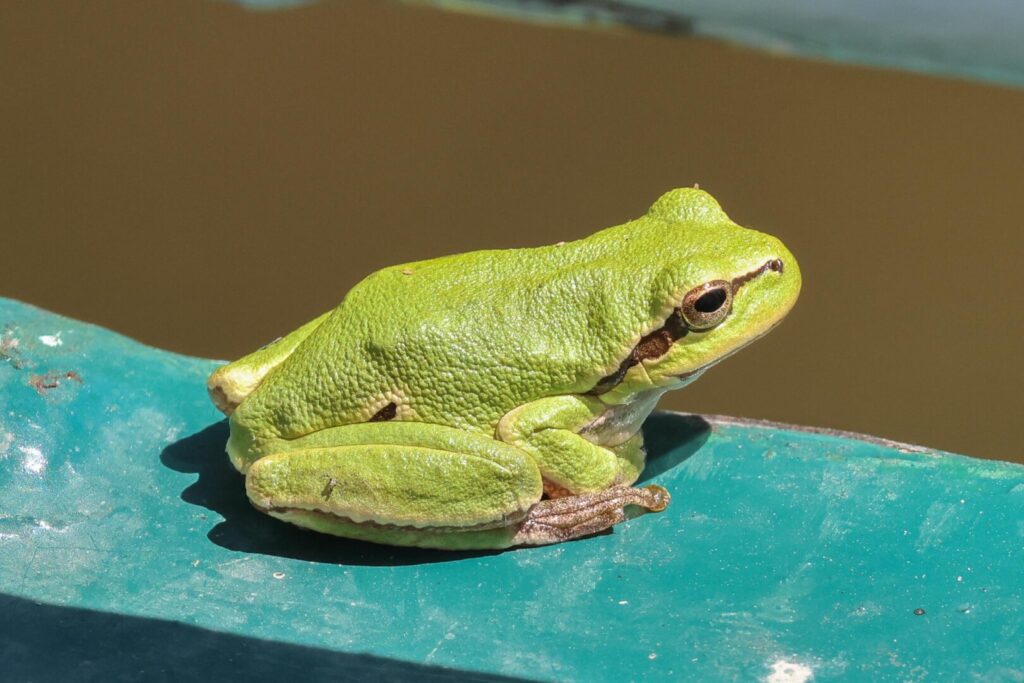
It was time for a late lunch. The tug pulled the floating hotel out into the middle of the channel and we set off. We would be on the bigger channels for the rest of the afternoon, as we made our way to our next mooring point, and there were fewer birds. We did see a flock of Whiskered Terns collecting nest material from one of the channels, carrying it over the reeds to the quieter lake beyond where they were nesting, and some of them squabbling and trying to steal from each other. A couple of Pallas’s Gulls flew past. A Hobby was perched in a tree on the bank and another flew over the channel in front of us.
We eventually got to the place we would tie up for the night and the boatmen expertly manoeuvred the floating hotel into position against the reeds on the bank. From up on the top deck, the reedbeds stretched as far as the eye could see, part of the largest contiguous compact reedbed in the world here. A stunning view.
Looking the other way over the bank the other side of the channel, slightly out of place in the middle of a biosphere reserve we could see agricultural fields, a remnant of the Soviet era when large areas of the Danube Delta were reclaimed for agriculture. Apparently they are not even that productive, with reeds growing through the crops, but the owners enjoy generous EU subsidies for ‘ecological farming’ without using herbicides so are not overly worried about what they can actually grow! We sat down to another wonderful dinner in the dining room, watching the sun setting over the Delta and pelicans flying past outside the windows.
Sunday 2nd June
From the top deck of the floating hotel before breakfast, we could hear at least three Savi’s Warblers reeling. We managed to get one in the scope, but it dropped down before everyone could get a look at it. While we waited for it to reappear, several Bearded Tits and Reed Warblers climbed around in the reeds just below us on the bank, a Grey-headed Woodpecker was calling and a couple of Great Reed Warblers were singing.
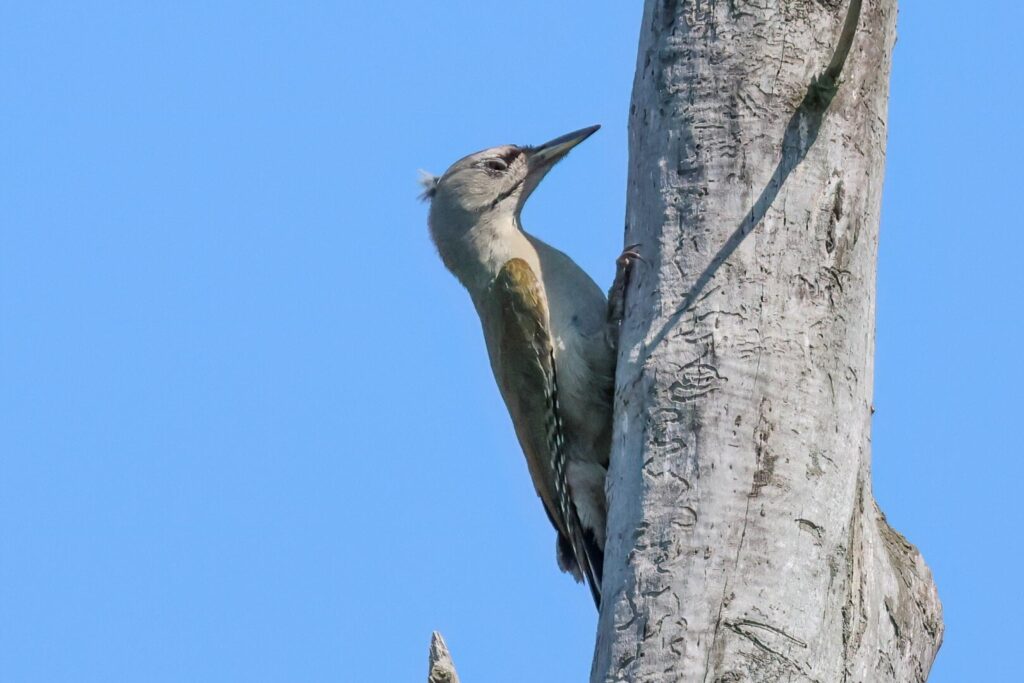
Needless to say, only when most of the group had gone down for breakfast did the Savi’s Warbler come back up again. After breakfast, it was still reeling again so we went back up for another look and this time everyone eventually got to see it. A Penduline Tit called and flew in to the top of the bushes right in front of us too.
When we could tear ourselves away, we set off on the small boat. A Pallas’s Gull flew past over the channel, the first of quite a few of this very smart gull we would see today. We turned onto the smaller channel and hadn’t gone far before we pulled up into the bank. There was a Penduline Tit nest in the willows here and we watched the adults coming in and out with food.
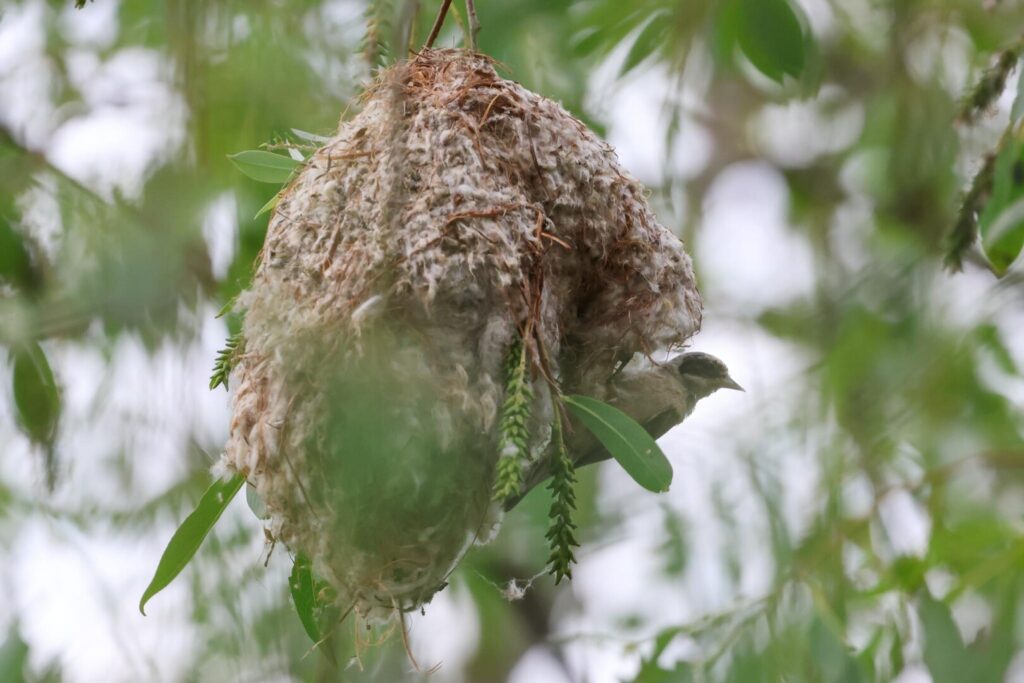
Several Reed Warblers and Bearded Tits were in the reeds in front of us, we could still hear a Savi’s Warbler reeling and a Garden Warbler was singing in the trees behind us. We had seen that many trees around the Delta are completely stripped bare of leaves this year and here we found the culprits – a small willow next to us was covered in Gypsy Moth caterpillars and they were even eating the reeds next to it too.
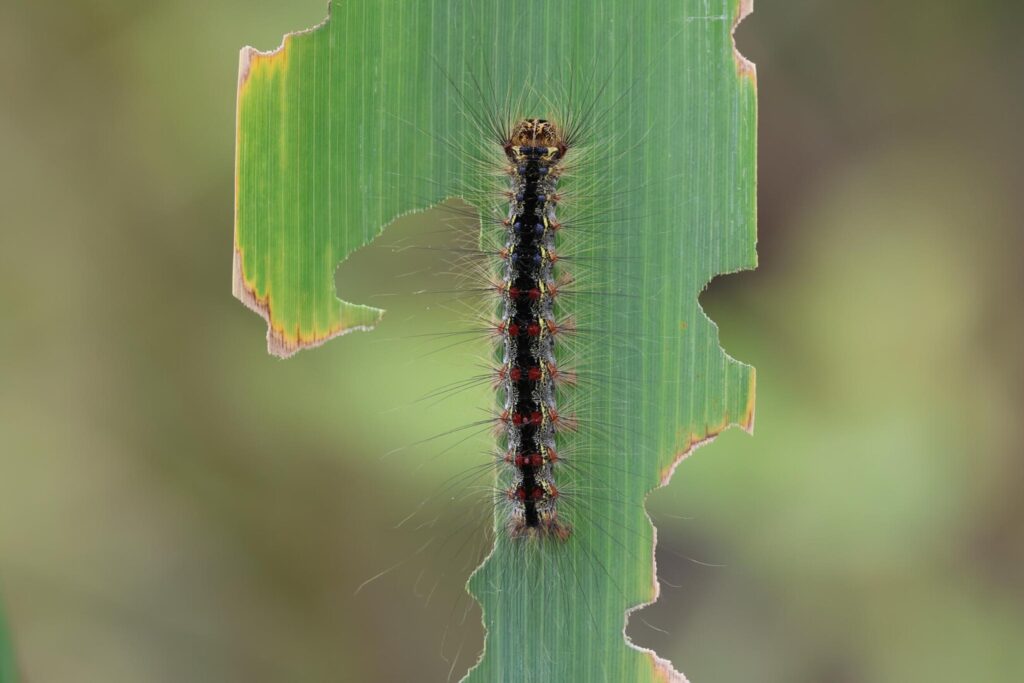
Moving on, we continued up the channel. We could hear Chiffchaffs, Blackcaps and more Garden Warblers singing in the trees and Savi’s Warblers reeling from the reeds, one of which perched on the top on the dry seedhead of a dead reed stem. A Night Heron and a couple of Purple Herons flew out from the reeds on the bank ahead of us and a couple of Squacco Herons were hiding on a patch of lilypads.
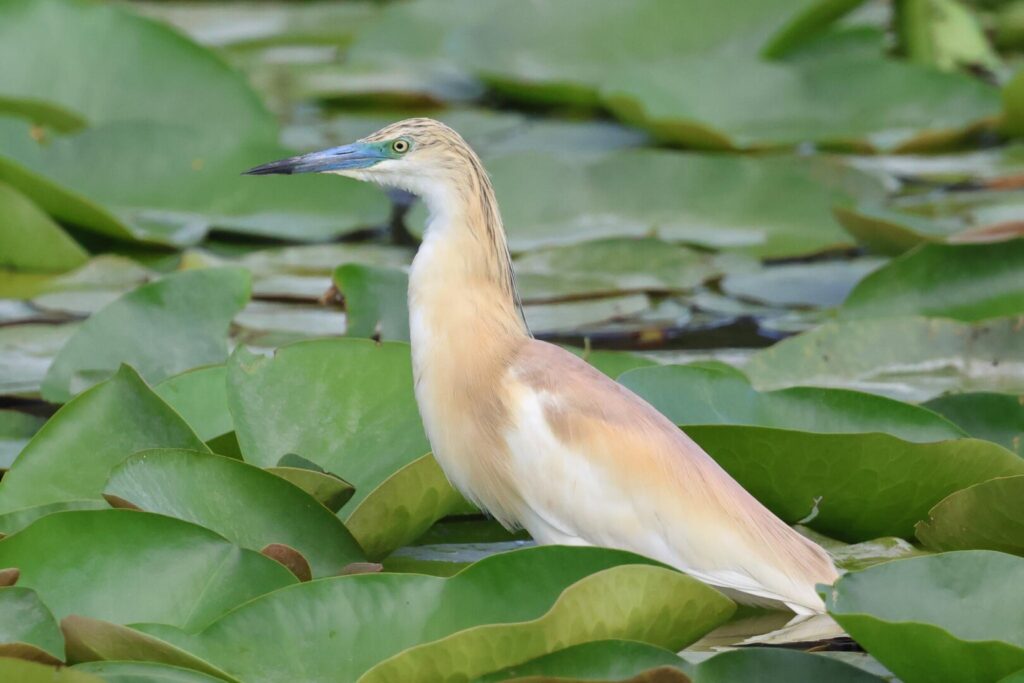
A Hoopoe flew ahead down the channel and landed in the top of a dead tree and two Golden Orioles flashed between two willows but then doubled back out behind us as we passed. A Hobby was perched on a dead branch on a tree on the side of the channel ahead of us and let us get quite close before it eventually flew. Several Marsh Harriers quartered over the reeds.
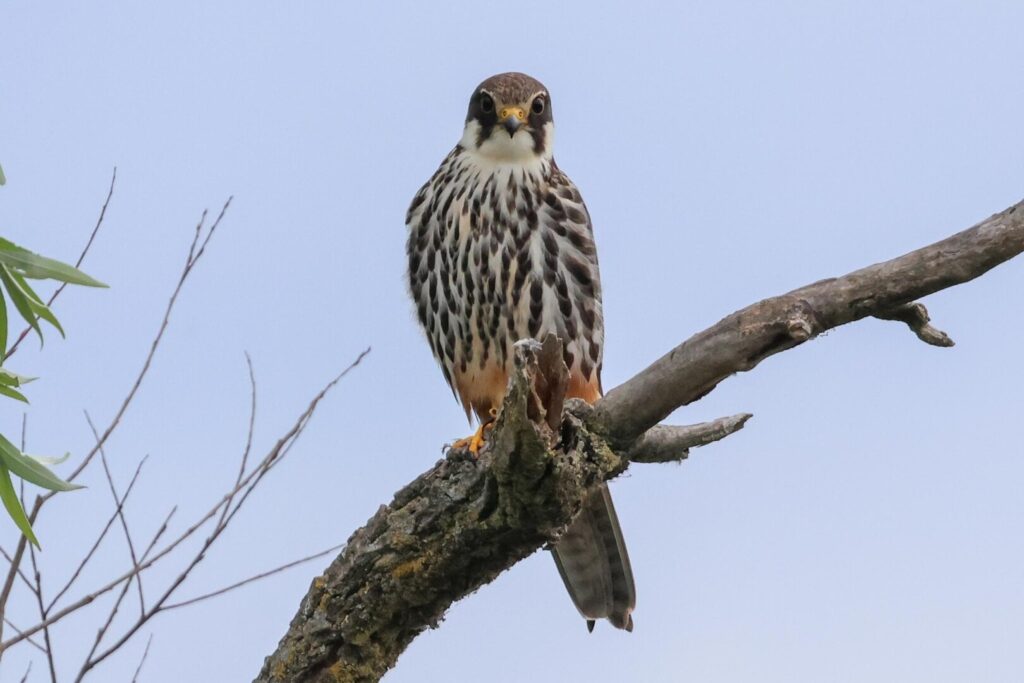
When we got almost to the village of Letea we pulled up to a jetty and got out. Several Sand Martins were flying round over the channel and there seemed to be Bee-eaters all around. We walked over and up onto the low flood bank which surrounds the village and we followed it round and out across the marshes beyond, where a Hobby hung in the air over a small group of trees above us.
A few people were out fishing on the first grassy pools (it was Sunday!), but a little further up we found more birds. There were Black-winged Stilts, Avocets and Lapwings on the rush-fringed pools here, and a couple of Green Sandpipers flew up calling but landed again so we could get them in the scope. A Eurasian Curlew flew over. We could hear Yellow Wagtails calling and eventually saw several perched, the males both of the Romanian intergrade form ‘dombrowskii’ again, with greyer heads and white supercilia.
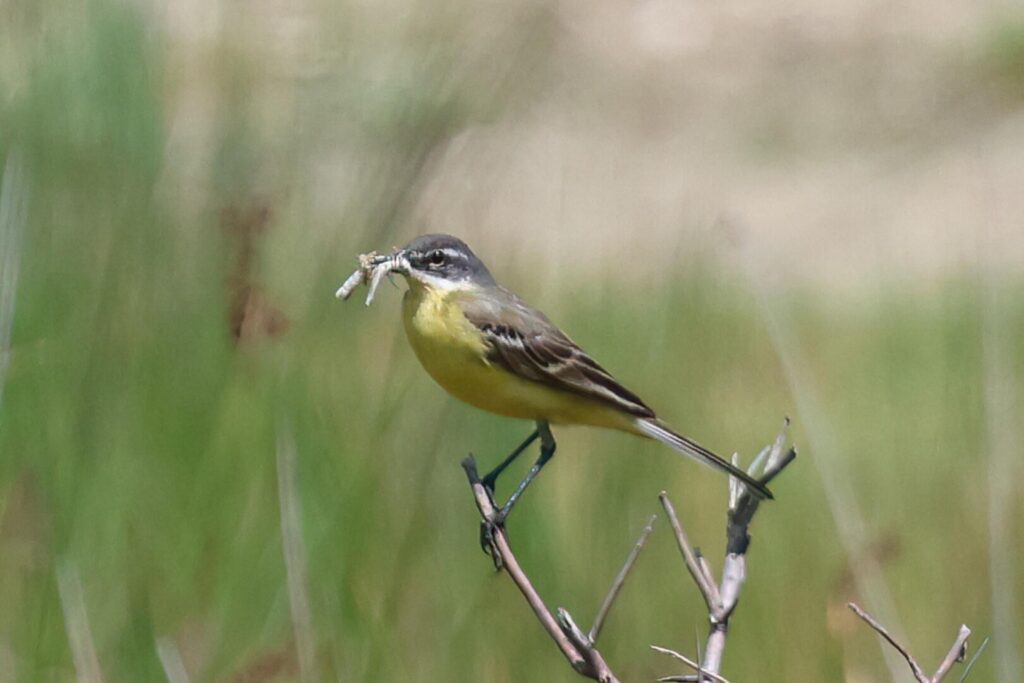
There were lots of dragonflies and damselflies around the bank, a smart weevil on a thistle and several butterflies including a Swallowtail which flew across and landed on some wet tyre tracks across the drier mud to drink.
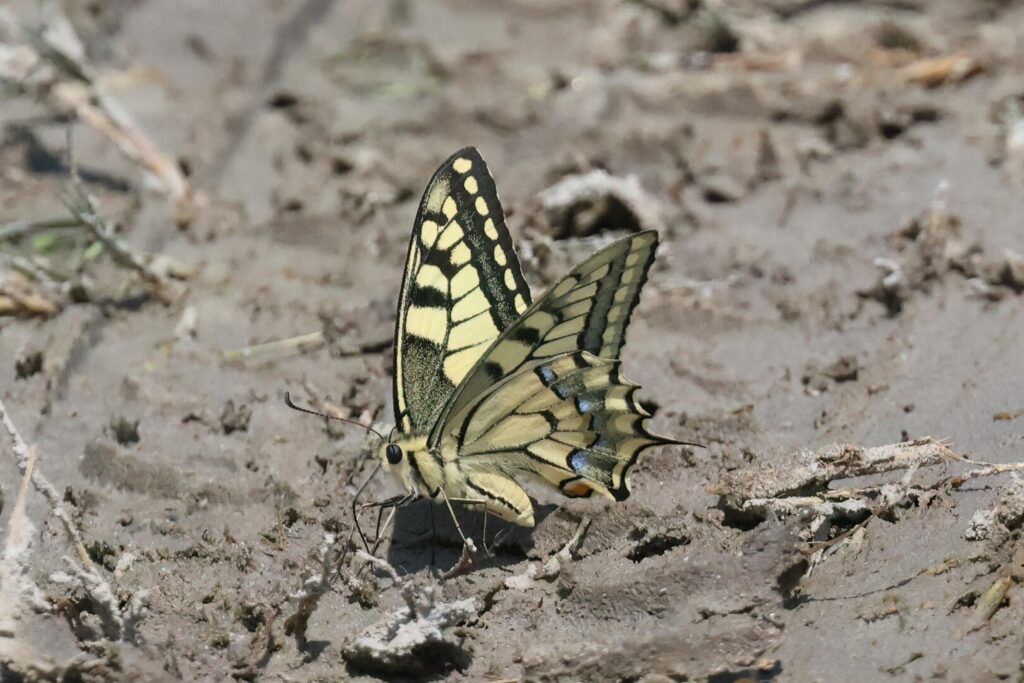
We could see lots of Pallas’s Gulls and Caspian Terns on the grass behind the large brackish pools further up so we walked on for a closer look. There were at least thirteen Pallas’s Gulls at first, with more Caspian Gulls for company, but they all kept flying round and a few drifted off each time. From closer up we had some really good views of them through the scope now.
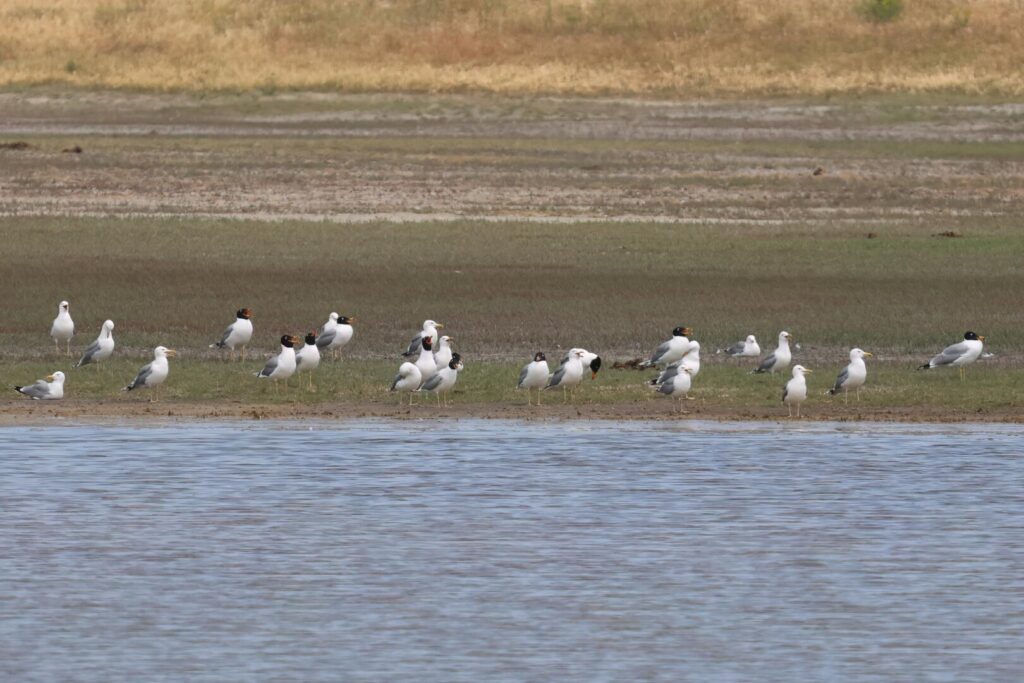
There were twenty-nine Caspian Terns too, loafing in a group in the shallows with a few Black-headed Gulls and a small group of Black-tailed Godwits.
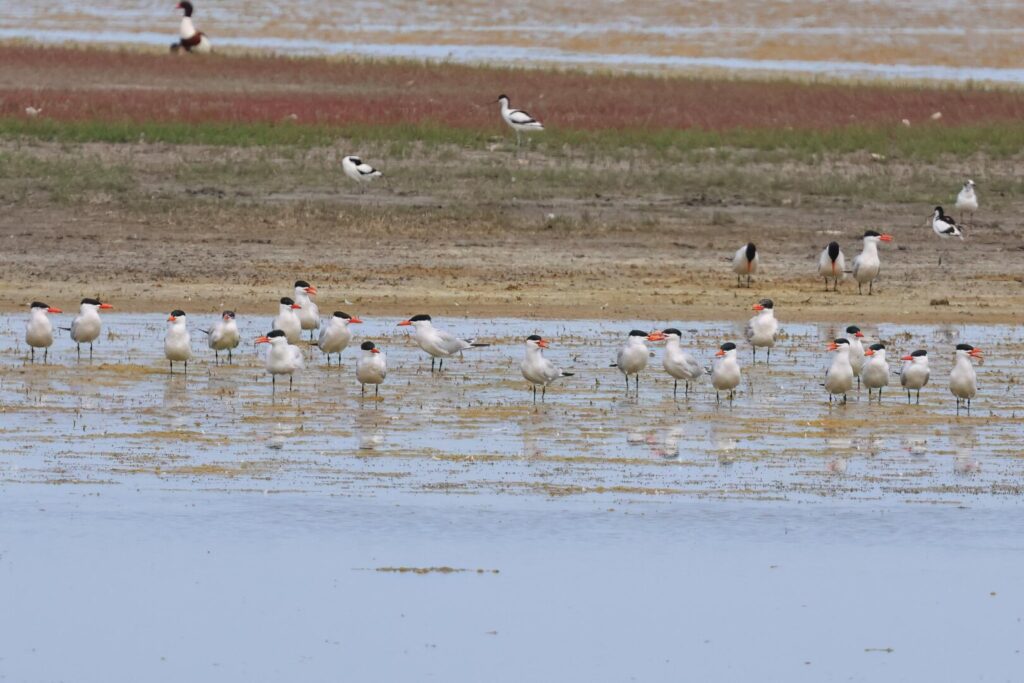
Five Little Gulls much closer to us swimming on the water were all 1st summers. Scanning the muddy margins of the pools we found a nice variety of plovers – a small group of Ringed Plovers which looked like northern, tundrae-types, several Little Ringed Plovers including a pair with three juveniles, and a few Kentish Plovers too. The latter were distant at first, but then we found a closer male with the Ringed Plovers which we had a much better view of through the scopes. We eventually found three Little Stints as well.
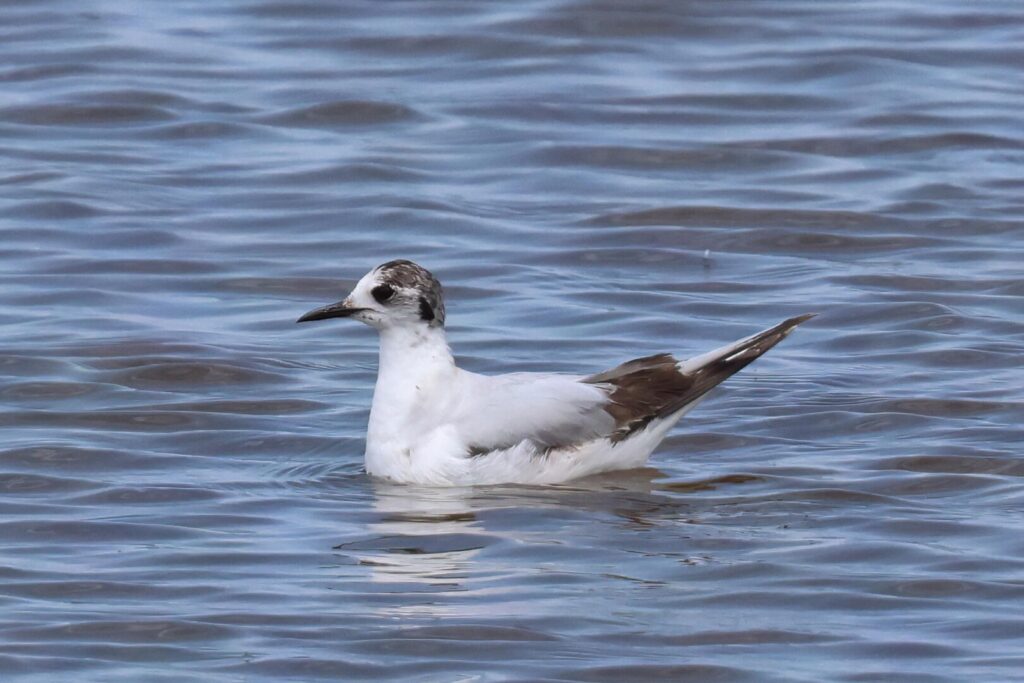
Several Collared Pratincoles were commuting back and forth overhead between the low saltmarsh vegetation round the pools here and out on the short grass distantly the other side of the bank. A lone Ruddy Shelduck was on the water at the far end of the pool. An adult Red-necked Grebe and a juvenile appeared briefly on a small pool in the rushes just behind us.
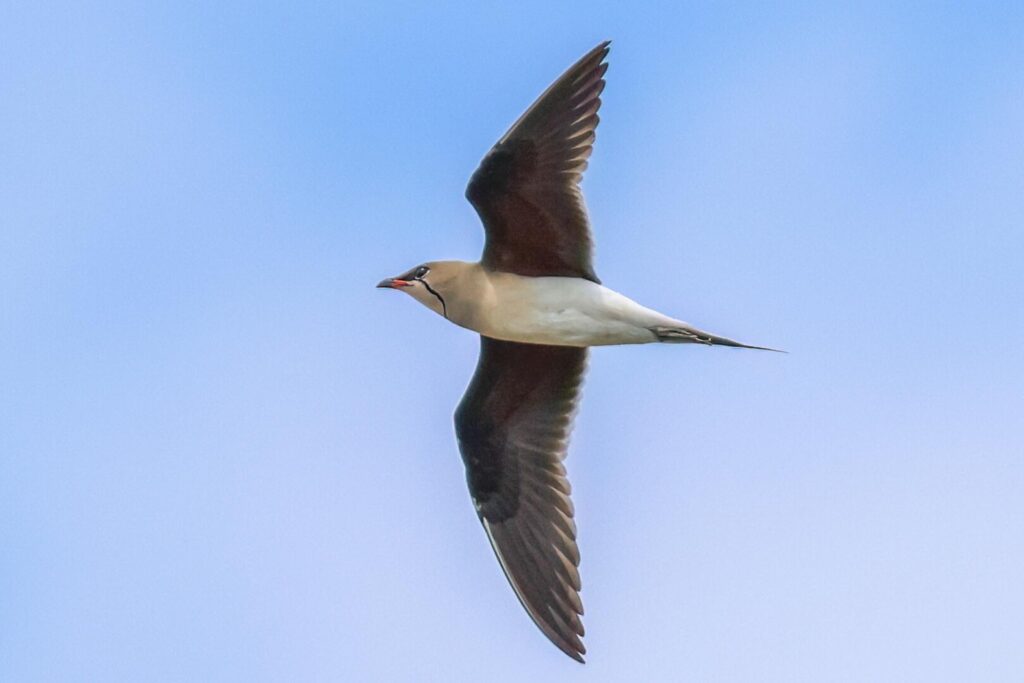
It was getting hot now so we were glad not to have to walk back. We were picked up from here by a ‘Mad Max’ style homemade 4×4 truck and driven in air-conditioned comfort (it was open-sided and very bumpy!), back to Letea and through the village down to the quay. The White Storks were on their nest and lots of Bee-eaters lined the wires in the village.
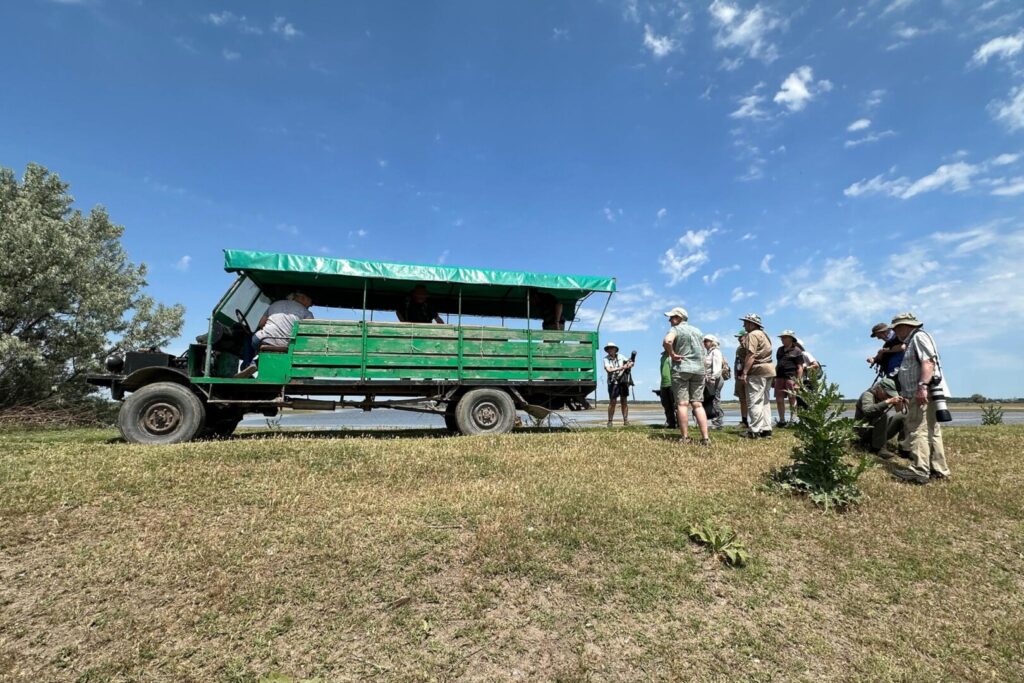
Back on the boat, we had our coffee and biscuits rather later than usual, as we made our way back down the channel. There were more Penduline Tits calling in the trees and we hadn’t gone far before we spotted a pair of Red-footed Falcons in a willow, the female on an old crow’s nest. A Hobby flew in to the other side of the tree and when the female Red-footed Falcon flew out, it set off after it and took a swoop at it. A second Hobby was still in the tree and we could see another old crow’s nest that side too. Clearly the neighbours are not getting on well.
Back along the channel there were lots of Pygmy Cormorants and Ferruginous Ducks, three Dalmatian Pelicans and lots of Cuckoos. A Purple Heron for once did not fly off as we approached. When we got to the floating hotel, still moored where we had left it earlier, it was time for lunch, which we felt like we had properly earned today after our walk. The Grey-headed Woodpecker called again in the trees outside while we ate.
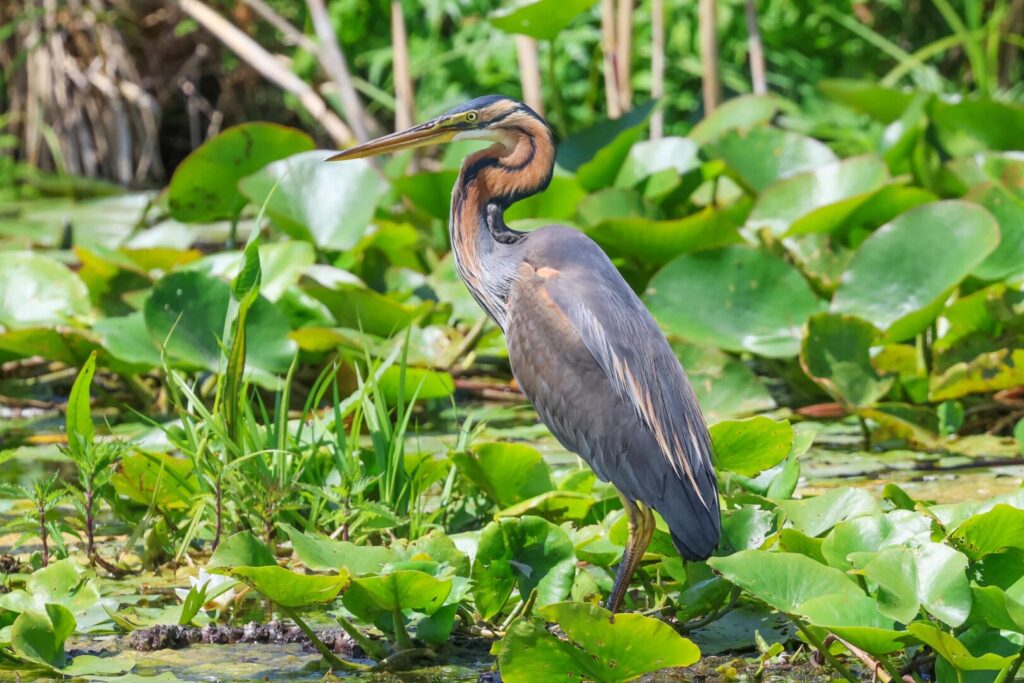
After lunch, the tug pulled the floating hotel out from the bank and we set off in convoy along the main Old Danube channel. A White-tailed Eagle flew out over the water in front of us, landed in a tree on the bank, took off again and was promptly chased off by a Marsh Harrier which looked tiny by comparison.
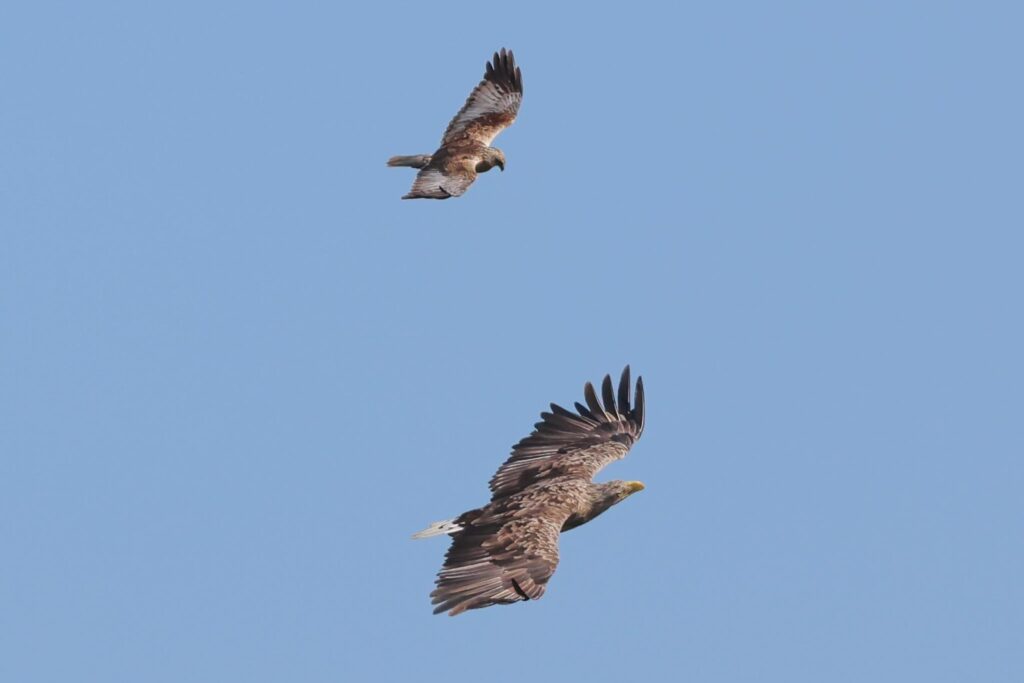
After a while, we transferred to the small boat and set off on our own ahead of the hotel. As we turned off onto the narrower Bogdaproste channel, two Kingfishers flew out of the trees ahead of us, as did another White-tailed Eagle. When we came out onto the first of a series of large lakes it looked rather empty at first, apart from a few swans and Great Crested Grebes, with a fresh wind blowing across.
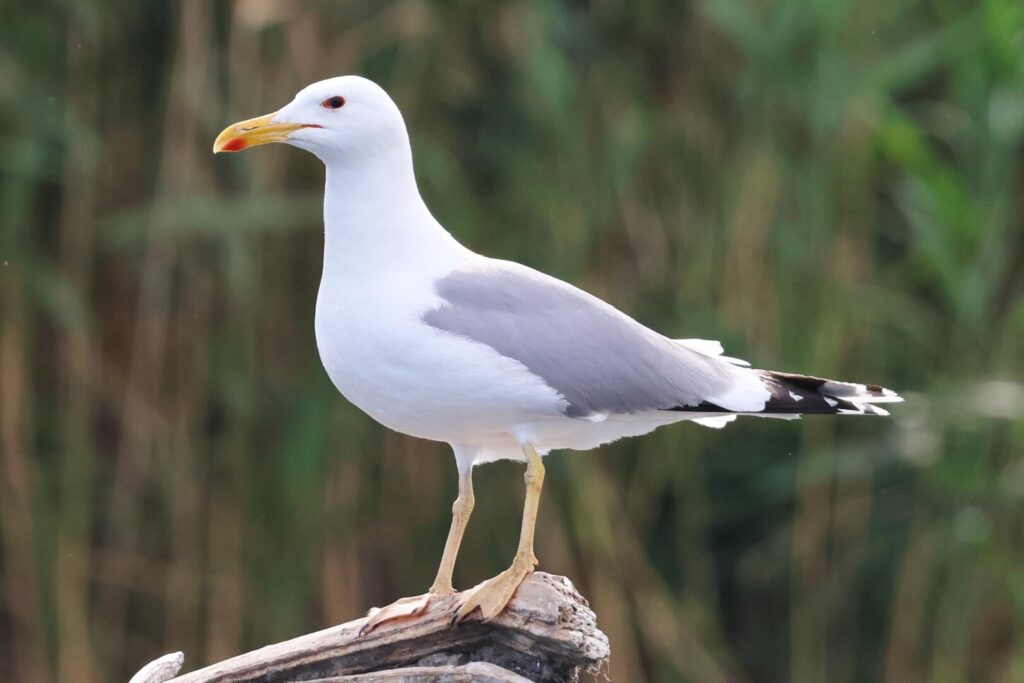
Over the far side, there seemed to be a bit more activity, with several gulls hanging around the White Pelicans, presumably hoping for scraps. When we got over there we found there were several Pallas’s Gulls on the water with the Caspian Gulls. One Pallas’s Gull let us drift up quite close before it finally took off, allowing us some great views, and while we were watching it a Black Tern flew right past us, occasionally dipping down to the water’s surface to feed.
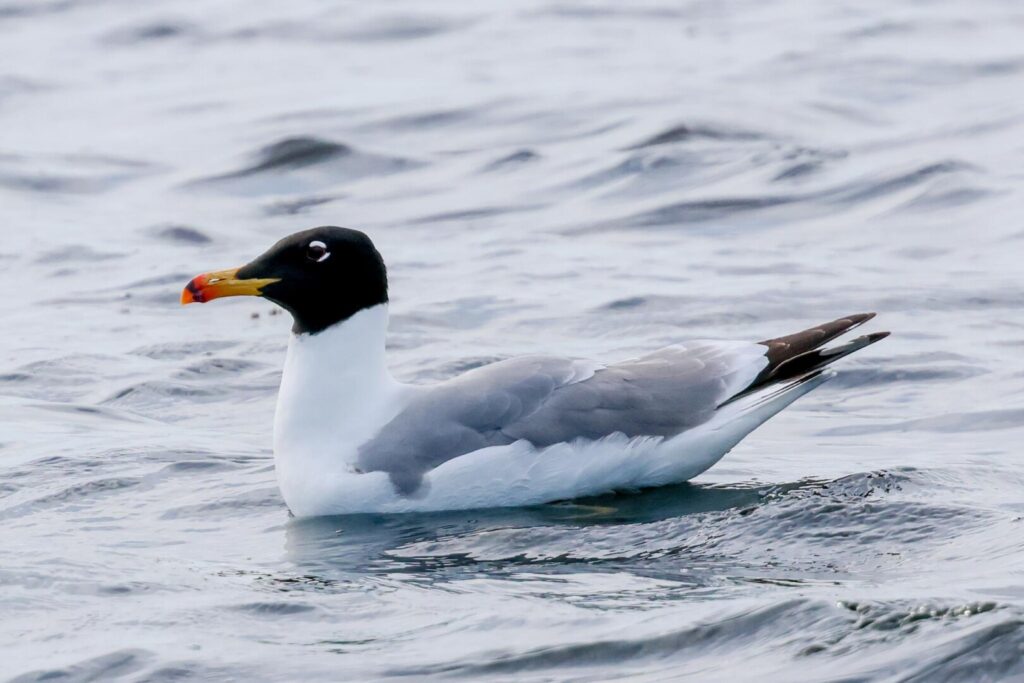
Through the next channel and out into another lake, we found several more Black Terns with the Whiskered Terns dip-feeding out in the middle and more Whiskered Terns over on the far side flying around over the larger patches of weed.
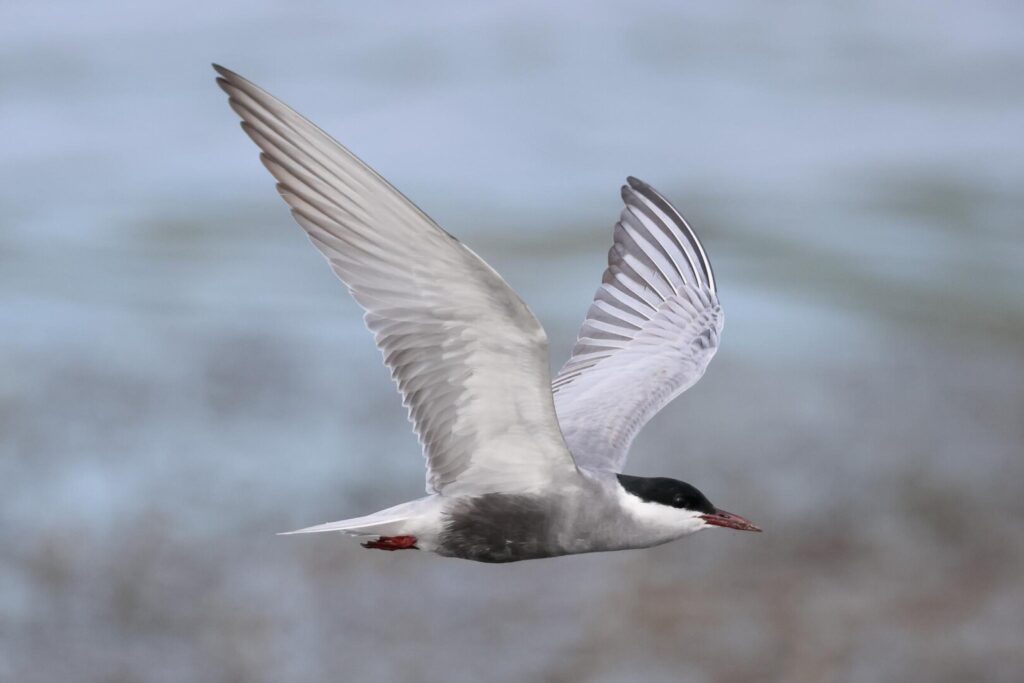
Then along the narrower winding channel beyond, two Little Bitterns were standing up in the tops of the reeds on one side. We slowed down and the male quickly dropped down into the reeds, but the female remained up in the top for longer so we could get a good look at it. Not always an easy bird to see here these days.
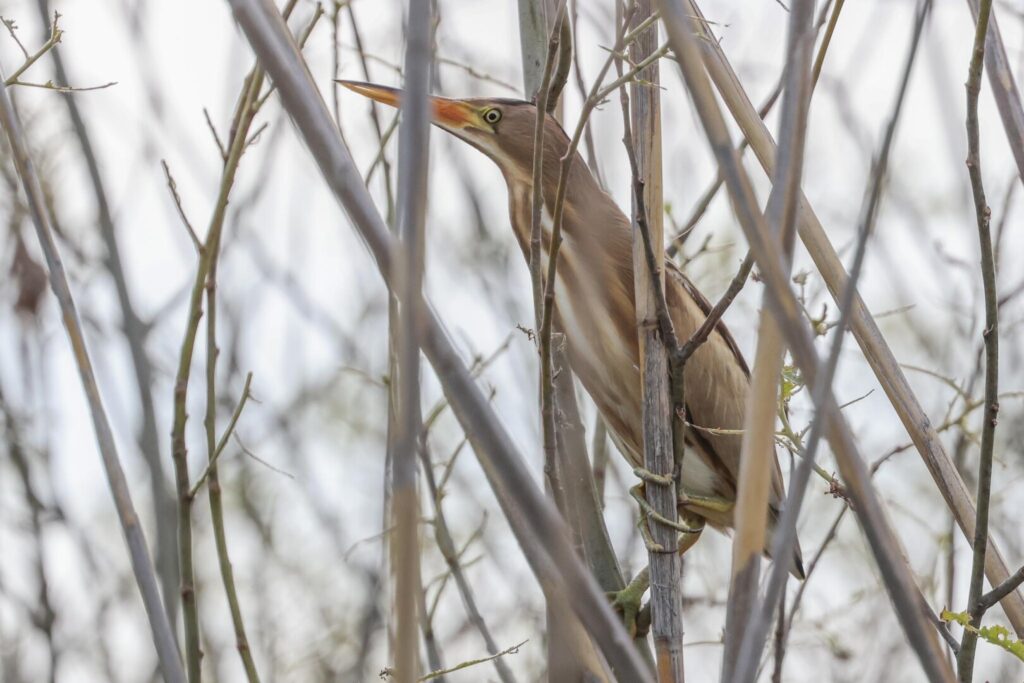
Eventually we found ourselves back out on one of the wider channels again and we turned into a smaller lake which was largely covered with floating waterweed. There were more Whiskered Terns here and at least four more Black Terns. They were mostly feeding over the water at the back, but one did come in much closer over the weed at one point and across right in front of us. There were a few Common Pochard and several Garganey around the edges of the weed, as well as two Little Grebes.
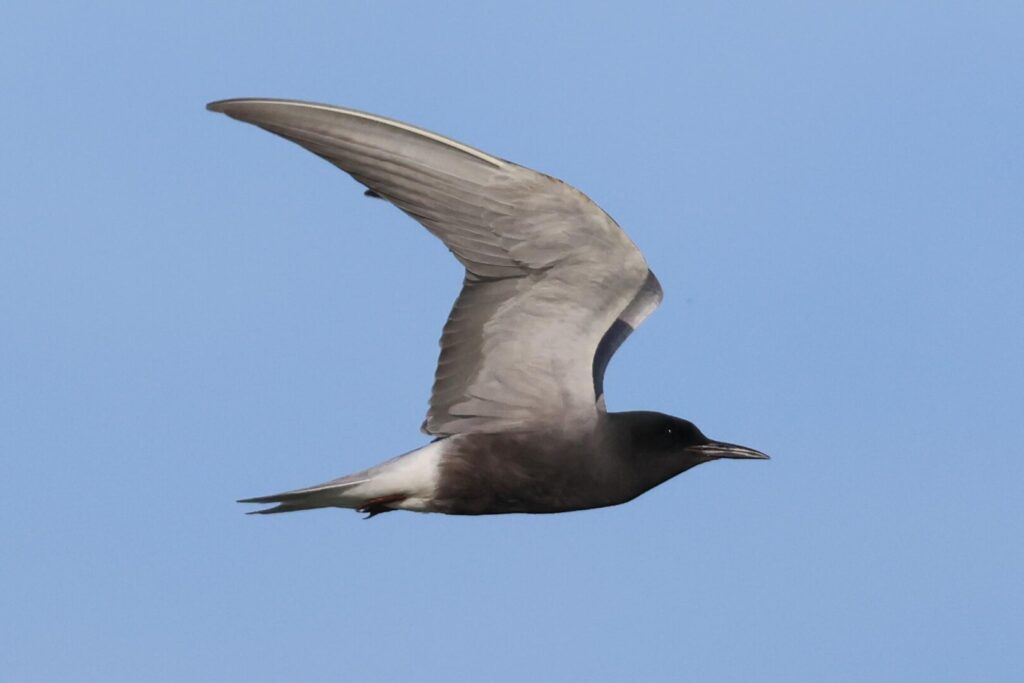
Back out onto the bigger channel, we followed it round for a while before turning off into another lake, this one covered with water lilies. We drifted slowly along the channel through the middle of them, surrounded by terns, mainly Whiskered Terns but with a good number of Black Terns here too. They seem to be a bit late this year, but they were obviously starting to nest, with several on what were presumably their chosen nest places on the lilypads and other pairs displaying. Great to watch.
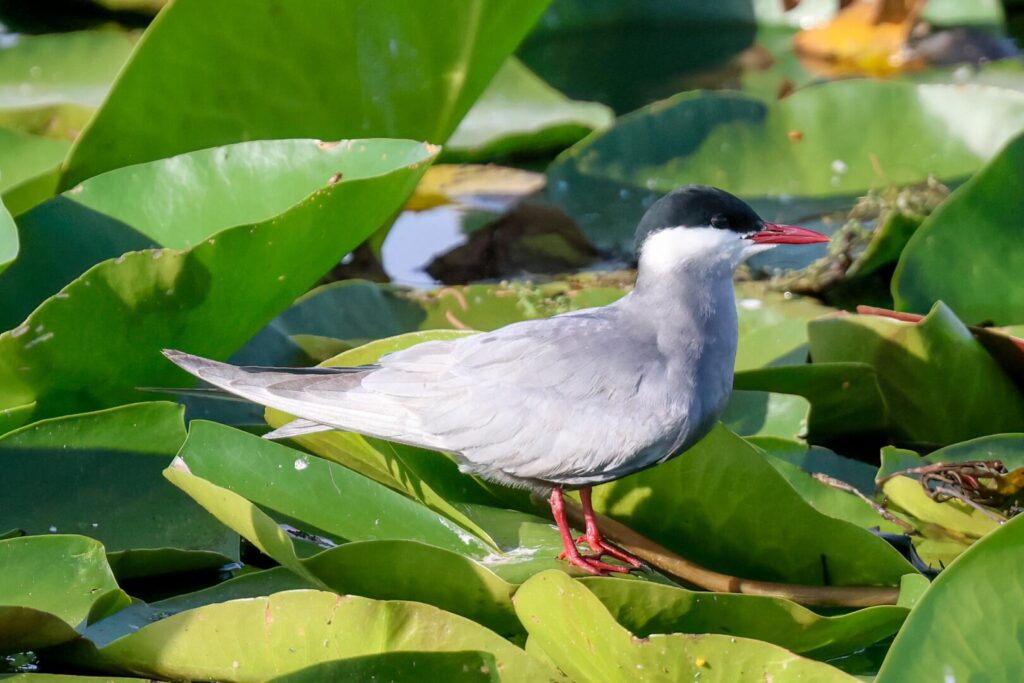
There were grebes nesting here too, with stunning close views of several Black-necked Grebes now and a single Little Grebe on its platform.
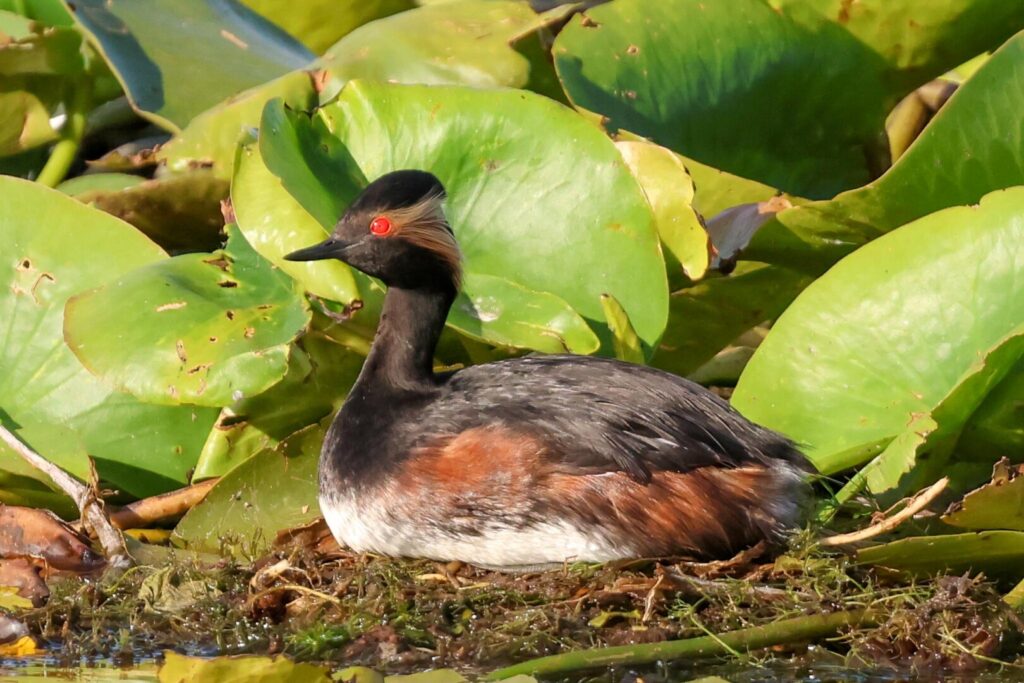
Just when we thought we were going to be out of luck with White-winged Black Tern this year, we picked one up flying through the throng. It came right past and round behind the boat, flying round for a minute or so before disappearing again. A very smart tern indeed.
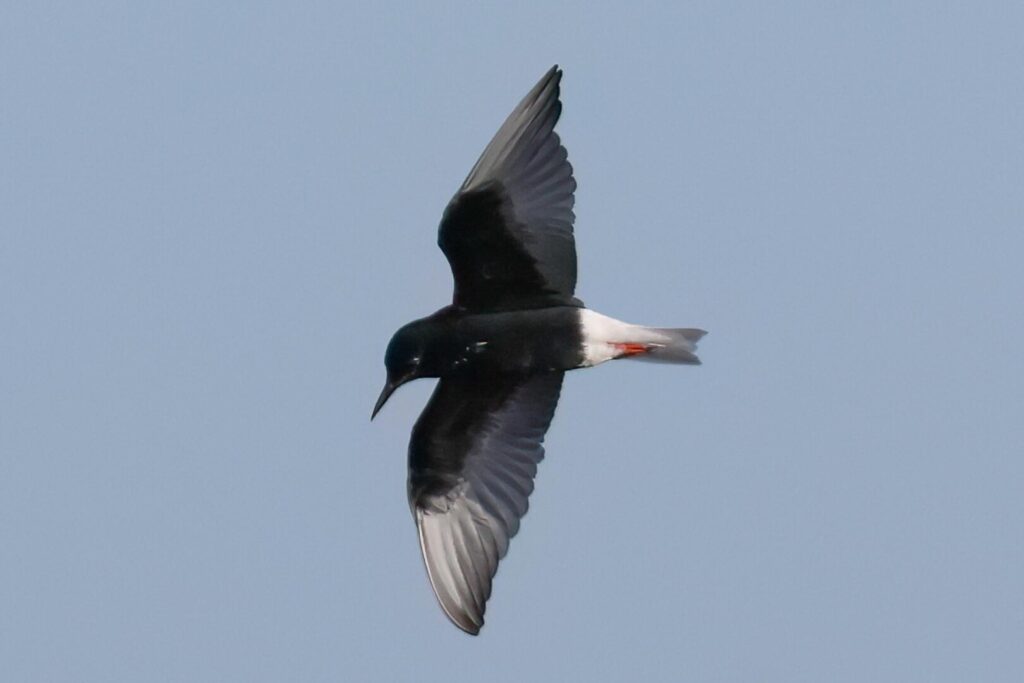
We didn’t want to disturb the terns too much so we left them in peace and turned around, heading back out to the main channel. We motored on a short way and then came round a bend to find the floating hotel moored up next to the bank opposite a large area of lilypads. Several White Pelicans were loafing on some snags in the water and looked stunning in the low late afternoon sun, so we drifted past those on the small boat for a closer look before docking with the floating hotel for the night. After a short break, we met for dinner and watched the sun set over the Delta outside.
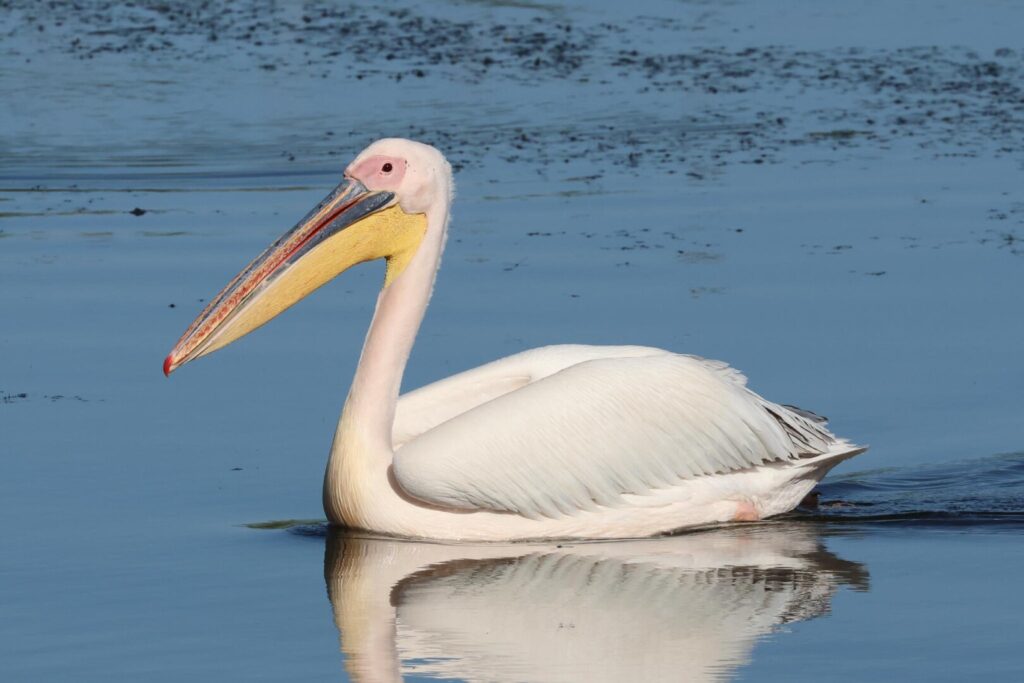
Monday 3rd June
From up on the deck before breakfast, we could hear Bittern booming, Savi’s Warbler reeling, Great Reed Warbler singing and the ubiquitous Cuckoos calling. There were White Pelicans still around the snags and swimming past on the channel and Purple Heron, Night Heron, Squacco Heron and Glossy Ibis on the lilypads opposite. What a place to wake up to!
After breakfast, we set off on the small boat again. A Savi’s Warbler was reeling close to the edge of the reeds so we stopped the boat and had good views of it perched on the top of a reed stem. While we were watching it, one of the group spotted our first Bittern of the morning which flew over the channel behind us.
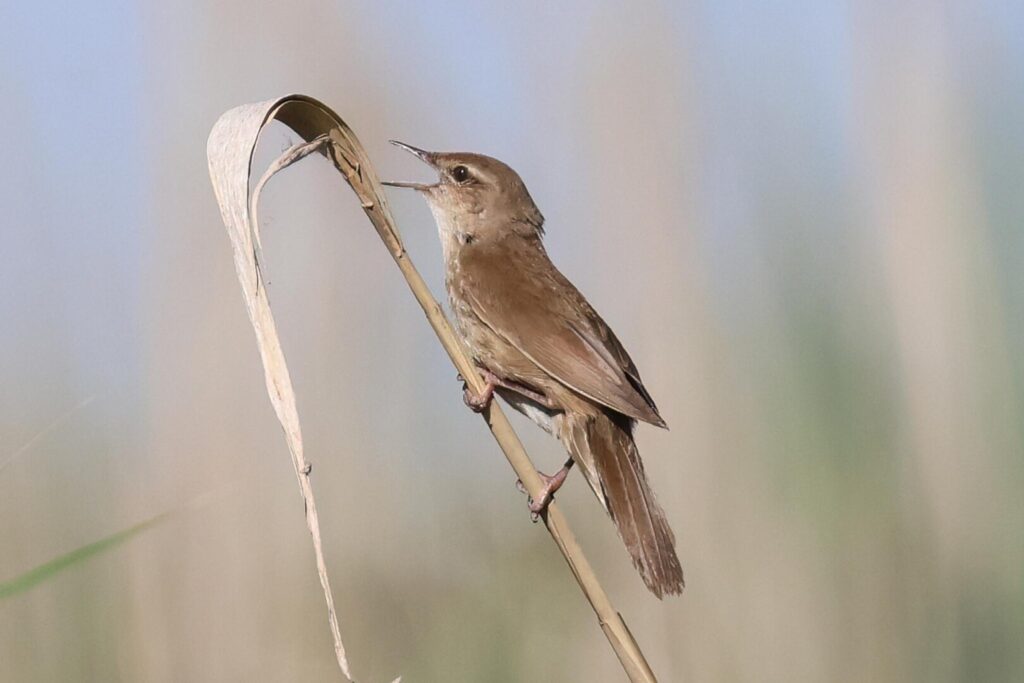
Turning off into a small lake, we found some feeding White Pelicans, swimming in a small, tight group, upending in unison – synchronized swimming!
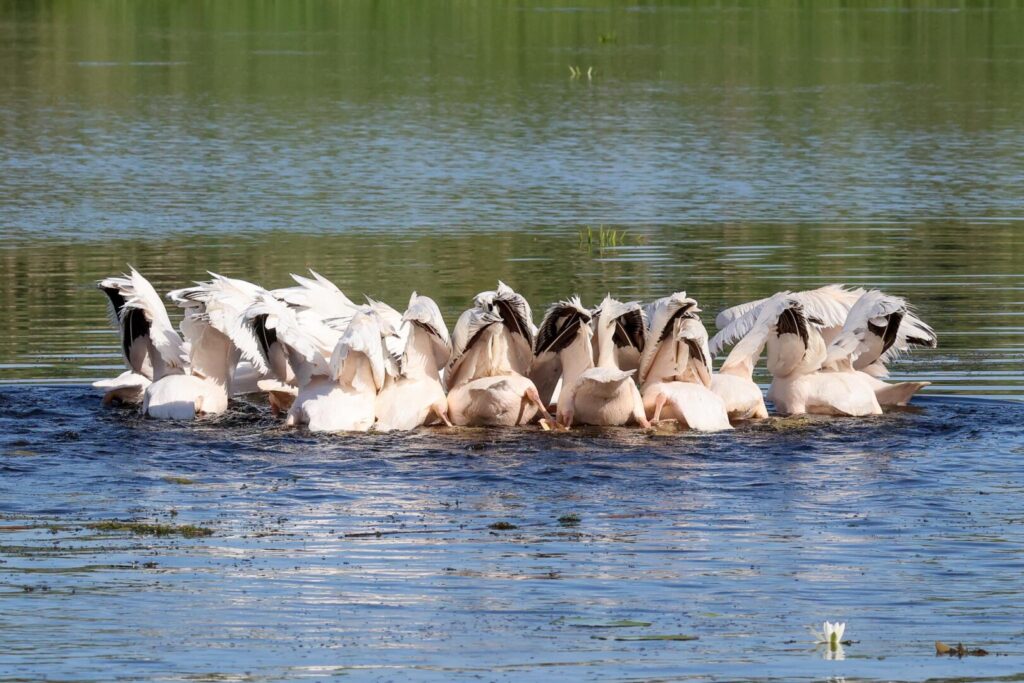
Back out on the channel, we followed it round and from time to time it widened out and the water was flanked by patches of lilypads, where we found several families of Red-necked Grebes. Another Bittern flew round over the tops of the reeds and only a little further on a third Bittern flew low along the channel ahead of us. It landed in the reeds the other side and as we drifted slowly forward we could see it lurking on the edge behind the lower green vegetation in front before it realised it was being watched and ran back further in. Bitterns can be hard to see here but it was obviously our lucky day today.
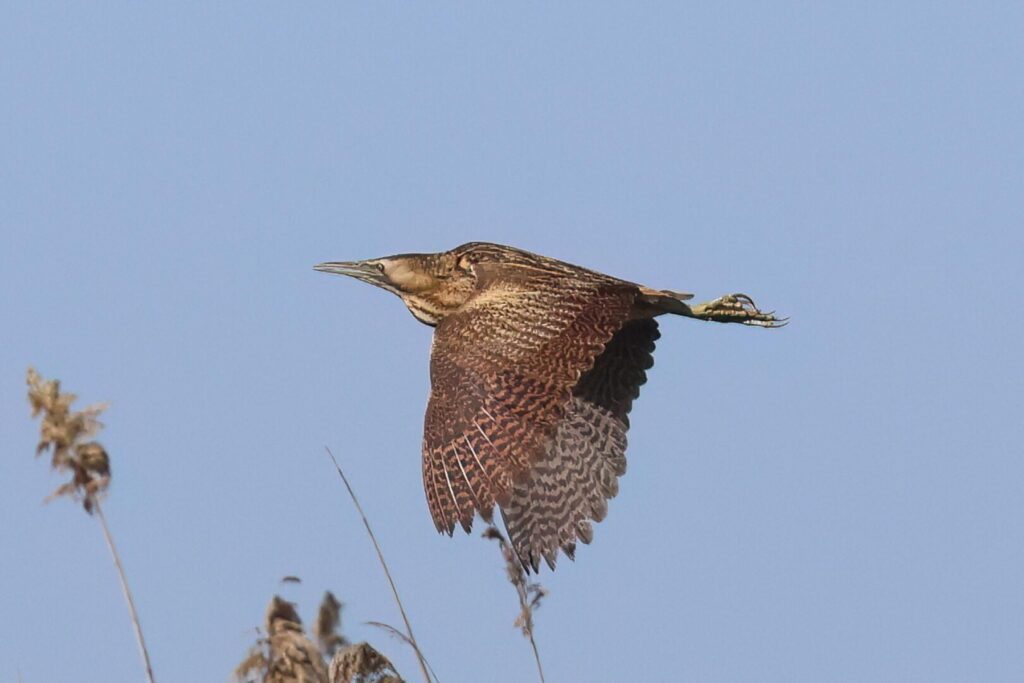
We came out into a larger lake with more lilypads and water soldier where there were more grebes, several Little Grebes as well as Red-necked and Great Crested Grebes. A pair of Garganey flew round and dropped down out of view and a single Greylag Goose was on the edge of the lilypads. We had a better look at this one, with its pink bill a bird of the eastern race, rubirostris, which occurs here. Two adult White-tailed Eagles were perched in a bush together over the far side of the lake.
There were lots of ‘Green Frogs’ here as usual and now Cristian showed us how they can be caught here to eat, using a rod and a red bottle top on the end of the line. The bottle top was remarkably good at attracting them, so they can be netted, although we left them where they were.
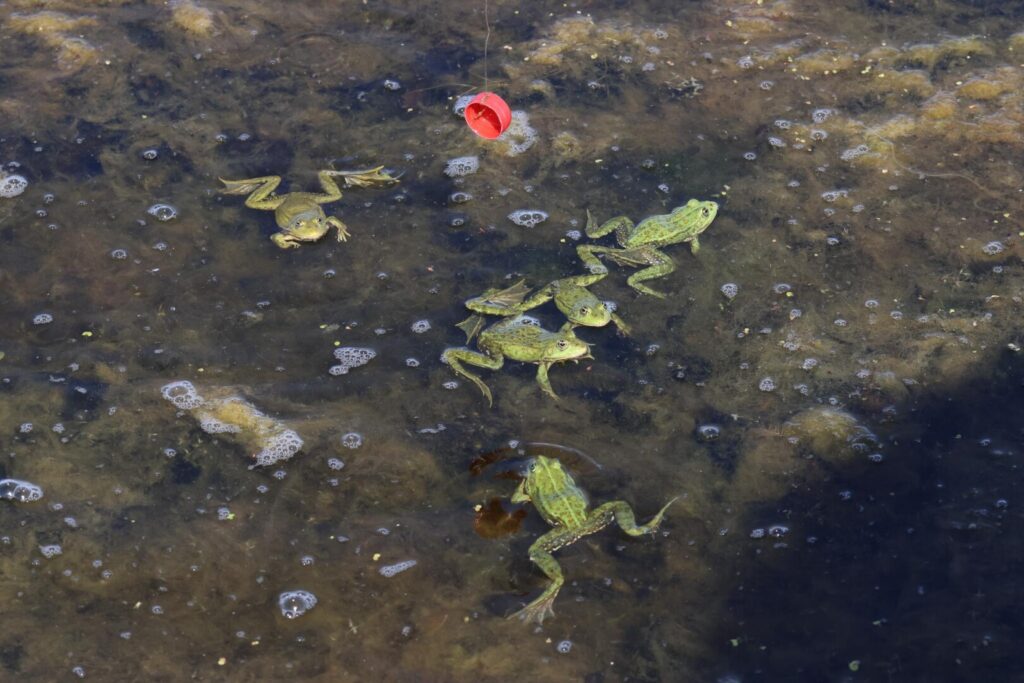
We took a series of channels lined with thicker willows now, where there were Blackcaps, Garden Warblers and Lesser Whitethroats singing. We heard lots of Blue Tits and finally got to see a family flying between two trees, and when we heard a Penduline Tit calling we could see its half-built nest hanging in one of the willows, still lacking the entrance tunnel. A pair of Golden Orioles fluted and flew in and out of the trees and we heard a Lesser Spotted Woodpecker but as usual it remained well hidden.
As the trees thinned out again we could see some telegraph posts, a sign that we were approaching ‘civilisation’ once more and we came out onto a more open channel with some large ruined agricultural buildings just over the bank ahead of us. North of the bank, from here to the Ukraine border, is another large agricultural area which was drained in the Soviet era.
A couple of Kingfishers flew out and low over the water ahead of us as we approached the junction and a Roller swept out of the trees on the corner and round behind. We could see the Roller’s nest hole in the sandy bank so we drifted over to the far side and stopped for coffee to see if it might come back in. It didn’t while we were there, but we were distracted by several Large Chequered Skippers around the flowers along the muddy edge of the channel, several dragonflies and a very small young European Pond Terrapin.
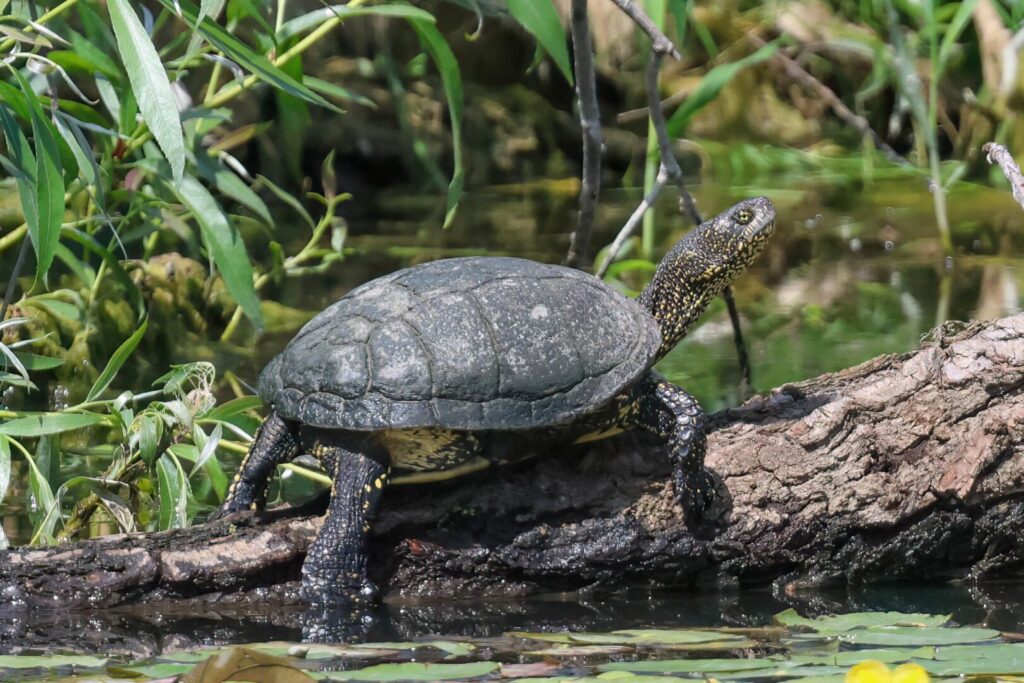
After coffee, we set off again along the channel bordering the agricultural area. There were more Rollers and a few Rooks on the wires and lots more grown-up European Pond Terrapins along the edge of the water. A rufous or hepatic morph female Cuckoo flew over pursued by a male.
We could hear several Eastern Olivaceous Warblers in the dense false indigo bushes growing on the bank and they remained well hidden but a Sedge Warbler singing was more obliging and perched in the top of couple of the bushes and launched up into song flight a couple of times. A young male Red-footed Falcon was hawking for insects overhead as we sailed along.
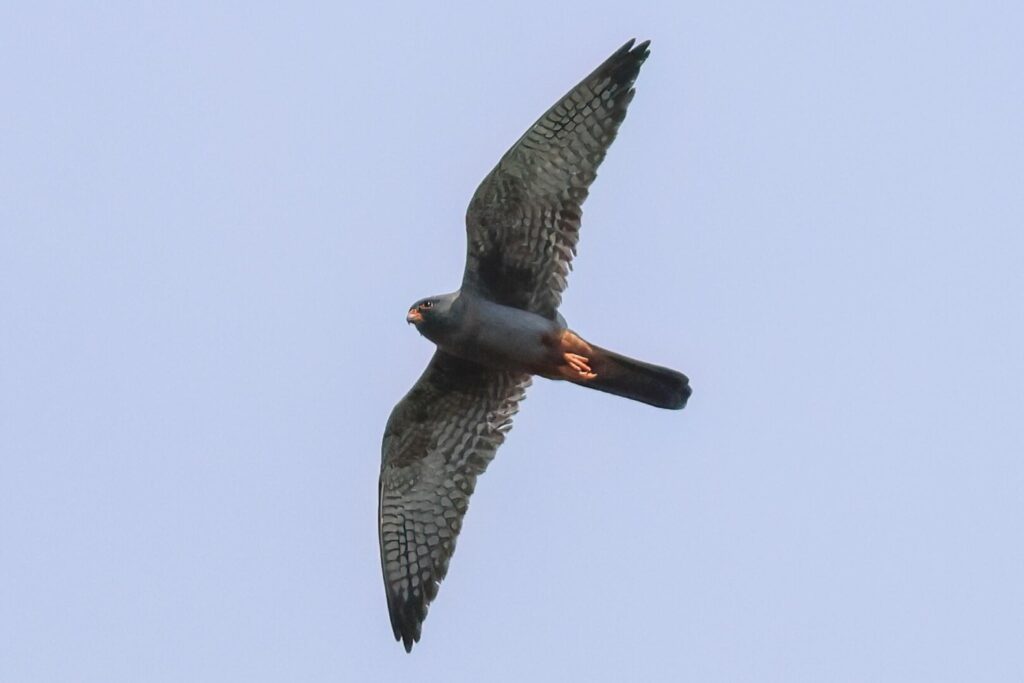
After a while, we turned off away from the agricultural area, back down through the reedbeds. The trees at first were all dead, burnt a few years ago by fishermen trying to clear the banks. It means there are plenty of nest holes, so there were lots of Rollers perched in the branches along here. A male Redstart was singing and flitted in and out flashing its red tail. A Grey-headed Woodpecker was perched up in one of the trees and flew back behind us.
Further down, the next channel had been dredged not that long ago and the more open muddy banks with shallow margins behind were obviously good for waders – we flushed two Green Sandpipers which flew up calling and a couple of Glossy Ibis were feeding on the edge of the reeds. Two Muskrats swam out in front of us, the first dived straight away but the second stayed up a little longer before it disappeared, giving people time to get onto it first.
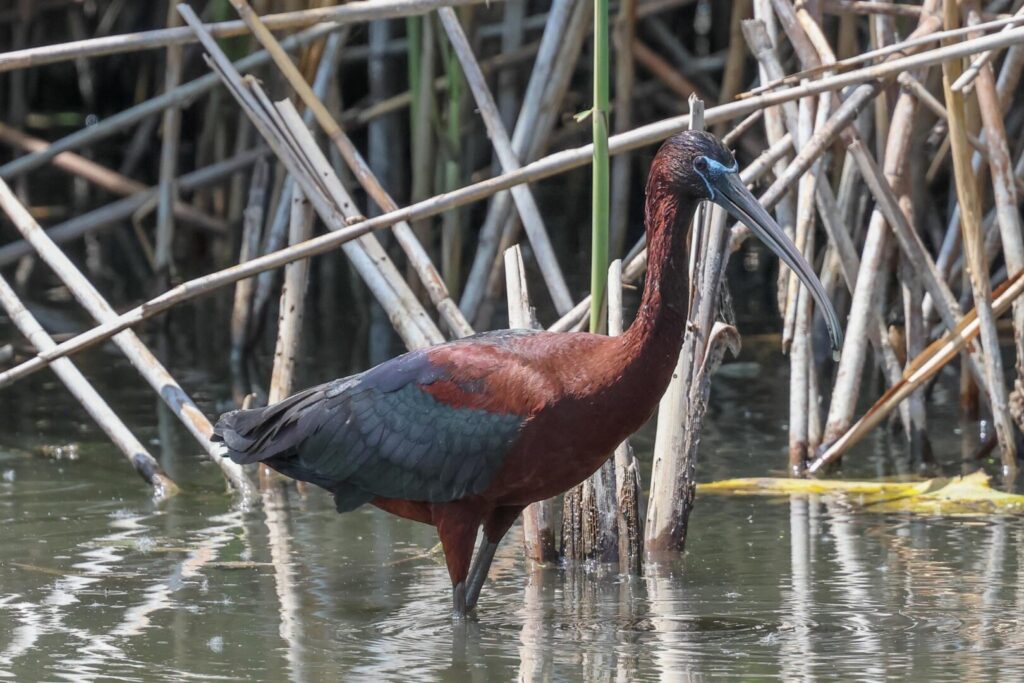
We came out onto a much wider and more open channel flanked by reeds. It was getting hot now and there were fewer birds along here. An old Black Woodpecker hole in one of the willows on the edge of the channel was unfortunately as close as we got. We didn’t have very far to go before we could see the floating hotel tied up on the edge of the channel waiting for us, having been towed here while we were out on the small boat.
We swapped over to the floating hotel and while we were sitting down to lunch we were towed out into the channel and set off on our way back to Tulcea. Gazing out of the windows while we ate, we had a good view of the extensive reedbeds as they passed on either side. A White-tailed Eagle was perched in one of the trees at eye level. After lunch, some of the group went out on deck while others preferred to stay out of the heat inside, in solar powered air-conditioned comfort.
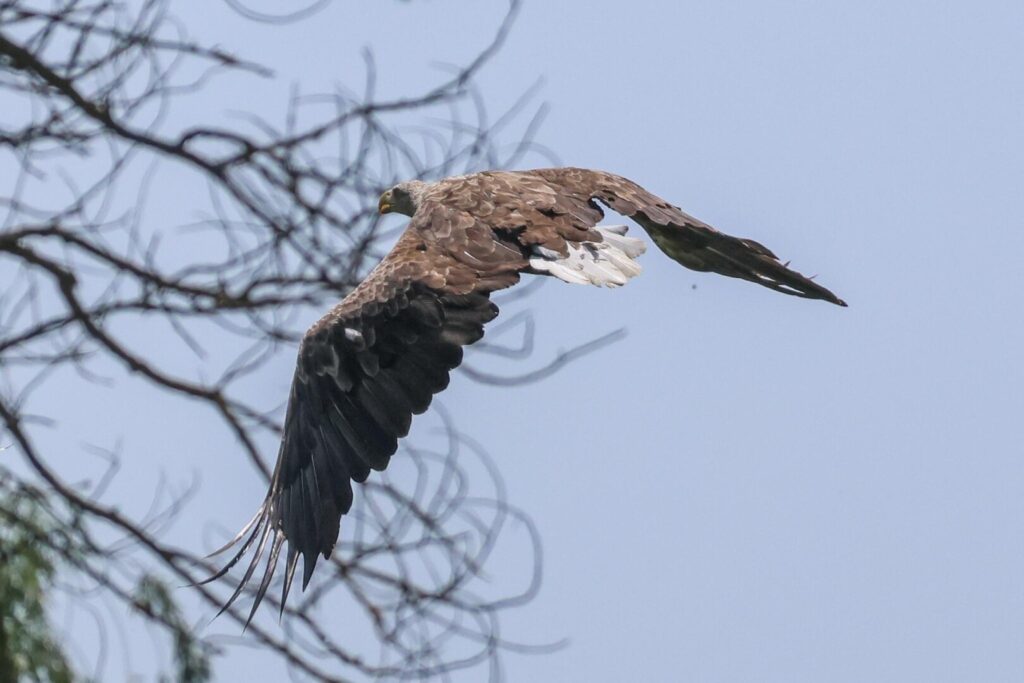
Another pair of White-tailed Eagles flew out of the trees ahead of us. The banks here are lined with Slender-leaved Willows, the larval foodplant of Freyer’s Purple Emperor butterfly, and we saw one or two around the trees but it was a little too hot for them now.
Eventually we got back to Tulcea. We still had some time before dinner, so we went for a short walk up through the edge of the town to the monument on the hill. There were lots of ripe mulberries on the ground under the trees in the pavement and on a couple of short trees which had been pollarded we found some to try – delicious! The Jackdaws here are of the eastern race, soemmerringii, with a more noticeable pale half collar, and there were plenty of them on the roofs of the houses giving us a chance of a closer look.
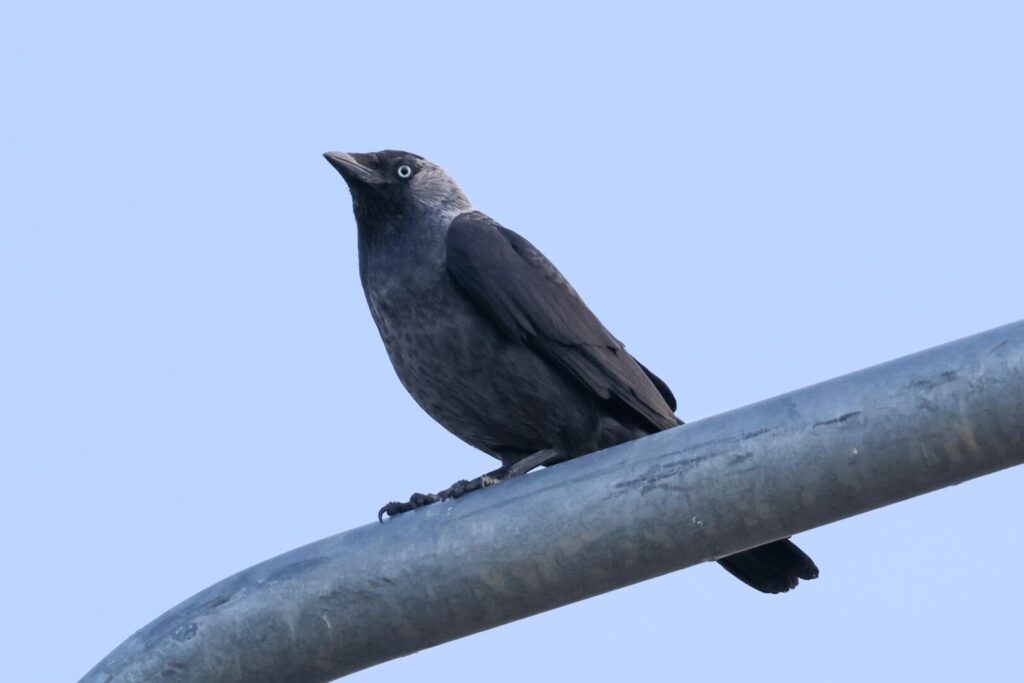
The monument is surrounded by a small park with a few trees and we were hoping we might find a Syrian Woodpecker but when we got up there the wind had picked up and it was too strong. A couple of Common Swifts flew past and there was a great view over Tulcea, the Danube and out towards the Ukrainian post of Izmail in the distance beyond. We made our way back down to the quay and onto the floating hotel for our last dinner, which was rounded off with enormous slices of a lovely cake baked for us and glasses of sparkling wine.
Tuesday 4th June
After breakfast, we packed up and said our goodbyes to the crew on the boat who had looked after us so well on the last few days. The minibus was waiting on dry land, so we walked over the gangplank and got onboard for the drive back to Bucharest.
Once we got out into the countryside, we started to see a few more birds. There were a couple of Skylarks hovering over the fields and Corn Buntings on the bushes on the verge. A Honey Buzzard circled up in front of some tree-covered hills. We had a very brief view of a Calandra Lark which flew up from the side of the road but unfortunately we were past it almost as soon as we saw it and there is nowhere to stop or turn around here. Only one of the group managed to see it before it was gone.
We started to see flocks of Rooks in the fields as we neared their rookery and the bus slowed as it climbed the steep hill through the trees so we could see several Red-footed Falcons circling with them. The falcons will use the old Rook nests themselves once their original owners have finished with them. A little further on, we turned off onto a side road. As we passed a large marshy area we could see lots of egrets and a couple of Grey Herons and on the edge what looked like a couple of adult Ruddy Shelduck and a large creche of juveniles were asleep on the grassy bank.
We stopped at the top of a track which led down through a gap in the ridge below and got out for a short walk. There were lots of Bee-eaters in and out of the sandy cliffs on the side of the track, perched on the bushes and calling as they flew round. A Suslik ran across the bottom of a low sandy bank nearby and in to one of the holes, before coming out again a little later. A Long-legged Buzzard flew past, followed by a second which was mobbed by a Hooded Crow.
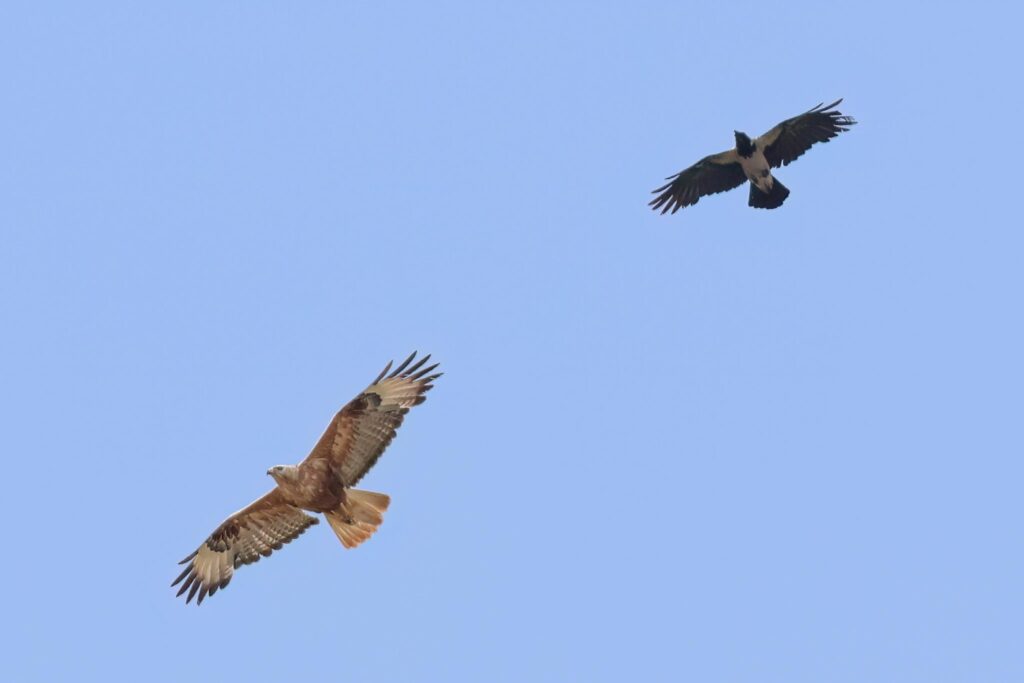
A couple of Rollers flew round calling, a Marsh Harrier quartered over the fields the other side of the road, and a Dalmatian Pelican and a couple of White Storks circled up beyond the ridge. We walked over to the top of the ridge here there was a fantastic view out over the countryside below. A male Northern Wheatear was perched on the ridge further along, there were several Tree Sparrows in the bushes below and now a White Pelican drifted over.
Cristian found a Little Owl hiding in one of the old Bee-eater holes on the sandy cliff face opposite now – better views than the pair we had seen earlier in the week. While the group were watching that through the scopes, a dark morph Booted Eagle drifted across and circled out in front of the ridge, followed by a pale morph which circled below us in from of the ridge face.
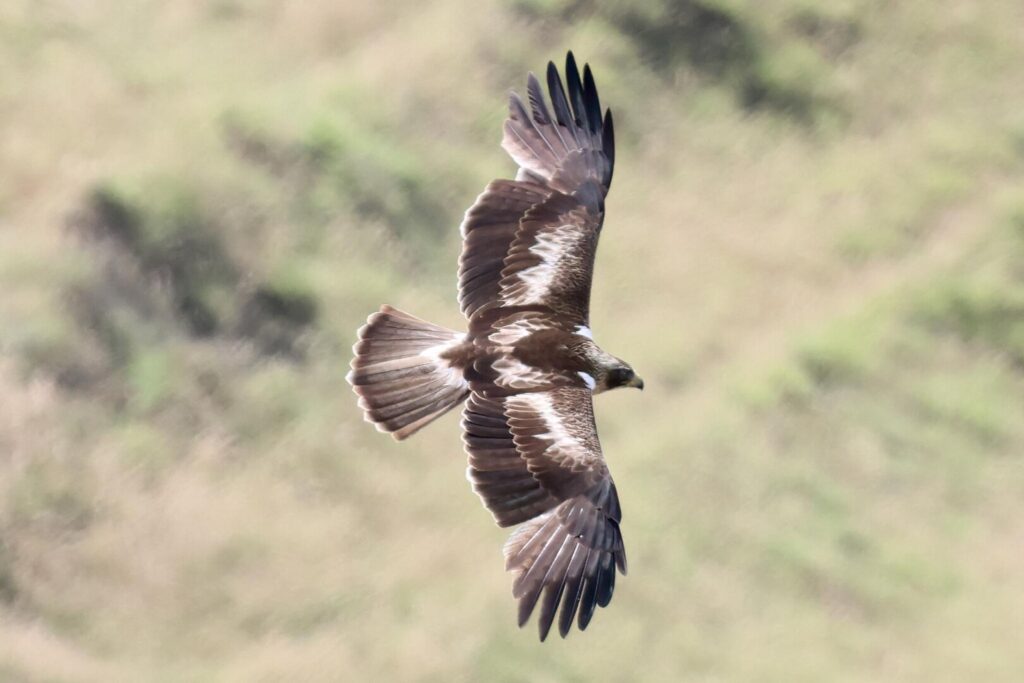
Unfortunately it was time to move on again, as we still had a long drive to Bucharest ahead. We had a quick stop at a filling station to use the facilities, where several Green-veined White butterflies were fluttering around the short grass on the verge, and then a longer stop to eat our packed lunches at another filling station about an hour or so further on. We arrived at the airport in good time and bid farewell outside to Cristian and two of the group who were staying on for a few days in the mountains. Inside the terminal, we had an opportunity to pack away our binoculars and use the facilities before the Ryanair check-in finally opened just as we walked up to it.
The plane was boarded in good time but then spent some time waiting on the apron so we were about fifteen minutes late taking off and similarly tardy on our arrival at Stansted. There was a long queue for the e-gates at immigration again – there just aren’t enough of them – but at least our bags were waiting for us on the carousel when we eventually got through. Then we said our goodbyes and headed out into a typically cool and damp English summer evening.
















